Frequency of Training and Perceived Benefits
VerifiedAdded on 2019/12/28
|69
|19869
|177
Essay
AI Summary
The provided content appears to be an assessment or survey about training and development programs in the workplace. It asks various questions about frequency of attending training, effectiveness of different types of training, and perceived benefits. The questionnaire covers topics such as employee satisfaction, team building, and on-the-job vs off-the-job training methods. It also touches upon potential drawbacks and suggestions for improvement. Overall, it seems to be seeking insights from employees regarding their experiences with training programs.
Contribute Materials
Your contribution can guide someone’s learning journey. Share your
documents today.
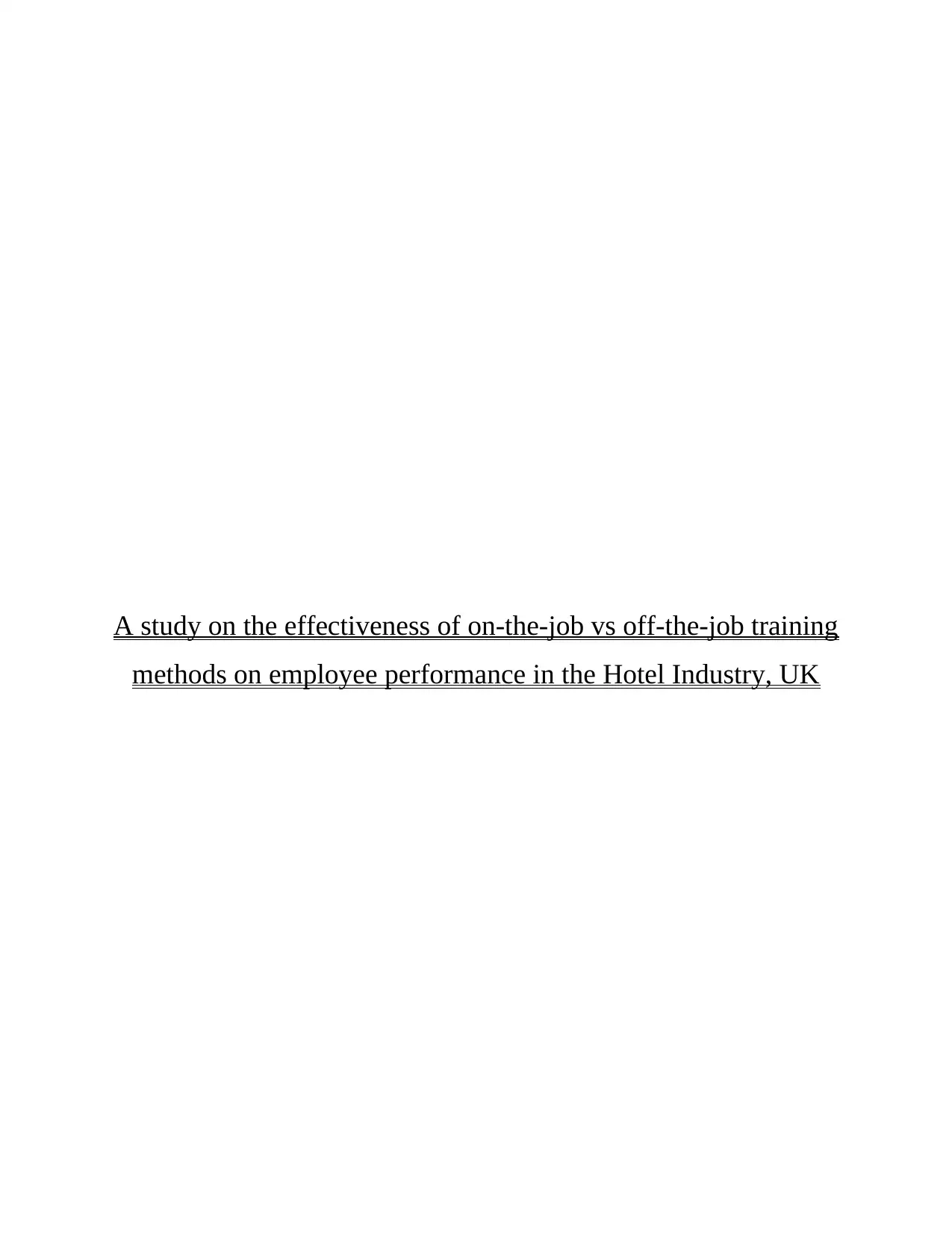
A study on the effectiveness of on-the-job vs off-the-job training
methods on employee performance in the Hotel Industry, UK
methods on employee performance in the Hotel Industry, UK
Secure Best Marks with AI Grader
Need help grading? Try our AI Grader for instant feedback on your assignments.

ACKNOWLEDGEMENT
I owe my gratitude to my teacher who has provided me with the opportunity to carry out this
research knowledge. Along with this, I would also like to thank my mentor for his support and
guidance. I would thank my friends and family member which has supported me in the best
possible manner throughout the entire study. In addition to this, I would also like to thank my
team members and colleagues who assisted me in data collection and analysis.
2
I owe my gratitude to my teacher who has provided me with the opportunity to carry out this
research knowledge. Along with this, I would also like to thank my mentor for his support and
guidance. I would thank my friends and family member which has supported me in the best
possible manner throughout the entire study. In addition to this, I would also like to thank my
team members and colleagues who assisted me in data collection and analysis.
2

ABSTRACT
Purpose of the research- One of the main purpose behind carrying out this research is to
investigate the effectiveness of on-the-job v/s off-the-job training methods on employee
performance in the Hotel Industry, UK. Various techniques and method of training is used by
organizations operating in hospitality industrial. Further, with the help of this study, the
researcher has evaluated different methods of training and their impact on performance of
employees.
Benefits and implications- This study will benefit the organizations operating in hospitality
industry by making them aware about different training methods. Along with this, it will also
support them in enhancing productivity and performance of their human resources.
Methodologies used- In the present study, the researcher has used exploratory research design in
order to explore different elements associated with on the job and off the job training method.
Along with this, inductive approach has been used in order to gain generalize results with regards
to the topic under investigation. Furthermore, both primary and secondary sources were used to
collect data. Primary information has been gathered by 50 employees of some renowned
organization in hospitality industry by using simple random sampling method. Qualitative
technique of data analysis has been used to evaluate information and present the findings of the
study.
Results- The results of this study highlights the fact that both on the job and off the job training
method are effective. In addition to this, it also reflects that training method should be selected
on the basis of need and situations.
3
Purpose of the research- One of the main purpose behind carrying out this research is to
investigate the effectiveness of on-the-job v/s off-the-job training methods on employee
performance in the Hotel Industry, UK. Various techniques and method of training is used by
organizations operating in hospitality industrial. Further, with the help of this study, the
researcher has evaluated different methods of training and their impact on performance of
employees.
Benefits and implications- This study will benefit the organizations operating in hospitality
industry by making them aware about different training methods. Along with this, it will also
support them in enhancing productivity and performance of their human resources.
Methodologies used- In the present study, the researcher has used exploratory research design in
order to explore different elements associated with on the job and off the job training method.
Along with this, inductive approach has been used in order to gain generalize results with regards
to the topic under investigation. Furthermore, both primary and secondary sources were used to
collect data. Primary information has been gathered by 50 employees of some renowned
organization in hospitality industry by using simple random sampling method. Qualitative
technique of data analysis has been used to evaluate information and present the findings of the
study.
Results- The results of this study highlights the fact that both on the job and off the job training
method are effective. In addition to this, it also reflects that training method should be selected
on the basis of need and situations.
3
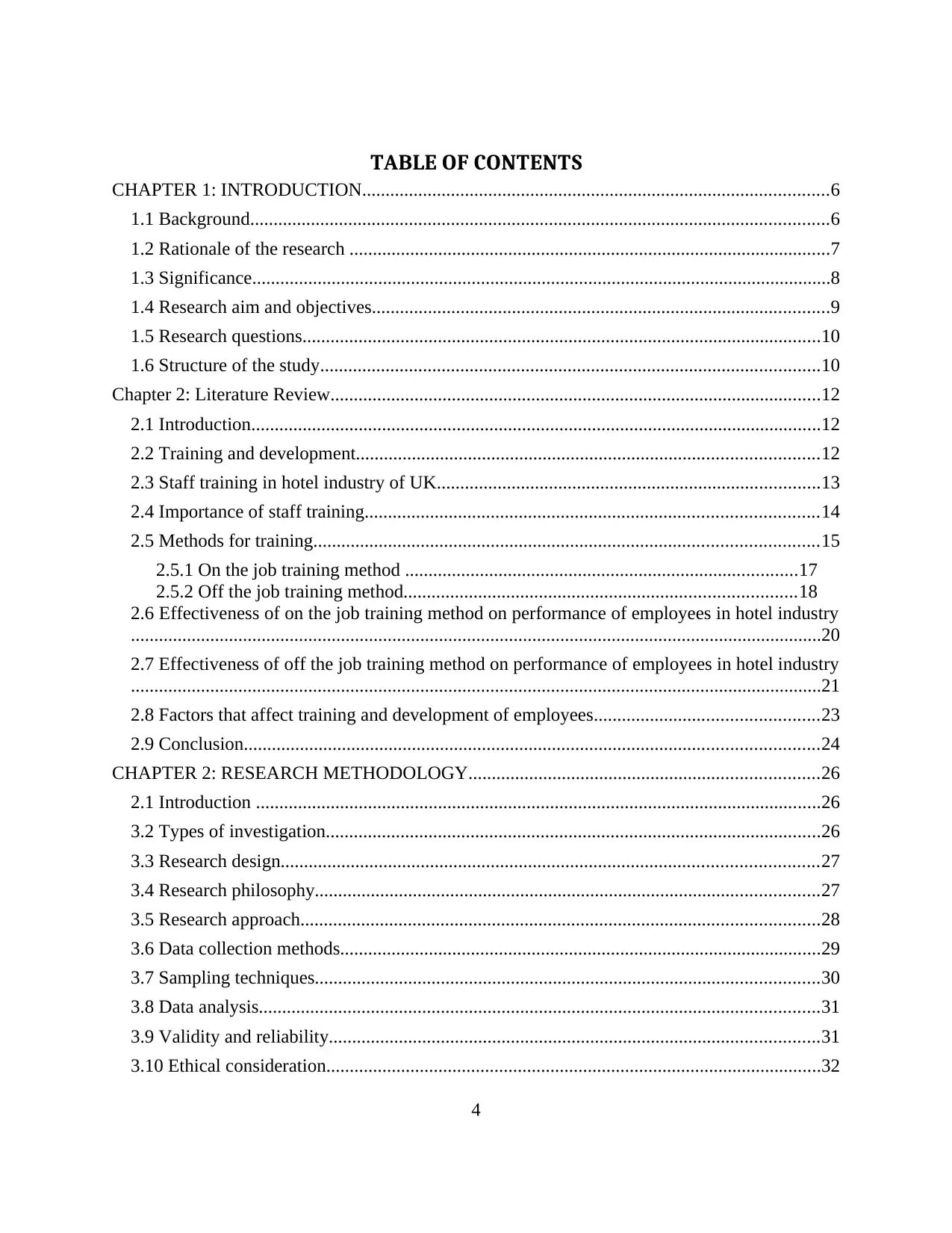
TABLE OF CONTENTS
CHAPTER 1: INTRODUCTION....................................................................................................6
1.1 Background............................................................................................................................6
1.2 Rationale of the research .......................................................................................................7
1.3 Significance............................................................................................................................8
1.4 Research aim and objectives..................................................................................................9
1.5 Research questions...............................................................................................................10
1.6 Structure of the study...........................................................................................................10
Chapter 2: Literature Review.........................................................................................................12
2.1 Introduction..........................................................................................................................12
2.2 Training and development...................................................................................................12
2.3 Staff training in hotel industry of UK..................................................................................13
2.4 Importance of staff training.................................................................................................14
2.5 Methods for training............................................................................................................15
2.5.1 On the job training method ....................................................................................17
2.5.2 Off the job training method....................................................................................18
2.6 Effectiveness of on the job training method on performance of employees in hotel industry
....................................................................................................................................................20
2.7 Effectiveness of off the job training method on performance of employees in hotel industry
....................................................................................................................................................21
2.8 Factors that affect training and development of employees................................................23
2.9 Conclusion...........................................................................................................................24
CHAPTER 2: RESEARCH METHODOLOGY...........................................................................26
2.1 Introduction .........................................................................................................................26
3.2 Types of investigation..........................................................................................................26
3.3 Research design...................................................................................................................27
3.4 Research philosophy............................................................................................................27
3.5 Research approach...............................................................................................................28
3.6 Data collection methods.......................................................................................................29
3.7 Sampling techniques............................................................................................................30
3.8 Data analysis........................................................................................................................31
3.9 Validity and reliability.........................................................................................................31
3.10 Ethical consideration..........................................................................................................32
4
CHAPTER 1: INTRODUCTION....................................................................................................6
1.1 Background............................................................................................................................6
1.2 Rationale of the research .......................................................................................................7
1.3 Significance............................................................................................................................8
1.4 Research aim and objectives..................................................................................................9
1.5 Research questions...............................................................................................................10
1.6 Structure of the study...........................................................................................................10
Chapter 2: Literature Review.........................................................................................................12
2.1 Introduction..........................................................................................................................12
2.2 Training and development...................................................................................................12
2.3 Staff training in hotel industry of UK..................................................................................13
2.4 Importance of staff training.................................................................................................14
2.5 Methods for training............................................................................................................15
2.5.1 On the job training method ....................................................................................17
2.5.2 Off the job training method....................................................................................18
2.6 Effectiveness of on the job training method on performance of employees in hotel industry
....................................................................................................................................................20
2.7 Effectiveness of off the job training method on performance of employees in hotel industry
....................................................................................................................................................21
2.8 Factors that affect training and development of employees................................................23
2.9 Conclusion...........................................................................................................................24
CHAPTER 2: RESEARCH METHODOLOGY...........................................................................26
2.1 Introduction .........................................................................................................................26
3.2 Types of investigation..........................................................................................................26
3.3 Research design...................................................................................................................27
3.4 Research philosophy............................................................................................................27
3.5 Research approach...............................................................................................................28
3.6 Data collection methods.......................................................................................................29
3.7 Sampling techniques............................................................................................................30
3.8 Data analysis........................................................................................................................31
3.9 Validity and reliability.........................................................................................................31
3.10 Ethical consideration..........................................................................................................32
4
Paraphrase This Document
Need a fresh take? Get an instant paraphrase of this document with our AI Paraphraser
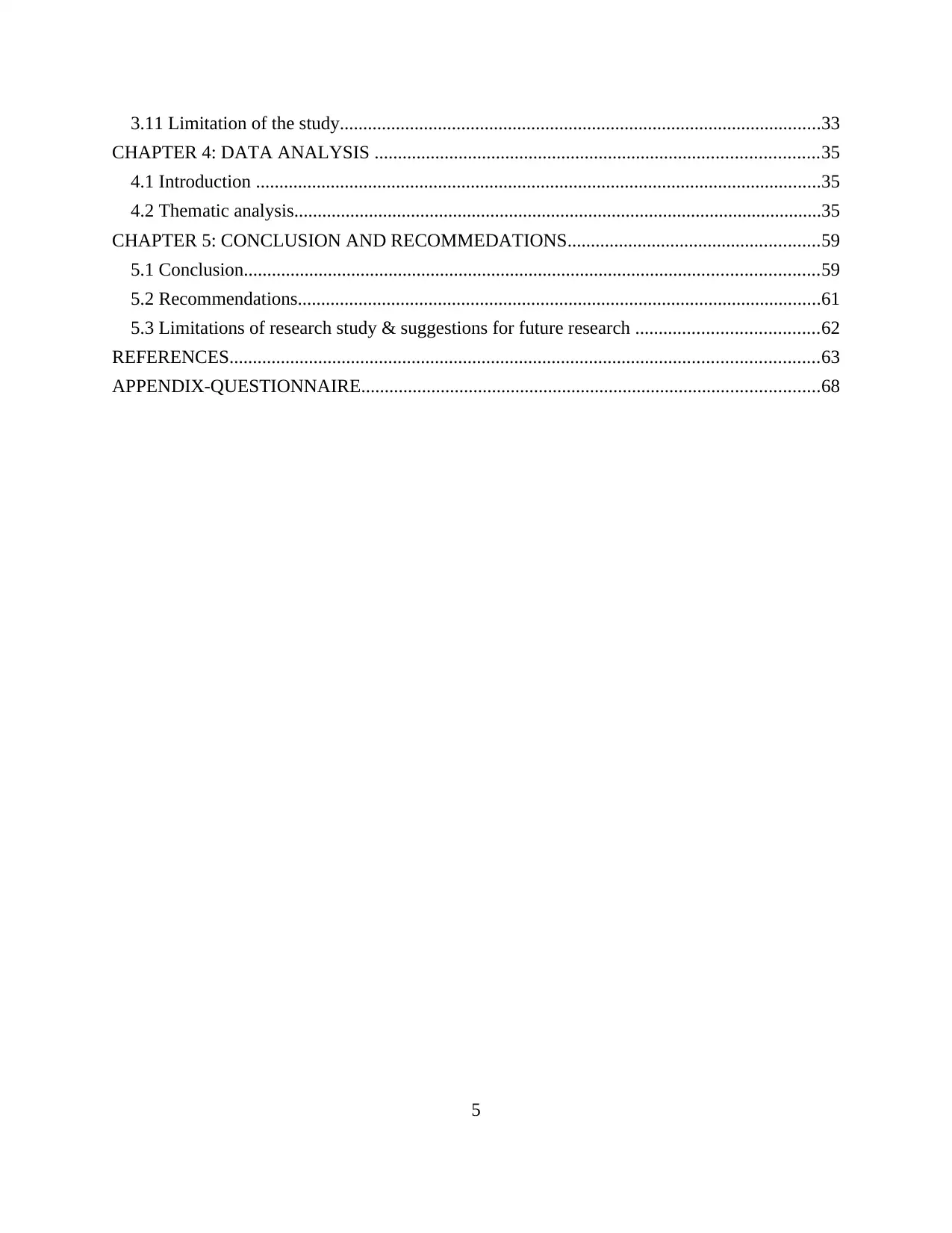
3.11 Limitation of the study.......................................................................................................33
CHAPTER 4: DATA ANALYSIS ...............................................................................................35
4.1 Introduction .........................................................................................................................35
4.2 Thematic analysis.................................................................................................................35
CHAPTER 5: CONCLUSION AND RECOMMEDATIONS......................................................59
5.1 Conclusion...........................................................................................................................59
5.2 Recommendations................................................................................................................61
5.3 Limitations of research study & suggestions for future research .......................................62
REFERENCES..............................................................................................................................63
APPENDIX-QUESTIONNAIRE..................................................................................................68
5
CHAPTER 4: DATA ANALYSIS ...............................................................................................35
4.1 Introduction .........................................................................................................................35
4.2 Thematic analysis.................................................................................................................35
CHAPTER 5: CONCLUSION AND RECOMMEDATIONS......................................................59
5.1 Conclusion...........................................................................................................................59
5.2 Recommendations................................................................................................................61
5.3 Limitations of research study & suggestions for future research .......................................62
REFERENCES..............................................................................................................................63
APPENDIX-QUESTIONNAIRE..................................................................................................68
5

CHAPTER 1: INTRODUCTION
1.1 Overview
Training and development of employees is an essential aspect because it determines long
run success of the firm in the marketplace. Every organization that wants to succeed, must ensure
constant development of workforce (Noe, 2010). Training is the process of imparting learning
among personnel working organization so as to achieve specified objectives right time. Training
and development are key to ensure efficient management and proper upkeep of skilled staff
members. Without implementation of effective training program company cannot achieve its
objectives on right time because lack of expertise in human resources. Training is the most
important aspect of developing human resources thus it is very important for corporation to
assess effective training method (Olaniyan and Ojo, 2008). Hotel industry especially requires
training and development at workplace so that all activities can be managed in an effectual
manner. The basic need of employees working in hotel industry are in term of; skills, attitude and
knowledge. These all elements can be developed through the help different kinds of training
methods. Each of these stated element has specific training need otherwise it serves just as the
wastage of time and resources. For example skills are developed through inclusion of right kind
of practice instead of training. Unlike skills, knowledge can be acquired by appropriate training
method. For instance, employees can be provided formal training in particular area so as to
enhance their knowledge in an effectual manner (Hollenbeck, 2008) Moreover, attitude is
different aspect which can learned by another kind of training. It enables workforce to learn new
aspect and cater need of number of customers workforce arrive in hotel for accessing services.
Present study is based on hotel industry of UK which is contributing a lot towards
economic growth. It consists of several major hotels like Marriott, Thistle, IHG and Ritz Carlton.
The hotel sector of UK is having impressive growth and it has been estimated that it will hacve
further growth in coming two year (UK hotel growth set to continue into 2016, 2016). Similarly,
improving economic condition and traveling growth assist corporation to ensure its long run
growth in coming financial year (UK hotels forecast 2016 – Growth is in the air, 2016). These
hotels adopt wide range of strategies in order to enhance skills and knowledge of employees. In
this regard both training method namely, on-the-job as well as off-the-job training method is
provided to staff members in accordance with their requirement. Further, due to changes external
6
1.1 Overview
Training and development of employees is an essential aspect because it determines long
run success of the firm in the marketplace. Every organization that wants to succeed, must ensure
constant development of workforce (Noe, 2010). Training is the process of imparting learning
among personnel working organization so as to achieve specified objectives right time. Training
and development are key to ensure efficient management and proper upkeep of skilled staff
members. Without implementation of effective training program company cannot achieve its
objectives on right time because lack of expertise in human resources. Training is the most
important aspect of developing human resources thus it is very important for corporation to
assess effective training method (Olaniyan and Ojo, 2008). Hotel industry especially requires
training and development at workplace so that all activities can be managed in an effectual
manner. The basic need of employees working in hotel industry are in term of; skills, attitude and
knowledge. These all elements can be developed through the help different kinds of training
methods. Each of these stated element has specific training need otherwise it serves just as the
wastage of time and resources. For example skills are developed through inclusion of right kind
of practice instead of training. Unlike skills, knowledge can be acquired by appropriate training
method. For instance, employees can be provided formal training in particular area so as to
enhance their knowledge in an effectual manner (Hollenbeck, 2008) Moreover, attitude is
different aspect which can learned by another kind of training. It enables workforce to learn new
aspect and cater need of number of customers workforce arrive in hotel for accessing services.
Present study is based on hotel industry of UK which is contributing a lot towards
economic growth. It consists of several major hotels like Marriott, Thistle, IHG and Ritz Carlton.
The hotel sector of UK is having impressive growth and it has been estimated that it will hacve
further growth in coming two year (UK hotel growth set to continue into 2016, 2016). Similarly,
improving economic condition and traveling growth assist corporation to ensure its long run
growth in coming financial year (UK hotels forecast 2016 – Growth is in the air, 2016). These
hotels adopt wide range of strategies in order to enhance skills and knowledge of employees. In
this regard both training method namely, on-the-job as well as off-the-job training method is
provided to staff members in accordance with their requirement. Further, due to changes external
6
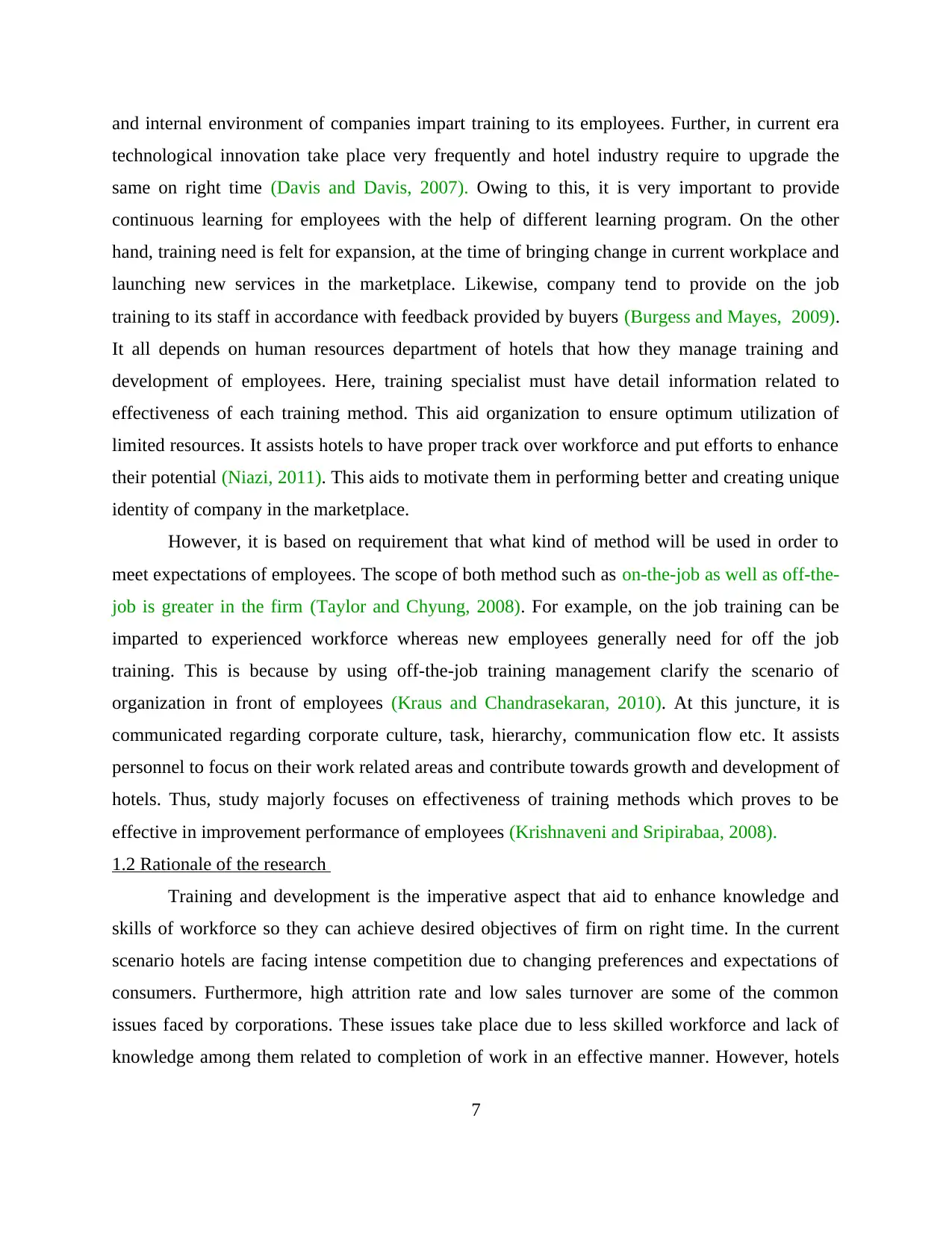
and internal environment of companies impart training to its employees. Further, in current era
technological innovation take place very frequently and hotel industry require to upgrade the
same on right time (Davis and Davis, 2007). Owing to this, it is very important to provide
continuous learning for employees with the help of different learning program. On the other
hand, training need is felt for expansion, at the time of bringing change in current workplace and
launching new services in the marketplace. Likewise, company tend to provide on the job
training to its staff in accordance with feedback provided by buyers (Burgess and Mayes, 2009).
It all depends on human resources department of hotels that how they manage training and
development of employees. Here, training specialist must have detail information related to
effectiveness of each training method. This aid organization to ensure optimum utilization of
limited resources. It assists hotels to have proper track over workforce and put efforts to enhance
their potential (Niazi, 2011). This aids to motivate them in performing better and creating unique
identity of company in the marketplace.
However, it is based on requirement that what kind of method will be used in order to
meet expectations of employees. The scope of both method such as on-the-job as well as off-the-
job is greater in the firm (Taylor and Chyung, 2008). For example, on the job training can be
imparted to experienced workforce whereas new employees generally need for off the job
training. This is because by using off-the-job training management clarify the scenario of
organization in front of employees (Kraus and Chandrasekaran, 2010). At this juncture, it is
communicated regarding corporate culture, task, hierarchy, communication flow etc. It assists
personnel to focus on their work related areas and contribute towards growth and development of
hotels. Thus, study majorly focuses on effectiveness of training methods which proves to be
effective in improvement performance of employees (Krishnaveni and Sripirabaa, 2008).
1.2 Rationale of the research
Training and development is the imperative aspect that aid to enhance knowledge and
skills of workforce so they can achieve desired objectives of firm on right time. In the current
scenario hotels are facing intense competition due to changing preferences and expectations of
consumers. Furthermore, high attrition rate and low sales turnover are some of the common
issues faced by corporations. These issues take place due to less skilled workforce and lack of
knowledge among them related to completion of work in an effective manner. However, hotels
7
technological innovation take place very frequently and hotel industry require to upgrade the
same on right time (Davis and Davis, 2007). Owing to this, it is very important to provide
continuous learning for employees with the help of different learning program. On the other
hand, training need is felt for expansion, at the time of bringing change in current workplace and
launching new services in the marketplace. Likewise, company tend to provide on the job
training to its staff in accordance with feedback provided by buyers (Burgess and Mayes, 2009).
It all depends on human resources department of hotels that how they manage training and
development of employees. Here, training specialist must have detail information related to
effectiveness of each training method. This aid organization to ensure optimum utilization of
limited resources. It assists hotels to have proper track over workforce and put efforts to enhance
their potential (Niazi, 2011). This aids to motivate them in performing better and creating unique
identity of company in the marketplace.
However, it is based on requirement that what kind of method will be used in order to
meet expectations of employees. The scope of both method such as on-the-job as well as off-the-
job is greater in the firm (Taylor and Chyung, 2008). For example, on the job training can be
imparted to experienced workforce whereas new employees generally need for off the job
training. This is because by using off-the-job training management clarify the scenario of
organization in front of employees (Kraus and Chandrasekaran, 2010). At this juncture, it is
communicated regarding corporate culture, task, hierarchy, communication flow etc. It assists
personnel to focus on their work related areas and contribute towards growth and development of
hotels. Thus, study majorly focuses on effectiveness of training methods which proves to be
effective in improvement performance of employees (Krishnaveni and Sripirabaa, 2008).
1.2 Rationale of the research
Training and development is the imperative aspect that aid to enhance knowledge and
skills of workforce so they can achieve desired objectives of firm on right time. In the current
scenario hotels are facing intense competition due to changing preferences and expectations of
consumers. Furthermore, high attrition rate and low sales turnover are some of the common
issues faced by corporations. These issues take place due to less skilled workforce and lack of
knowledge among them related to completion of work in an effective manner. However, hotels
7
Secure Best Marks with AI Grader
Need help grading? Try our AI Grader for instant feedback on your assignments.
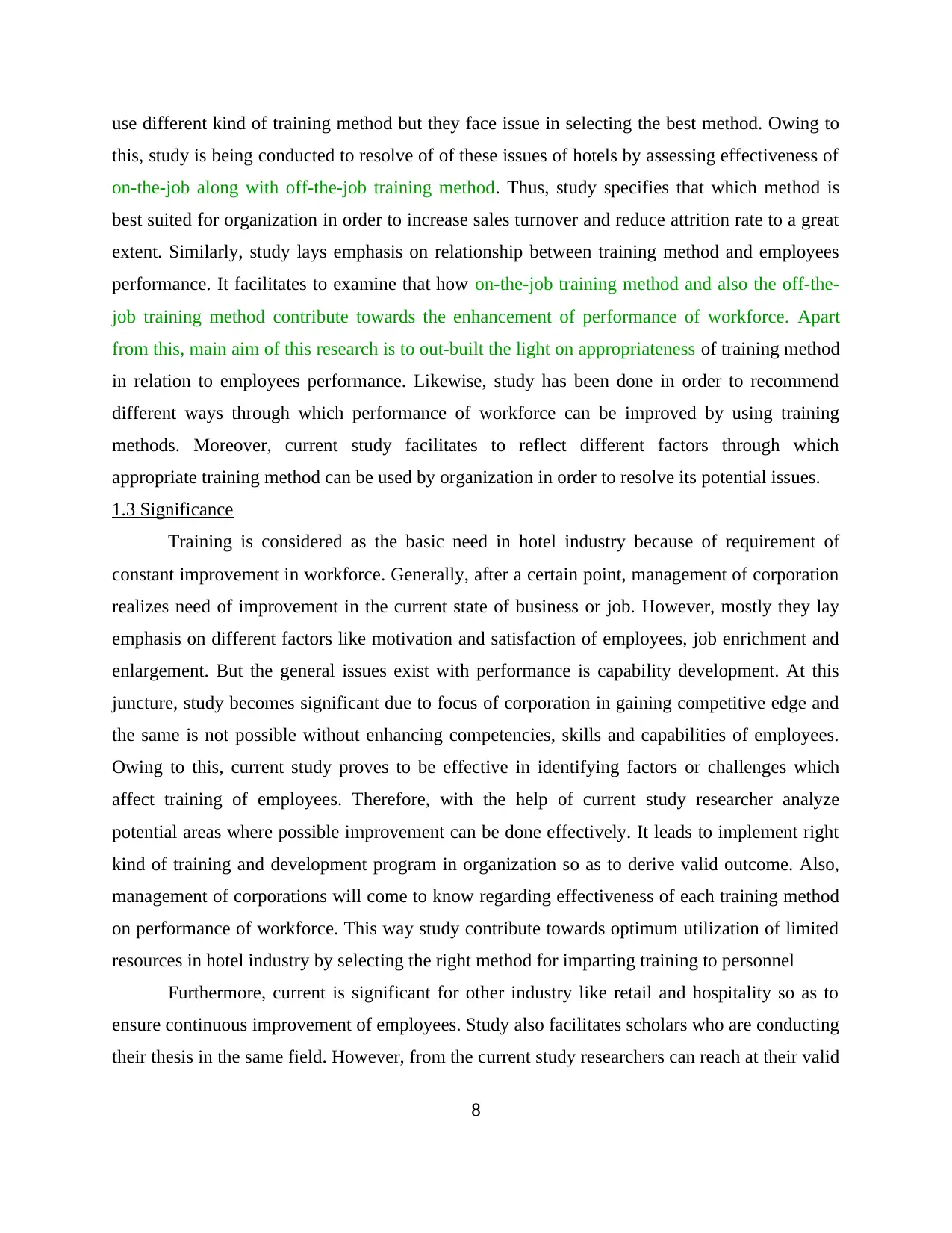
use different kind of training method but they face issue in selecting the best method. Owing to
this, study is being conducted to resolve of of these issues of hotels by assessing effectiveness of
on-the-job along with off-the-job training method. Thus, study specifies that which method is
best suited for organization in order to increase sales turnover and reduce attrition rate to a great
extent. Similarly, study lays emphasis on relationship between training method and employees
performance. It facilitates to examine that how on-the-job training method and also the off-the-
job training method contribute towards the enhancement of performance of workforce. Apart
from this, main aim of this research is to out-built the light on appropriateness of training method
in relation to employees performance. Likewise, study has been done in order to recommend
different ways through which performance of workforce can be improved by using training
methods. Moreover, current study facilitates to reflect different factors through which
appropriate training method can be used by organization in order to resolve its potential issues.
1.3 Significance
Training is considered as the basic need in hotel industry because of requirement of
constant improvement in workforce. Generally, after a certain point, management of corporation
realizes need of improvement in the current state of business or job. However, mostly they lay
emphasis on different factors like motivation and satisfaction of employees, job enrichment and
enlargement. But the general issues exist with performance is capability development. At this
juncture, study becomes significant due to focus of corporation in gaining competitive edge and
the same is not possible without enhancing competencies, skills and capabilities of employees.
Owing to this, current study proves to be effective in identifying factors or challenges which
affect training of employees. Therefore, with the help of current study researcher analyze
potential areas where possible improvement can be done effectively. It leads to implement right
kind of training and development program in organization so as to derive valid outcome. Also,
management of corporations will come to know regarding effectiveness of each training method
on performance of workforce. This way study contribute towards optimum utilization of limited
resources in hotel industry by selecting the right method for imparting training to personnel
Furthermore, current is significant for other industry like retail and hospitality so as to
ensure continuous improvement of employees. Study also facilitates scholars who are conducting
their thesis in the same field. However, from the current study researchers can reach at their valid
8
this, study is being conducted to resolve of of these issues of hotels by assessing effectiveness of
on-the-job along with off-the-job training method. Thus, study specifies that which method is
best suited for organization in order to increase sales turnover and reduce attrition rate to a great
extent. Similarly, study lays emphasis on relationship between training method and employees
performance. It facilitates to examine that how on-the-job training method and also the off-the-
job training method contribute towards the enhancement of performance of workforce. Apart
from this, main aim of this research is to out-built the light on appropriateness of training method
in relation to employees performance. Likewise, study has been done in order to recommend
different ways through which performance of workforce can be improved by using training
methods. Moreover, current study facilitates to reflect different factors through which
appropriate training method can be used by organization in order to resolve its potential issues.
1.3 Significance
Training is considered as the basic need in hotel industry because of requirement of
constant improvement in workforce. Generally, after a certain point, management of corporation
realizes need of improvement in the current state of business or job. However, mostly they lay
emphasis on different factors like motivation and satisfaction of employees, job enrichment and
enlargement. But the general issues exist with performance is capability development. At this
juncture, study becomes significant due to focus of corporation in gaining competitive edge and
the same is not possible without enhancing competencies, skills and capabilities of employees.
Owing to this, current study proves to be effective in identifying factors or challenges which
affect training of employees. Therefore, with the help of current study researcher analyze
potential areas where possible improvement can be done effectively. It leads to implement right
kind of training and development program in organization so as to derive valid outcome. Also,
management of corporations will come to know regarding effectiveness of each training method
on performance of workforce. This way study contribute towards optimum utilization of limited
resources in hotel industry by selecting the right method for imparting training to personnel
Furthermore, current is significant for other industry like retail and hospitality so as to
ensure continuous improvement of employees. Study also facilitates scholars who are conducting
their thesis in the same field. However, from the current study researchers can reach at their valid
8
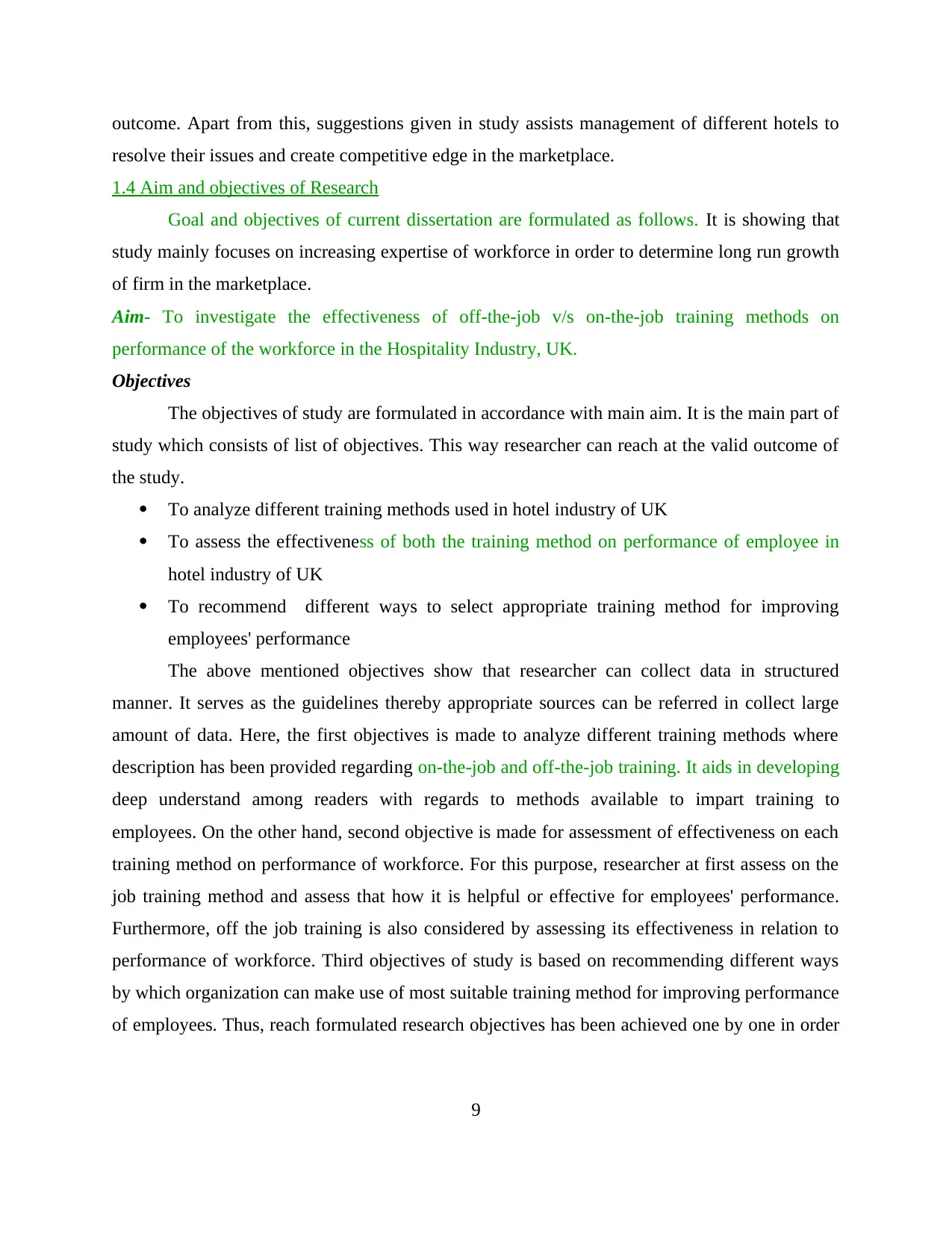
outcome. Apart from this, suggestions given in study assists management of different hotels to
resolve their issues and create competitive edge in the marketplace.
1.4 Aim and objectives of Research
Goal and objectives of current dissertation are formulated as follows. It is showing that
study mainly focuses on increasing expertise of workforce in order to determine long run growth
of firm in the marketplace.
Aim- To investigate the effectiveness of off-the-job v/s on-the-job training methods on
performance of the workforce in the Hospitality Industry, UK.
Objectives
The objectives of study are formulated in accordance with main aim. It is the main part of
study which consists of list of objectives. This way researcher can reach at the valid outcome of
the study.
To analyze different training methods used in hotel industry of UK
To assess the effectiveness of both the training method on performance of employee in
hotel industry of UK
To recommend different ways to select appropriate training method for improving
employees' performance
The above mentioned objectives show that researcher can collect data in structured
manner. It serves as the guidelines thereby appropriate sources can be referred in collect large
amount of data. Here, the first objectives is made to analyze different training methods where
description has been provided regarding on-the-job and off-the-job training. It aids in developing
deep understand among readers with regards to methods available to impart training to
employees. On the other hand, second objective is made for assessment of effectiveness on each
training method on performance of workforce. For this purpose, researcher at first assess on the
job training method and assess that how it is helpful or effective for employees' performance.
Furthermore, off the job training is also considered by assessing its effectiveness in relation to
performance of workforce. Third objectives of study is based on recommending different ways
by which organization can make use of most suitable training method for improving performance
of employees. Thus, reach formulated research objectives has been achieved one by one in order
9
resolve their issues and create competitive edge in the marketplace.
1.4 Aim and objectives of Research
Goal and objectives of current dissertation are formulated as follows. It is showing that
study mainly focuses on increasing expertise of workforce in order to determine long run growth
of firm in the marketplace.
Aim- To investigate the effectiveness of off-the-job v/s on-the-job training methods on
performance of the workforce in the Hospitality Industry, UK.
Objectives
The objectives of study are formulated in accordance with main aim. It is the main part of
study which consists of list of objectives. This way researcher can reach at the valid outcome of
the study.
To analyze different training methods used in hotel industry of UK
To assess the effectiveness of both the training method on performance of employee in
hotel industry of UK
To recommend different ways to select appropriate training method for improving
employees' performance
The above mentioned objectives show that researcher can collect data in structured
manner. It serves as the guidelines thereby appropriate sources can be referred in collect large
amount of data. Here, the first objectives is made to analyze different training methods where
description has been provided regarding on-the-job and off-the-job training. It aids in developing
deep understand among readers with regards to methods available to impart training to
employees. On the other hand, second objective is made for assessment of effectiveness on each
training method on performance of workforce. For this purpose, researcher at first assess on the
job training method and assess that how it is helpful or effective for employees' performance.
Furthermore, off the job training is also considered by assessing its effectiveness in relation to
performance of workforce. Third objectives of study is based on recommending different ways
by which organization can make use of most suitable training method for improving performance
of employees. Thus, reach formulated research objectives has been achieved one by one in order
9
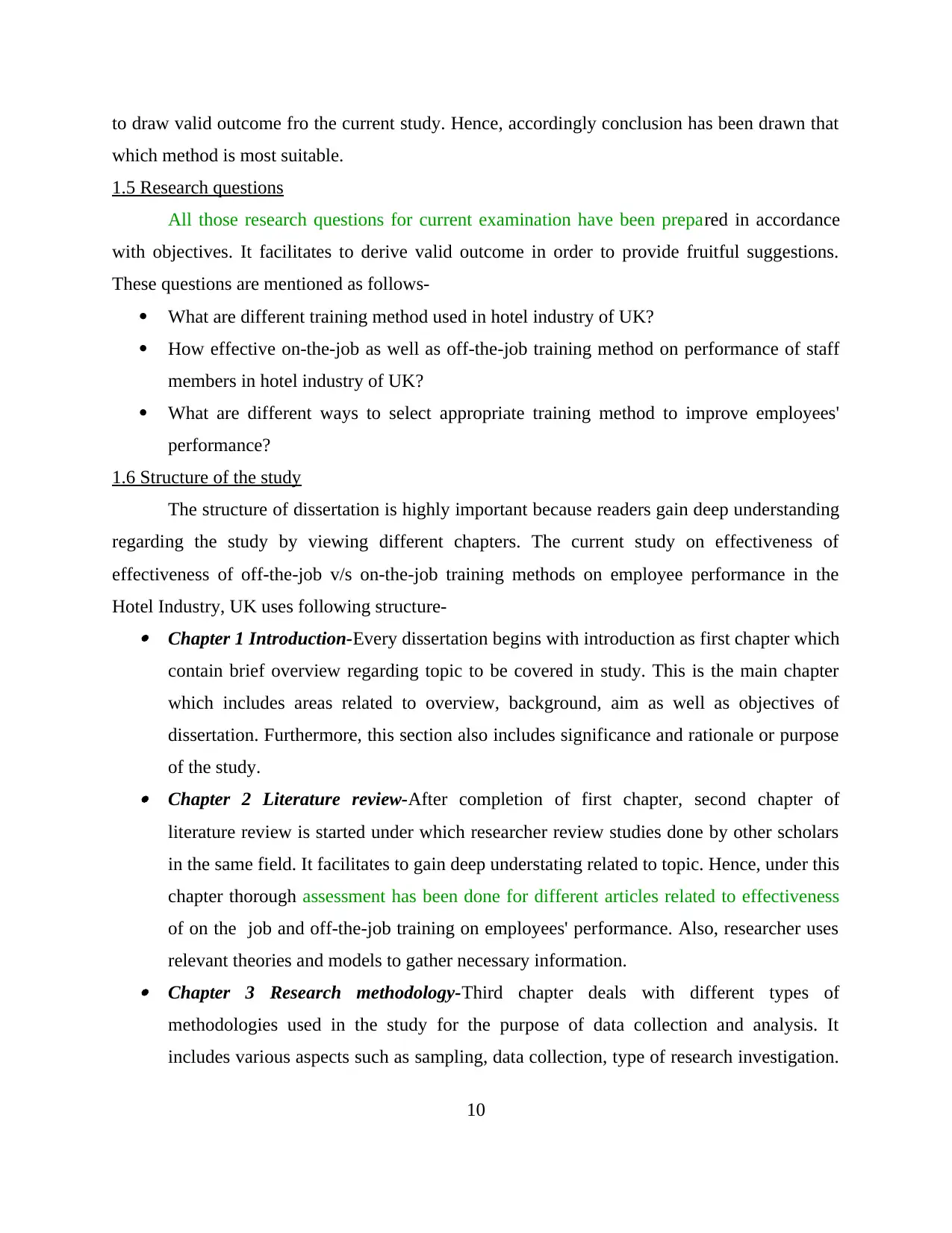
to draw valid outcome fro the current study. Hence, accordingly conclusion has been drawn that
which method is most suitable.
1.5 Research questions
All those research questions for current examination have been prepared in accordance
with objectives. It facilitates to derive valid outcome in order to provide fruitful suggestions.
These questions are mentioned as follows-
What are different training method used in hotel industry of UK?
How effective on-the-job as well as off-the-job training method on performance of staff
members in hotel industry of UK?
What are different ways to select appropriate training method to improve employees'
performance?
1.6 Structure of the study
The structure of dissertation is highly important because readers gain deep understanding
regarding the study by viewing different chapters. The current study on effectiveness of
effectiveness of off-the-job v/s on-the-job training methods on employee performance in the
Hotel Industry, UK uses following structure- Chapter 1 Introduction-Every dissertation begins with introduction as first chapter which
contain brief overview regarding topic to be covered in study. This is the main chapter
which includes areas related to overview, background, aim as well as objectives of
dissertation. Furthermore, this section also includes significance and rationale or purpose
of the study. Chapter 2 Literature review-After completion of first chapter, second chapter of
literature review is started under which researcher review studies done by other scholars
in the same field. It facilitates to gain deep understating related to topic. Hence, under this
chapter thorough assessment has been done for different articles related to effectiveness
of on the job and off-the-job training on employees' performance. Also, researcher uses
relevant theories and models to gather necessary information. Chapter 3 Research methodology-Third chapter deals with different types of
methodologies used in the study for the purpose of data collection and analysis. It
includes various aspects such as sampling, data collection, type of research investigation.
10
which method is most suitable.
1.5 Research questions
All those research questions for current examination have been prepared in accordance
with objectives. It facilitates to derive valid outcome in order to provide fruitful suggestions.
These questions are mentioned as follows-
What are different training method used in hotel industry of UK?
How effective on-the-job as well as off-the-job training method on performance of staff
members in hotel industry of UK?
What are different ways to select appropriate training method to improve employees'
performance?
1.6 Structure of the study
The structure of dissertation is highly important because readers gain deep understanding
regarding the study by viewing different chapters. The current study on effectiveness of
effectiveness of off-the-job v/s on-the-job training methods on employee performance in the
Hotel Industry, UK uses following structure- Chapter 1 Introduction-Every dissertation begins with introduction as first chapter which
contain brief overview regarding topic to be covered in study. This is the main chapter
which includes areas related to overview, background, aim as well as objectives of
dissertation. Furthermore, this section also includes significance and rationale or purpose
of the study. Chapter 2 Literature review-After completion of first chapter, second chapter of
literature review is started under which researcher review studies done by other scholars
in the same field. It facilitates to gain deep understating related to topic. Hence, under this
chapter thorough assessment has been done for different articles related to effectiveness
of on the job and off-the-job training on employees' performance. Also, researcher uses
relevant theories and models to gather necessary information. Chapter 3 Research methodology-Third chapter deals with different types of
methodologies used in the study for the purpose of data collection and analysis. It
includes various aspects such as sampling, data collection, type of research investigation.
10
Paraphrase This Document
Need a fresh take? Get an instant paraphrase of this document with our AI Paraphraser
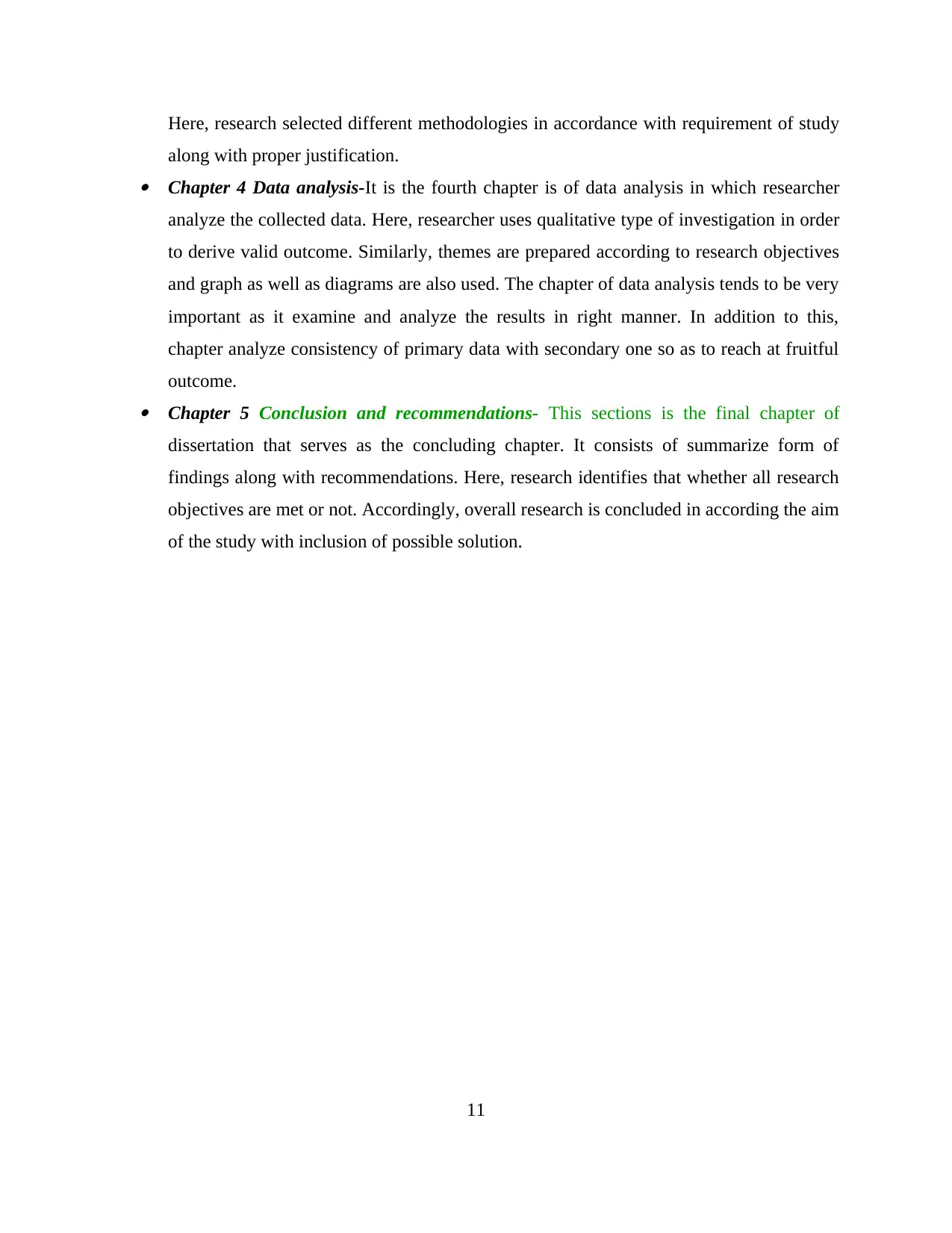
Here, research selected different methodologies in accordance with requirement of study
along with proper justification. Chapter 4 Data analysis-It is the fourth chapter is of data analysis in which researcher
analyze the collected data. Here, researcher uses qualitative type of investigation in order
to derive valid outcome. Similarly, themes are prepared according to research objectives
and graph as well as diagrams are also used. The chapter of data analysis tends to be very
important as it examine and analyze the results in right manner. In addition to this,
chapter analyze consistency of primary data with secondary one so as to reach at fruitful
outcome. Chapter 5 Conclusion and recommendations- This sections is the final chapter of
dissertation that serves as the concluding chapter. It consists of summarize form of
findings along with recommendations. Here, research identifies that whether all research
objectives are met or not. Accordingly, overall research is concluded in according the aim
of the study with inclusion of possible solution.
11
along with proper justification. Chapter 4 Data analysis-It is the fourth chapter is of data analysis in which researcher
analyze the collected data. Here, researcher uses qualitative type of investigation in order
to derive valid outcome. Similarly, themes are prepared according to research objectives
and graph as well as diagrams are also used. The chapter of data analysis tends to be very
important as it examine and analyze the results in right manner. In addition to this,
chapter analyze consistency of primary data with secondary one so as to reach at fruitful
outcome. Chapter 5 Conclusion and recommendations- This sections is the final chapter of
dissertation that serves as the concluding chapter. It consists of summarize form of
findings along with recommendations. Here, research identifies that whether all research
objectives are met or not. Accordingly, overall research is concluded in according the aim
of the study with inclusion of possible solution.
11
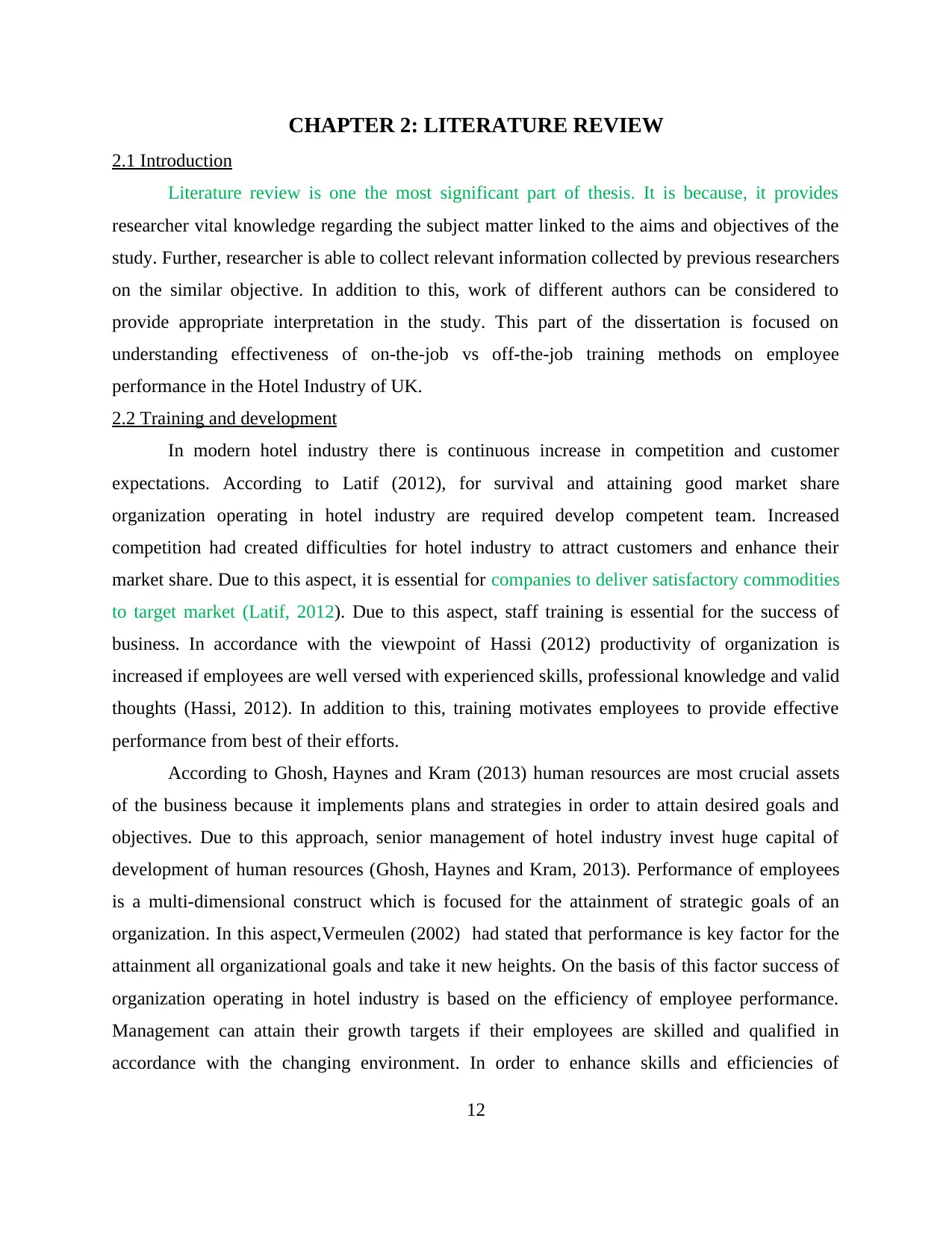
CHAPTER 2: LITERATURE REVIEW
2.1 Introduction
Literature review is one the most significant part of thesis. It is because, it provides
researcher vital knowledge regarding the subject matter linked to the aims and objectives of the
study. Further, researcher is able to collect relevant information collected by previous researchers
on the similar objective. In addition to this, work of different authors can be considered to
provide appropriate interpretation in the study. This part of the dissertation is focused on
understanding effectiveness of on-the-job vs off-the-job training methods on employee
performance in the Hotel Industry of UK.
2.2 Training and development
In modern hotel industry there is continuous increase in competition and customer
expectations. According to Latif (2012), for survival and attaining good market share
organization operating in hotel industry are required develop competent team. Increased
competition had created difficulties for hotel industry to attract customers and enhance their
market share. Due to this aspect, it is essential for companies to deliver satisfactory commodities
to target market (Latif, 2012). Due to this aspect, staff training is essential for the success of
business. In accordance with the viewpoint of Hassi (2012) productivity of organization is
increased if employees are well versed with experienced skills, professional knowledge and valid
thoughts (Hassi, 2012). In addition to this, training motivates employees to provide effective
performance from best of their efforts.
According to Ghosh, Haynes and Kram (2013) human resources are most crucial assets
of the business because it implements plans and strategies in order to attain desired goals and
objectives. Due to this approach, senior management of hotel industry invest huge capital of
development of human resources (Ghosh, Haynes and Kram, 2013). Performance of employees
is a multi-dimensional construct which is focused for the attainment of strategic goals of an
organization. In this aspect,Vermeulen (2002) had stated that performance is key factor for the
attainment all organizational goals and take it new heights. On the basis of this factor success of
organization operating in hotel industry is based on the efficiency of employee performance.
Management can attain their growth targets if their employees are skilled and qualified in
accordance with the changing environment. In order to enhance skills and efficiencies of
12
2.1 Introduction
Literature review is one the most significant part of thesis. It is because, it provides
researcher vital knowledge regarding the subject matter linked to the aims and objectives of the
study. Further, researcher is able to collect relevant information collected by previous researchers
on the similar objective. In addition to this, work of different authors can be considered to
provide appropriate interpretation in the study. This part of the dissertation is focused on
understanding effectiveness of on-the-job vs off-the-job training methods on employee
performance in the Hotel Industry of UK.
2.2 Training and development
In modern hotel industry there is continuous increase in competition and customer
expectations. According to Latif (2012), for survival and attaining good market share
organization operating in hotel industry are required develop competent team. Increased
competition had created difficulties for hotel industry to attract customers and enhance their
market share. Due to this aspect, it is essential for companies to deliver satisfactory commodities
to target market (Latif, 2012). Due to this aspect, staff training is essential for the success of
business. In accordance with the viewpoint of Hassi (2012) productivity of organization is
increased if employees are well versed with experienced skills, professional knowledge and valid
thoughts (Hassi, 2012). In addition to this, training motivates employees to provide effective
performance from best of their efforts.
According to Ghosh, Haynes and Kram (2013) human resources are most crucial assets
of the business because it implements plans and strategies in order to attain desired goals and
objectives. Due to this approach, senior management of hotel industry invest huge capital of
development of human resources (Ghosh, Haynes and Kram, 2013). Performance of employees
is a multi-dimensional construct which is focused for the attainment of strategic goals of an
organization. In this aspect,Vermeulen (2002) had stated that performance is key factor for the
attainment all organizational goals and take it new heights. On the basis of this factor success of
organization operating in hotel industry is based on the efficiency of employee performance.
Management can attain their growth targets if their employees are skilled and qualified in
accordance with the changing environment. In order to enhance skills and efficiencies of
12
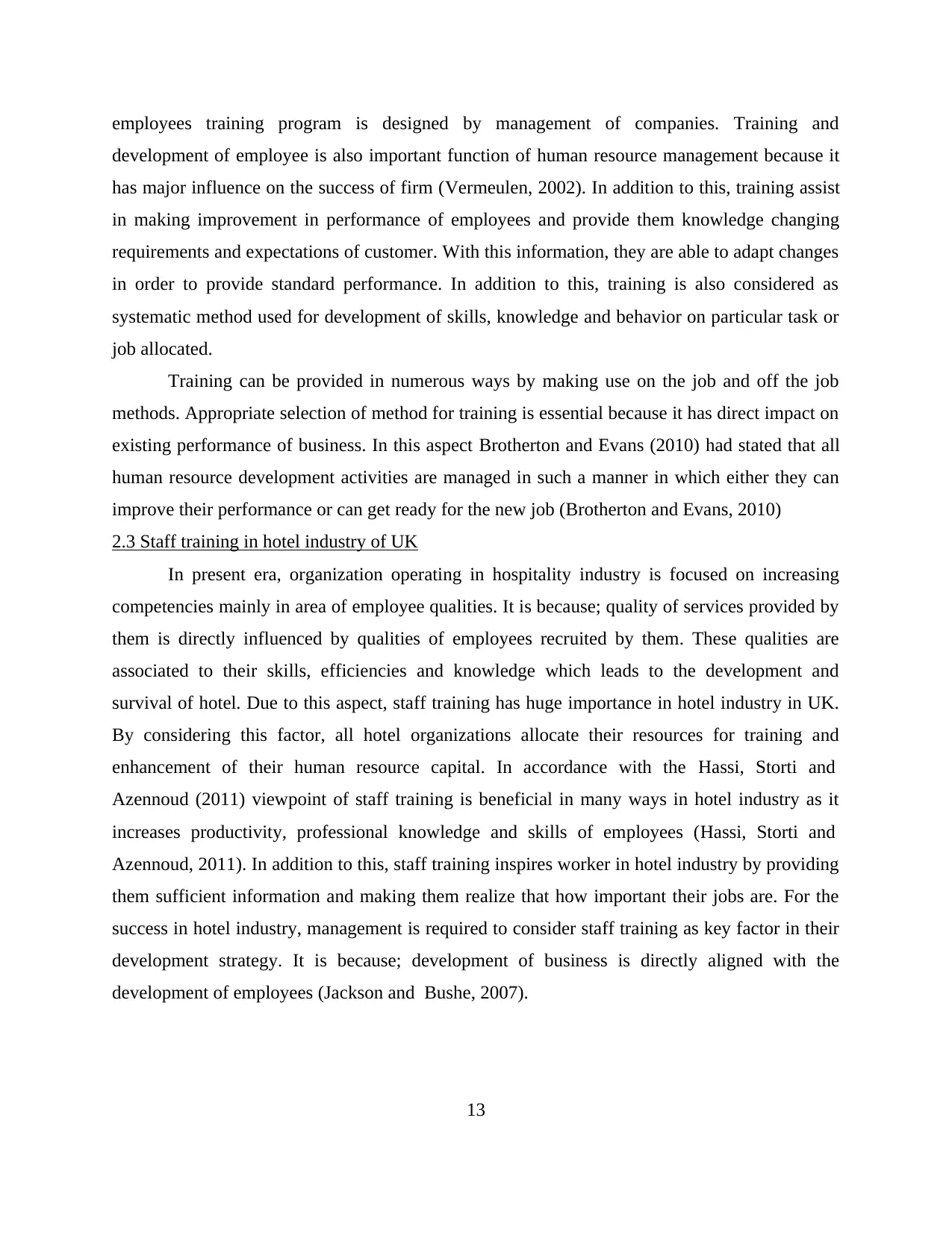
employees training program is designed by management of companies. Training and
development of employee is also important function of human resource management because it
has major influence on the success of firm (Vermeulen, 2002). In addition to this, training assist
in making improvement in performance of employees and provide them knowledge changing
requirements and expectations of customer. With this information, they are able to adapt changes
in order to provide standard performance. In addition to this, training is also considered as
systematic method used for development of skills, knowledge and behavior on particular task or
job allocated.
Training can be provided in numerous ways by making use on the job and off the job
methods. Appropriate selection of method for training is essential because it has direct impact on
existing performance of business. In this aspect Brotherton and Evans (2010) had stated that all
human resource development activities are managed in such a manner in which either they can
improve their performance or can get ready for the new job (Brotherton and Evans, 2010)
2.3 Staff training in hotel industry of UK
In present era, organization operating in hospitality industry is focused on increasing
competencies mainly in area of employee qualities. It is because; quality of services provided by
them is directly influenced by qualities of employees recruited by them. These qualities are
associated to their skills, efficiencies and knowledge which leads to the development and
survival of hotel. Due to this aspect, staff training has huge importance in hotel industry in UK.
By considering this factor, all hotel organizations allocate their resources for training and
enhancement of their human resource capital. In accordance with the Hassi, Storti and
Azennoud (2011) viewpoint of staff training is beneficial in many ways in hotel industry as it
increases productivity, professional knowledge and skills of employees (Hassi, Storti and
Azennoud, 2011). In addition to this, staff training inspires worker in hotel industry by providing
them sufficient information and making them realize that how important their jobs are. For the
success in hotel industry, management is required to consider staff training as key factor in their
development strategy. It is because; development of business is directly aligned with the
development of employees (Jackson and Bushe, 2007).
13
development of employee is also important function of human resource management because it
has major influence on the success of firm (Vermeulen, 2002). In addition to this, training assist
in making improvement in performance of employees and provide them knowledge changing
requirements and expectations of customer. With this information, they are able to adapt changes
in order to provide standard performance. In addition to this, training is also considered as
systematic method used for development of skills, knowledge and behavior on particular task or
job allocated.
Training can be provided in numerous ways by making use on the job and off the job
methods. Appropriate selection of method for training is essential because it has direct impact on
existing performance of business. In this aspect Brotherton and Evans (2010) had stated that all
human resource development activities are managed in such a manner in which either they can
improve their performance or can get ready for the new job (Brotherton and Evans, 2010)
2.3 Staff training in hotel industry of UK
In present era, organization operating in hospitality industry is focused on increasing
competencies mainly in area of employee qualities. It is because; quality of services provided by
them is directly influenced by qualities of employees recruited by them. These qualities are
associated to their skills, efficiencies and knowledge which leads to the development and
survival of hotel. Due to this aspect, staff training has huge importance in hotel industry in UK.
By considering this factor, all hotel organizations allocate their resources for training and
enhancement of their human resource capital. In accordance with the Hassi, Storti and
Azennoud (2011) viewpoint of staff training is beneficial in many ways in hotel industry as it
increases productivity, professional knowledge and skills of employees (Hassi, Storti and
Azennoud, 2011). In addition to this, staff training inspires worker in hotel industry by providing
them sufficient information and making them realize that how important their jobs are. For the
success in hotel industry, management is required to consider staff training as key factor in their
development strategy. It is because; development of business is directly aligned with the
development of employees (Jackson and Bushe, 2007).
13
Secure Best Marks with AI Grader
Need help grading? Try our AI Grader for instant feedback on your assignments.
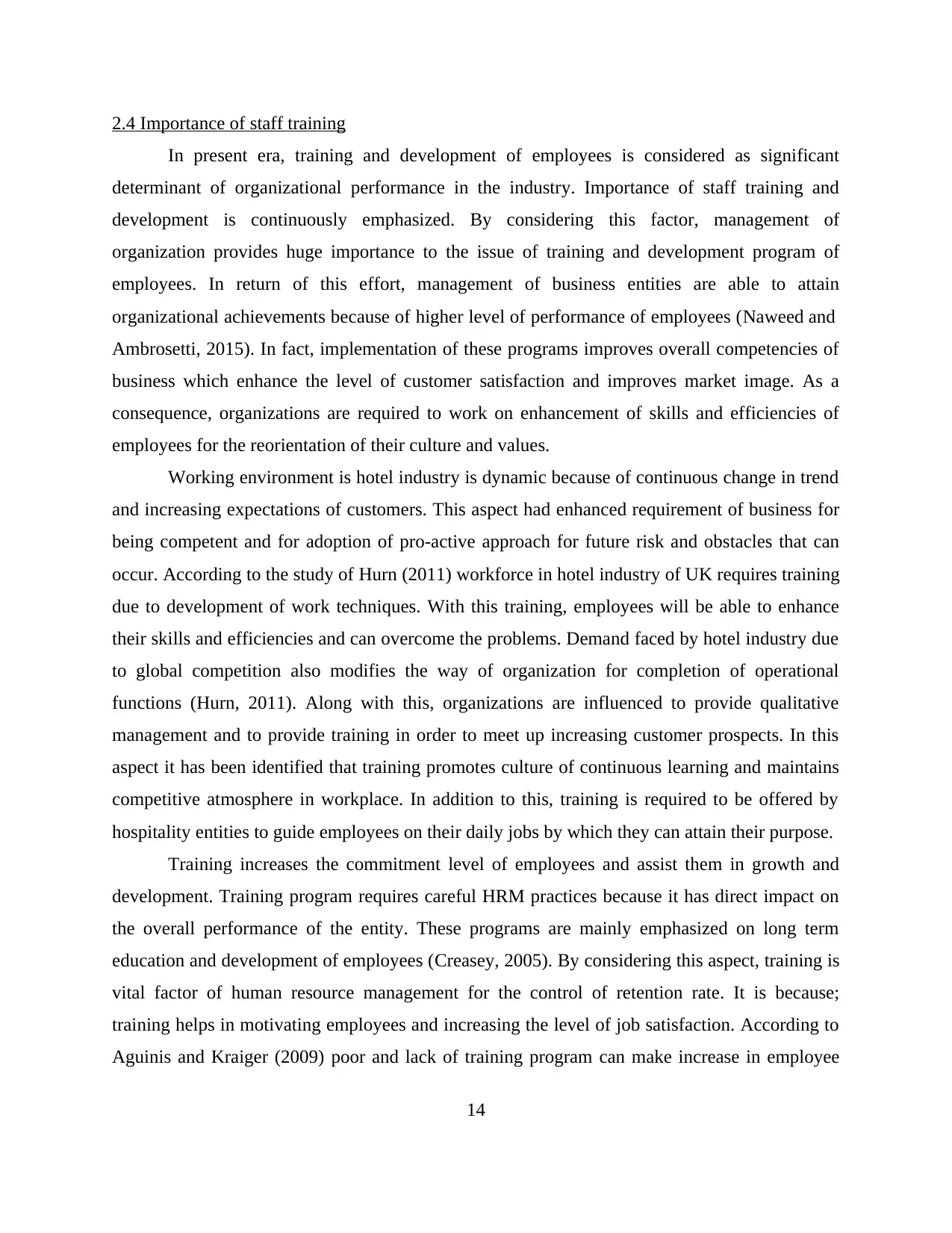
2.4 Importance of staff training
In present era, training and development of employees is considered as significant
determinant of organizational performance in the industry. Importance of staff training and
development is continuously emphasized. By considering this factor, management of
organization provides huge importance to the issue of training and development program of
employees. In return of this effort, management of business entities are able to attain
organizational achievements because of higher level of performance of employees (Naweed and
Ambrosetti, 2015). In fact, implementation of these programs improves overall competencies of
business which enhance the level of customer satisfaction and improves market image. As a
consequence, organizations are required to work on enhancement of skills and efficiencies of
employees for the reorientation of their culture and values.
Working environment is hotel industry is dynamic because of continuous change in trend
and increasing expectations of customers. This aspect had enhanced requirement of business for
being competent and for adoption of pro-active approach for future risk and obstacles that can
occur. According to the study of Hurn (2011) workforce in hotel industry of UK requires training
due to development of work techniques. With this training, employees will be able to enhance
their skills and efficiencies and can overcome the problems. Demand faced by hotel industry due
to global competition also modifies the way of organization for completion of operational
functions (Hurn, 2011). Along with this, organizations are influenced to provide qualitative
management and to provide training in order to meet up increasing customer prospects. In this
aspect it has been identified that training promotes culture of continuous learning and maintains
competitive atmosphere in workplace. In addition to this, training is required to be offered by
hospitality entities to guide employees on their daily jobs by which they can attain their purpose.
Training increases the commitment level of employees and assist them in growth and
development. Training program requires careful HRM practices because it has direct impact on
the overall performance of the entity. These programs are mainly emphasized on long term
education and development of employees (Creasey, 2005). By considering this aspect, training is
vital factor of human resource management for the control of retention rate. It is because;
training helps in motivating employees and increasing the level of job satisfaction. According to
Aguinis and Kraiger (2009) poor and lack of training program can make increase in employee
14
In present era, training and development of employees is considered as significant
determinant of organizational performance in the industry. Importance of staff training and
development is continuously emphasized. By considering this factor, management of
organization provides huge importance to the issue of training and development program of
employees. In return of this effort, management of business entities are able to attain
organizational achievements because of higher level of performance of employees (Naweed and
Ambrosetti, 2015). In fact, implementation of these programs improves overall competencies of
business which enhance the level of customer satisfaction and improves market image. As a
consequence, organizations are required to work on enhancement of skills and efficiencies of
employees for the reorientation of their culture and values.
Working environment is hotel industry is dynamic because of continuous change in trend
and increasing expectations of customers. This aspect had enhanced requirement of business for
being competent and for adoption of pro-active approach for future risk and obstacles that can
occur. According to the study of Hurn (2011) workforce in hotel industry of UK requires training
due to development of work techniques. With this training, employees will be able to enhance
their skills and efficiencies and can overcome the problems. Demand faced by hotel industry due
to global competition also modifies the way of organization for completion of operational
functions (Hurn, 2011). Along with this, organizations are influenced to provide qualitative
management and to provide training in order to meet up increasing customer prospects. In this
aspect it has been identified that training promotes culture of continuous learning and maintains
competitive atmosphere in workplace. In addition to this, training is required to be offered by
hospitality entities to guide employees on their daily jobs by which they can attain their purpose.
Training increases the commitment level of employees and assist them in growth and
development. Training program requires careful HRM practices because it has direct impact on
the overall performance of the entity. These programs are mainly emphasized on long term
education and development of employees (Creasey, 2005). By considering this aspect, training is
vital factor of human resource management for the control of retention rate. It is because;
training helps in motivating employees and increasing the level of job satisfaction. According to
Aguinis and Kraiger (2009) poor and lack of training program can make increase in employee
14

turnover ratio and can make reduction in the quality of substandard product and services
(Aguinis and Kraiger, 2009).
Training program also provides financial benefits to the companies as per the cost benefit
approach. It is because; better performance of employees enhance customer retention and loyalty
by which overall sales and profitability of business is increased. Management of The Morley
Hayes Hotel had made comparison of revenue of before and after training program. By this
assessment, they had concluded the increasing trend in financial values and market ratings. They
had provided training to their employees by considering needs and expectations of their
customers. With this strategy, they were also appreciated by various business magazines and
recommended to their reader with the caption “Perfect time out”.
2.5 Methods for training
There are various methods for training that can be used in hotel industry for the
development of employees. According to the Choo and Bowley (2007) selection of method
generally relies on the aim of training program, type of training intended and trainees selected. A
single universal method for training can be developed because it is a situational approach in
which requirements for training differs in each situation. Process of training design is developed
on the basis of following model:
15
(Aguinis and Kraiger, 2009).
Training program also provides financial benefits to the companies as per the cost benefit
approach. It is because; better performance of employees enhance customer retention and loyalty
by which overall sales and profitability of business is increased. Management of The Morley
Hayes Hotel had made comparison of revenue of before and after training program. By this
assessment, they had concluded the increasing trend in financial values and market ratings. They
had provided training to their employees by considering needs and expectations of their
customers. With this strategy, they were also appreciated by various business magazines and
recommended to their reader with the caption “Perfect time out”.
2.5 Methods for training
There are various methods for training that can be used in hotel industry for the
development of employees. According to the Choo and Bowley (2007) selection of method
generally relies on the aim of training program, type of training intended and trainees selected. A
single universal method for training can be developed because it is a situational approach in
which requirements for training differs in each situation. Process of training design is developed
on the basis of following model:
15
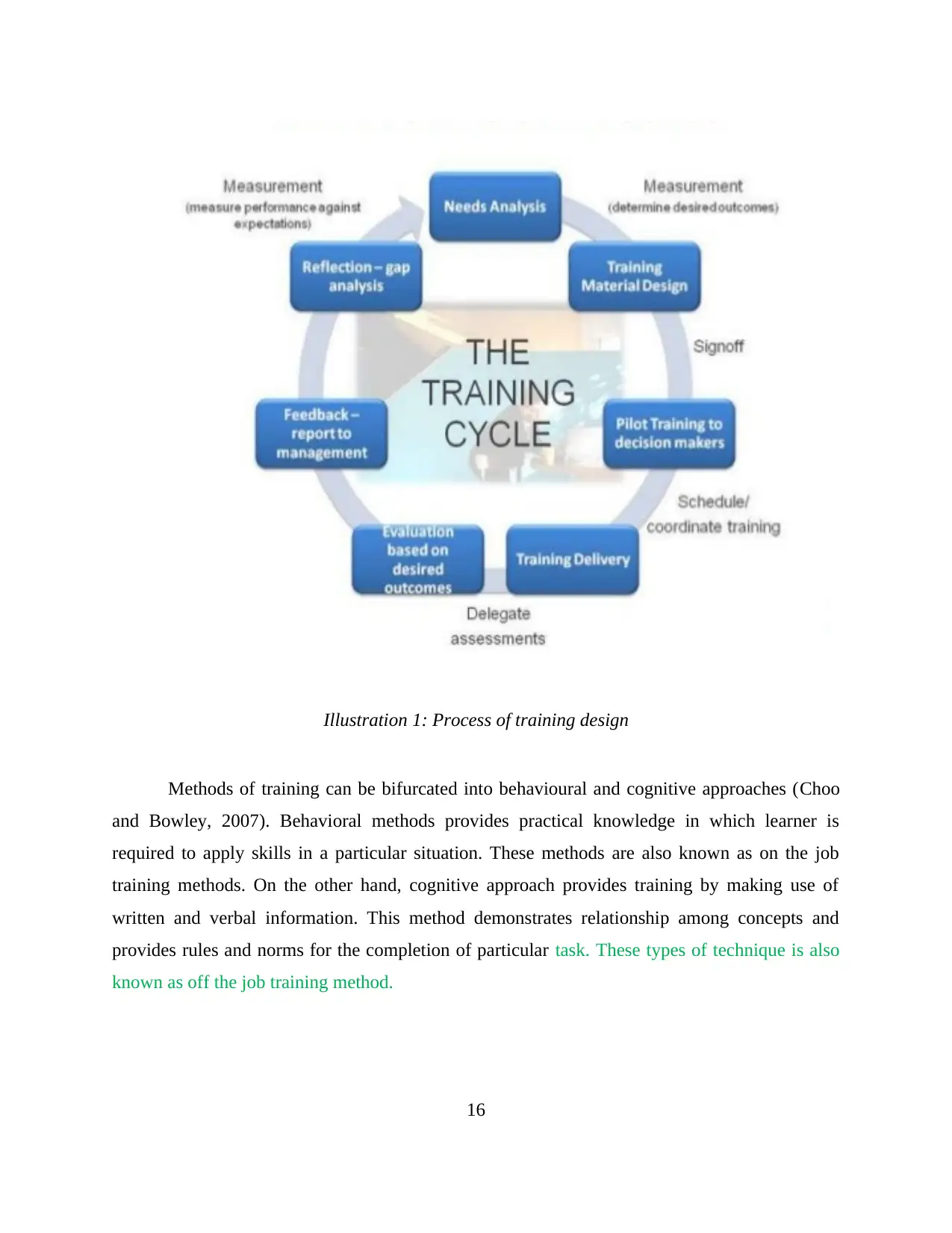
Methods of training can be bifurcated into behavioural and cognitive approaches (Choo
and Bowley, 2007). Behavioral methods provides practical knowledge in which learner is
required to apply skills in a particular situation. These methods are also known as on the job
training methods. On the other hand, cognitive approach provides training by making use of
written and verbal information. This method demonstrates relationship among concepts and
provides rules and norms for the completion of particular task. These types of technique is also
known as off the job training method.
16
Illustration 1: Process of training design
and Bowley, 2007). Behavioral methods provides practical knowledge in which learner is
required to apply skills in a particular situation. These methods are also known as on the job
training methods. On the other hand, cognitive approach provides training by making use of
written and verbal information. This method demonstrates relationship among concepts and
provides rules and norms for the completion of particular task. These types of technique is also
known as off the job training method.
16
Illustration 1: Process of training design
Paraphrase This Document
Need a fresh take? Get an instant paraphrase of this document with our AI Paraphraser
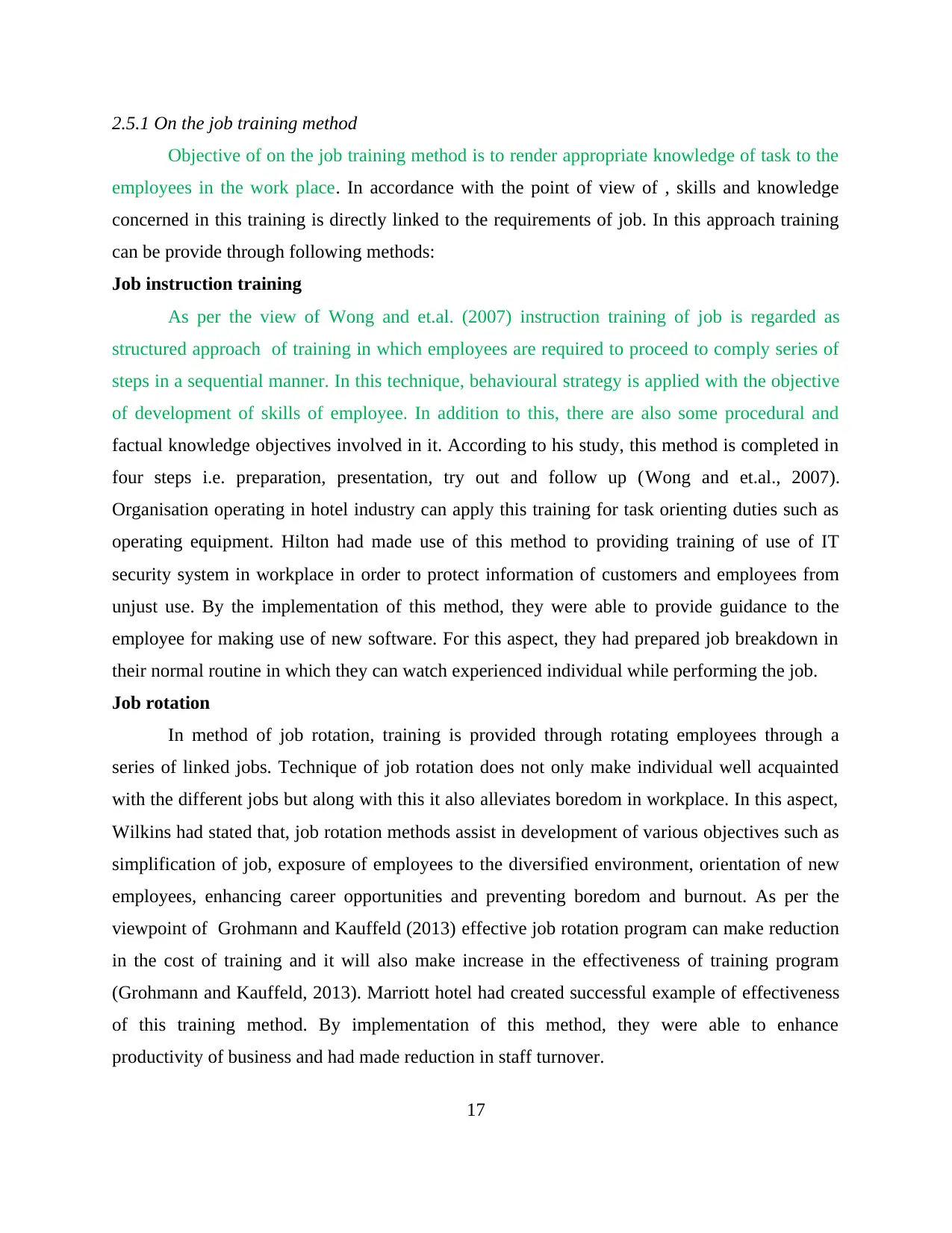
2.5.1 On the job training method
Objective of on the job training method is to render appropriate knowledge of task to the
employees in the work place. In accordance with the point of view of , skills and knowledge
concerned in this training is directly linked to the requirements of job. In this approach training
can be provide through following methods:
Job instruction training
As per the view of Wong and et.al. (2007) instruction training of job is regarded as
structured approach of training in which employees are required to proceed to comply series of
steps in a sequential manner. In this technique, behavioural strategy is applied with the objective
of development of skills of employee. In addition to this, there are also some procedural and
factual knowledge objectives involved in it. According to his study, this method is completed in
four steps i.e. preparation, presentation, try out and follow up (Wong and et.al., 2007).
Organisation operating in hotel industry can apply this training for task orienting duties such as
operating equipment. Hilton had made use of this method to providing training of use of IT
security system in workplace in order to protect information of customers and employees from
unjust use. By the implementation of this method, they were able to provide guidance to the
employee for making use of new software. For this aspect, they had prepared job breakdown in
their normal routine in which they can watch experienced individual while performing the job.
Job rotation
In method of job rotation, training is provided through rotating employees through a
series of linked jobs. Technique of job rotation does not only make individual well acquainted
with the different jobs but along with this it also alleviates boredom in workplace. In this aspect,
Wilkins had stated that, job rotation methods assist in development of various objectives such as
simplification of job, exposure of employees to the diversified environment, orientation of new
employees, enhancing career opportunities and preventing boredom and burnout. As per the
viewpoint of Grohmann and Kauffeld (2013) effective job rotation program can make reduction
in the cost of training and it will also make increase in the effectiveness of training program
(Grohmann and Kauffeld, 2013). Marriott hotel had created successful example of effectiveness
of this training method. By implementation of this method, they were able to enhance
productivity of business and had made reduction in staff turnover.
17
Objective of on the job training method is to render appropriate knowledge of task to the
employees in the work place. In accordance with the point of view of , skills and knowledge
concerned in this training is directly linked to the requirements of job. In this approach training
can be provide through following methods:
Job instruction training
As per the view of Wong and et.al. (2007) instruction training of job is regarded as
structured approach of training in which employees are required to proceed to comply series of
steps in a sequential manner. In this technique, behavioural strategy is applied with the objective
of development of skills of employee. In addition to this, there are also some procedural and
factual knowledge objectives involved in it. According to his study, this method is completed in
four steps i.e. preparation, presentation, try out and follow up (Wong and et.al., 2007).
Organisation operating in hotel industry can apply this training for task orienting duties such as
operating equipment. Hilton had made use of this method to providing training of use of IT
security system in workplace in order to protect information of customers and employees from
unjust use. By the implementation of this method, they were able to provide guidance to the
employee for making use of new software. For this aspect, they had prepared job breakdown in
their normal routine in which they can watch experienced individual while performing the job.
Job rotation
In method of job rotation, training is provided through rotating employees through a
series of linked jobs. Technique of job rotation does not only make individual well acquainted
with the different jobs but along with this it also alleviates boredom in workplace. In this aspect,
Wilkins had stated that, job rotation methods assist in development of various objectives such as
simplification of job, exposure of employees to the diversified environment, orientation of new
employees, enhancing career opportunities and preventing boredom and burnout. As per the
viewpoint of Grohmann and Kauffeld (2013) effective job rotation program can make reduction
in the cost of training and it will also make increase in the effectiveness of training program
(Grohmann and Kauffeld, 2013). Marriott hotel had created successful example of effectiveness
of this training method. By implementation of this method, they were able to enhance
productivity of business and had made reduction in staff turnover.
17
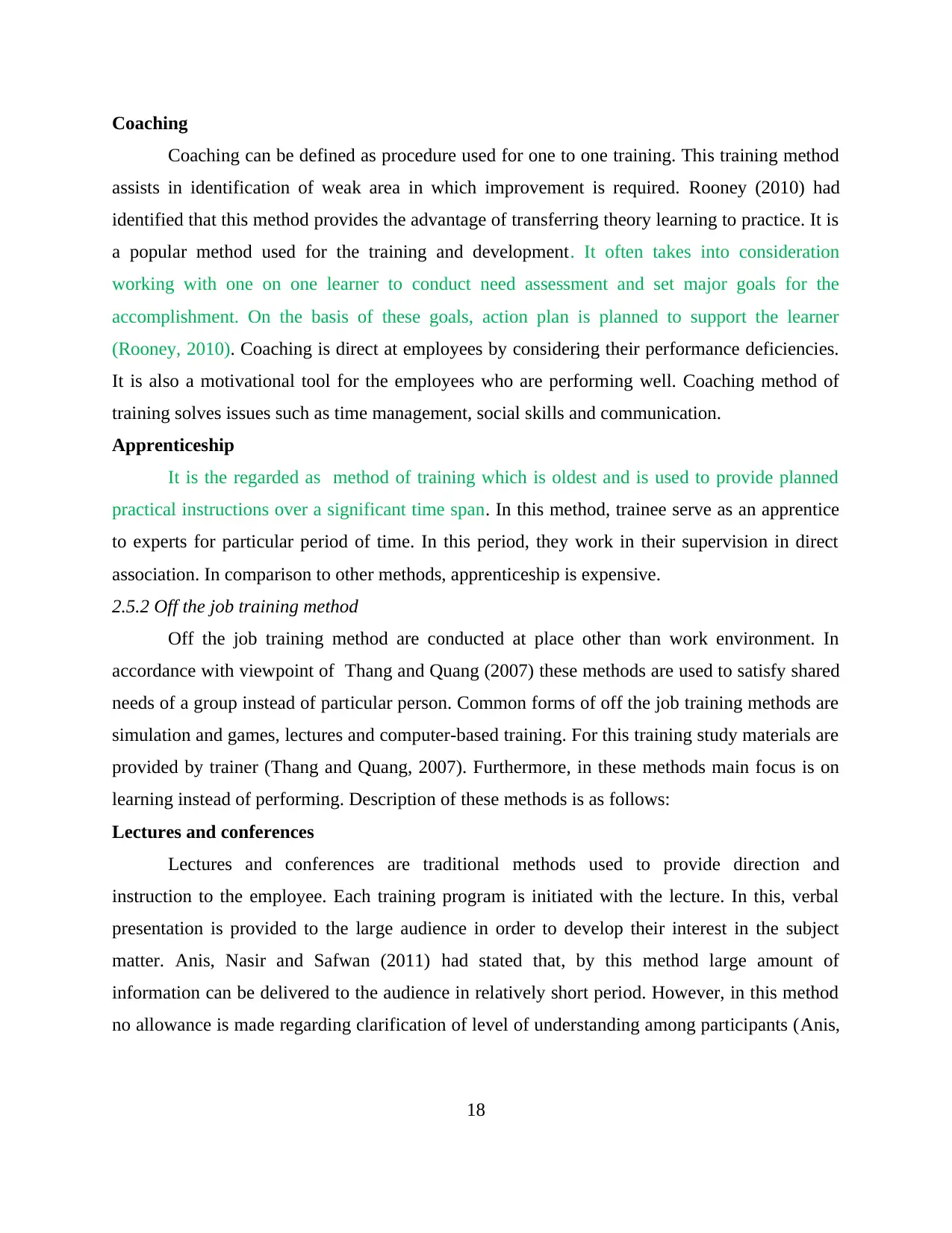
Coaching
Coaching can be defined as procedure used for one to one training. This training method
assists in identification of weak area in which improvement is required. Rooney (2010) had
identified that this method provides the advantage of transferring theory learning to practice. It is
a popular method used for the training and development. It often takes into consideration
working with one on one learner to conduct need assessment and set major goals for the
accomplishment. On the basis of these goals, action plan is planned to support the learner
(Rooney, 2010). Coaching is direct at employees by considering their performance deficiencies.
It is also a motivational tool for the employees who are performing well. Coaching method of
training solves issues such as time management, social skills and communication.
Apprenticeship
It is the regarded as method of training which is oldest and is used to provide planned
practical instructions over a significant time span. In this method, trainee serve as an apprentice
to experts for particular period of time. In this period, they work in their supervision in direct
association. In comparison to other methods, apprenticeship is expensive.
2.5.2 Off the job training method
Off the job training method are conducted at place other than work environment. In
accordance with viewpoint of Thang and Quang (2007) these methods are used to satisfy shared
needs of a group instead of particular person. Common forms of off the job training methods are
simulation and games, lectures and computer-based training. For this training study materials are
provided by trainer (Thang and Quang, 2007). Furthermore, in these methods main focus is on
learning instead of performing. Description of these methods is as follows:
Lectures and conferences
Lectures and conferences are traditional methods used to provide direction and
instruction to the employee. Each training program is initiated with the lecture. In this, verbal
presentation is provided to the large audience in order to develop their interest in the subject
matter. Anis, Nasir and Safwan (2011) had stated that, by this method large amount of
information can be delivered to the audience in relatively short period. However, in this method
no allowance is made regarding clarification of level of understanding among participants (Anis,
18
Coaching can be defined as procedure used for one to one training. This training method
assists in identification of weak area in which improvement is required. Rooney (2010) had
identified that this method provides the advantage of transferring theory learning to practice. It is
a popular method used for the training and development. It often takes into consideration
working with one on one learner to conduct need assessment and set major goals for the
accomplishment. On the basis of these goals, action plan is planned to support the learner
(Rooney, 2010). Coaching is direct at employees by considering their performance deficiencies.
It is also a motivational tool for the employees who are performing well. Coaching method of
training solves issues such as time management, social skills and communication.
Apprenticeship
It is the regarded as method of training which is oldest and is used to provide planned
practical instructions over a significant time span. In this method, trainee serve as an apprentice
to experts for particular period of time. In this period, they work in their supervision in direct
association. In comparison to other methods, apprenticeship is expensive.
2.5.2 Off the job training method
Off the job training method are conducted at place other than work environment. In
accordance with viewpoint of Thang and Quang (2007) these methods are used to satisfy shared
needs of a group instead of particular person. Common forms of off the job training methods are
simulation and games, lectures and computer-based training. For this training study materials are
provided by trainer (Thang and Quang, 2007). Furthermore, in these methods main focus is on
learning instead of performing. Description of these methods is as follows:
Lectures and conferences
Lectures and conferences are traditional methods used to provide direction and
instruction to the employee. Each training program is initiated with the lecture. In this, verbal
presentation is provided to the large audience in order to develop their interest in the subject
matter. Anis, Nasir and Safwan (2011) had stated that, by this method large amount of
information can be delivered to the audience in relatively short period. However, in this method
no allowance is made regarding clarification of level of understanding among participants (Anis,
18

Nasir and Safwan, 2011). It is because; trainees does not have active participation. If objective of
training is only to provide factual information then it can also be provided through text material.
Computer based training
In this method trainings are provided by making use of digital technology. This method
training is used in alternation to the class room training. According to the McGrath (2012)
method of computer based training makes reduction in cost and time consumption. In addition to
this, this method also provide instructional consistency and keep interest and motivation of
learner high (McGrath, 2012). The most significant advantage of this method is to keep control
on the content of the training, movement of trainee and method of presentation. Furthermore, e-
learning makes reduction in the drawback of distance issues. It is because, training can be
conducted even if trainer is not physically present in the classroom.
Vestibule training
This method can also be termed as near the job training. In this method, training of the
employees of the company takes place in an environment which is of prototype nature. For this
aspect, the organization strives to provide working condition similar to the actual work place.
After the completion of this training, hotel entities can recruit their employees for such similar
jobs. Duration ranges of this training program from few days to few weeks. Grance Group of
Hotels used this method in their orientation program to provide training to the recruited
candidates. By the applicability of this training method they provide guidance to new employees
for standard performance expected from them. By the completion of this program, recruited
candidates are transferred to the similar job. In this manner, they are able to attain practical
understanding for the job allocated to them. According to, Frazis and Loewenstein (2007)
vestibule training is the best method for providing practical guidelines and reducing nervousness
of employees. It is because; they already had faced such situation in dummy work environment
and by that experience employees are able to provide appropriate performance (Frazis and
Loewenstein, 2007). This approach also prevent trainees from conduct of severe mistakes in
actual situation.
Simulation and games
Training through games and simulation is designed for the reproduction of event,
procedure and situation that can be occurred in the job of the trainee's. In this method, trainees
19
training is only to provide factual information then it can also be provided through text material.
Computer based training
In this method trainings are provided by making use of digital technology. This method
training is used in alternation to the class room training. According to the McGrath (2012)
method of computer based training makes reduction in cost and time consumption. In addition to
this, this method also provide instructional consistency and keep interest and motivation of
learner high (McGrath, 2012). The most significant advantage of this method is to keep control
on the content of the training, movement of trainee and method of presentation. Furthermore, e-
learning makes reduction in the drawback of distance issues. It is because, training can be
conducted even if trainer is not physically present in the classroom.
Vestibule training
This method can also be termed as near the job training. In this method, training of the
employees of the company takes place in an environment which is of prototype nature. For this
aspect, the organization strives to provide working condition similar to the actual work place.
After the completion of this training, hotel entities can recruit their employees for such similar
jobs. Duration ranges of this training program from few days to few weeks. Grance Group of
Hotels used this method in their orientation program to provide training to the recruited
candidates. By the applicability of this training method they provide guidance to new employees
for standard performance expected from them. By the completion of this program, recruited
candidates are transferred to the similar job. In this manner, they are able to attain practical
understanding for the job allocated to them. According to, Frazis and Loewenstein (2007)
vestibule training is the best method for providing practical guidelines and reducing nervousness
of employees. It is because; they already had faced such situation in dummy work environment
and by that experience employees are able to provide appropriate performance (Frazis and
Loewenstein, 2007). This approach also prevent trainees from conduct of severe mistakes in
actual situation.
Simulation and games
Training through games and simulation is designed for the reproduction of event,
procedure and situation that can be occurred in the job of the trainee's. In this method, trainees
19
Secure Best Marks with AI Grader
Need help grading? Try our AI Grader for instant feedback on your assignments.
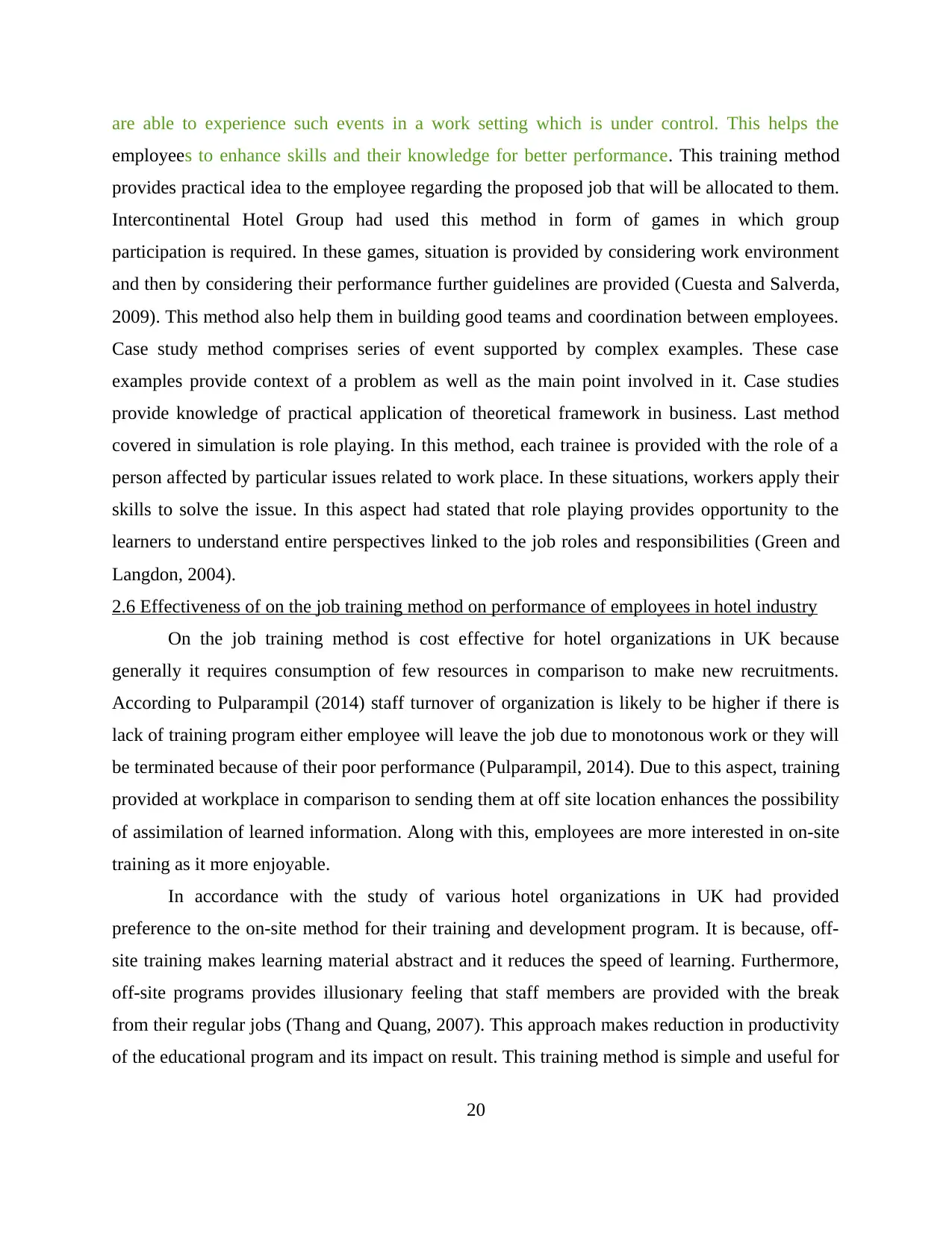
are able to experience such events in a work setting which is under control. This helps the
employees to enhance skills and their knowledge for better performance. This training method
provides practical idea to the employee regarding the proposed job that will be allocated to them.
Intercontinental Hotel Group had used this method in form of games in which group
participation is required. In these games, situation is provided by considering work environment
and then by considering their performance further guidelines are provided (Cuesta and Salverda,
2009). This method also help them in building good teams and coordination between employees.
Case study method comprises series of event supported by complex examples. These case
examples provide context of a problem as well as the main point involved in it. Case studies
provide knowledge of practical application of theoretical framework in business. Last method
covered in simulation is role playing. In this method, each trainee is provided with the role of a
person affected by particular issues related to work place. In these situations, workers apply their
skills to solve the issue. In this aspect had stated that role playing provides opportunity to the
learners to understand entire perspectives linked to the job roles and responsibilities (Green and
Langdon, 2004).
2.6 Effectiveness of on the job training method on performance of employees in hotel industry
On the job training method is cost effective for hotel organizations in UK because
generally it requires consumption of few resources in comparison to make new recruitments.
According to Pulparampil (2014) staff turnover of organization is likely to be higher if there is
lack of training program either employee will leave the job due to monotonous work or they will
be terminated because of their poor performance (Pulparampil, 2014). Due to this aspect, training
provided at workplace in comparison to sending them at off site location enhances the possibility
of assimilation of learned information. Along with this, employees are more interested in on-site
training as it more enjoyable.
In accordance with the study of various hotel organizations in UK had provided
preference to the on-site method for their training and development program. It is because, off-
site training makes learning material abstract and it reduces the speed of learning. Furthermore,
off-site programs provides illusionary feeling that staff members are provided with the break
from their regular jobs (Thang and Quang, 2007). This approach makes reduction in productivity
of the educational program and its impact on result. This training method is simple and useful for
20
employees to enhance skills and their knowledge for better performance. This training method
provides practical idea to the employee regarding the proposed job that will be allocated to them.
Intercontinental Hotel Group had used this method in form of games in which group
participation is required. In these games, situation is provided by considering work environment
and then by considering their performance further guidelines are provided (Cuesta and Salverda,
2009). This method also help them in building good teams and coordination between employees.
Case study method comprises series of event supported by complex examples. These case
examples provide context of a problem as well as the main point involved in it. Case studies
provide knowledge of practical application of theoretical framework in business. Last method
covered in simulation is role playing. In this method, each trainee is provided with the role of a
person affected by particular issues related to work place. In these situations, workers apply their
skills to solve the issue. In this aspect had stated that role playing provides opportunity to the
learners to understand entire perspectives linked to the job roles and responsibilities (Green and
Langdon, 2004).
2.6 Effectiveness of on the job training method on performance of employees in hotel industry
On the job training method is cost effective for hotel organizations in UK because
generally it requires consumption of few resources in comparison to make new recruitments.
According to Pulparampil (2014) staff turnover of organization is likely to be higher if there is
lack of training program either employee will leave the job due to monotonous work or they will
be terminated because of their poor performance (Pulparampil, 2014). Due to this aspect, training
provided at workplace in comparison to sending them at off site location enhances the possibility
of assimilation of learned information. Along with this, employees are more interested in on-site
training as it more enjoyable.
In accordance with the study of various hotel organizations in UK had provided
preference to the on-site method for their training and development program. It is because, off-
site training makes learning material abstract and it reduces the speed of learning. Furthermore,
off-site programs provides illusionary feeling that staff members are provided with the break
from their regular jobs (Thang and Quang, 2007). This approach makes reduction in productivity
of the educational program and its impact on result. This training method is simple and useful for
20
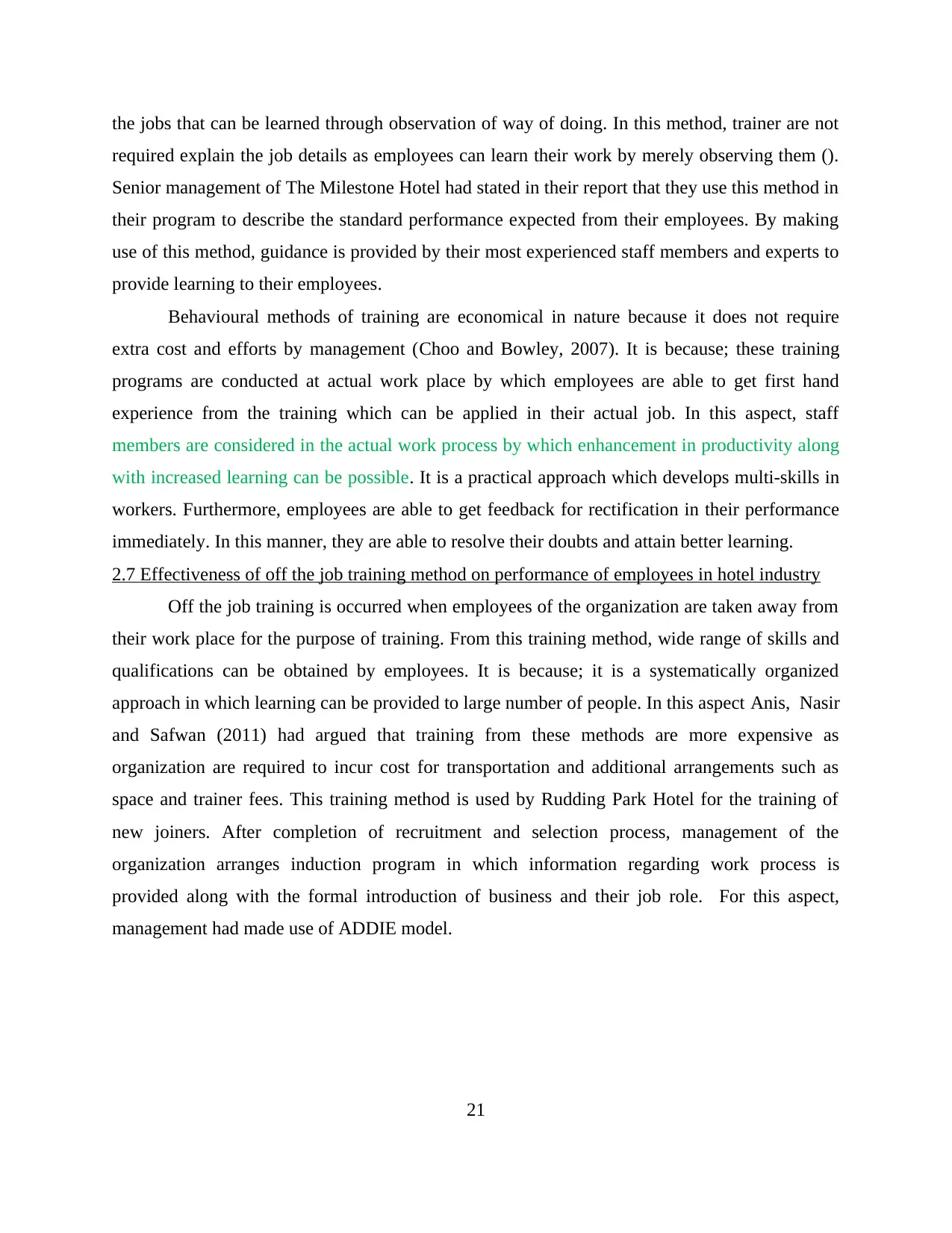
the jobs that can be learned through observation of way of doing. In this method, trainer are not
required explain the job details as employees can learn their work by merely observing them ().
Senior management of The Milestone Hotel had stated in their report that they use this method in
their program to describe the standard performance expected from their employees. By making
use of this method, guidance is provided by their most experienced staff members and experts to
provide learning to their employees.
Behavioural methods of training are economical in nature because it does not require
extra cost and efforts by management (Choo and Bowley, 2007). It is because; these training
programs are conducted at actual work place by which employees are able to get first hand
experience from the training which can be applied in their actual job. In this aspect, staff
members are considered in the actual work process by which enhancement in productivity along
with increased learning can be possible. It is a practical approach which develops multi-skills in
workers. Furthermore, employees are able to get feedback for rectification in their performance
immediately. In this manner, they are able to resolve their doubts and attain better learning.
2.7 Effectiveness of off the job training method on performance of employees in hotel industry
Off the job training is occurred when employees of the organization are taken away from
their work place for the purpose of training. From this training method, wide range of skills and
qualifications can be obtained by employees. It is because; it is a systematically organized
approach in which learning can be provided to large number of people. In this aspect Anis, Nasir
and Safwan (2011) had argued that training from these methods are more expensive as
organization are required to incur cost for transportation and additional arrangements such as
space and trainer fees. This training method is used by Rudding Park Hotel for the training of
new joiners. After completion of recruitment and selection process, management of the
organization arranges induction program in which information regarding work process is
provided along with the formal introduction of business and their job role. For this aspect,
management had made use of ADDIE model.
21
required explain the job details as employees can learn their work by merely observing them ().
Senior management of The Milestone Hotel had stated in their report that they use this method in
their program to describe the standard performance expected from their employees. By making
use of this method, guidance is provided by their most experienced staff members and experts to
provide learning to their employees.
Behavioural methods of training are economical in nature because it does not require
extra cost and efforts by management (Choo and Bowley, 2007). It is because; these training
programs are conducted at actual work place by which employees are able to get first hand
experience from the training which can be applied in their actual job. In this aspect, staff
members are considered in the actual work process by which enhancement in productivity along
with increased learning can be possible. It is a practical approach which develops multi-skills in
workers. Furthermore, employees are able to get feedback for rectification in their performance
immediately. In this manner, they are able to resolve their doubts and attain better learning.
2.7 Effectiveness of off the job training method on performance of employees in hotel industry
Off the job training is occurred when employees of the organization are taken away from
their work place for the purpose of training. From this training method, wide range of skills and
qualifications can be obtained by employees. It is because; it is a systematically organized
approach in which learning can be provided to large number of people. In this aspect Anis, Nasir
and Safwan (2011) had argued that training from these methods are more expensive as
organization are required to incur cost for transportation and additional arrangements such as
space and trainer fees. This training method is used by Rudding Park Hotel for the training of
new joiners. After completion of recruitment and selection process, management of the
organization arranges induction program in which information regarding work process is
provided along with the formal introduction of business and their job role. For this aspect,
management had made use of ADDIE model.
21
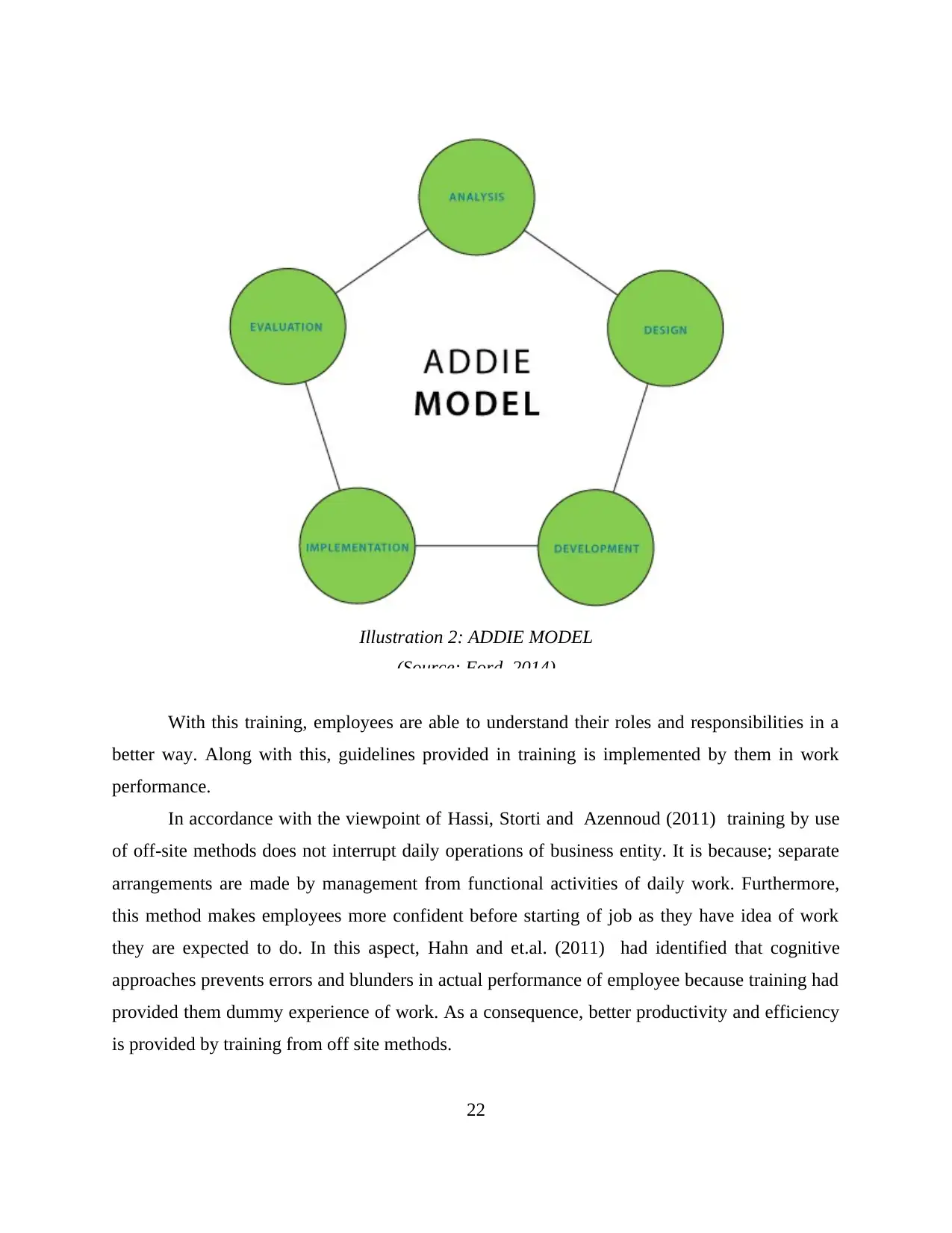
With this training, employees are able to understand their roles and responsibilities in a
better way. Along with this, guidelines provided in training is implemented by them in work
performance.
In accordance with the viewpoint of Hassi, Storti and Azennoud (2011) training by use
of off-site methods does not interrupt daily operations of business entity. It is because; separate
arrangements are made by management from functional activities of daily work. Furthermore,
this method makes employees more confident before starting of job as they have idea of work
they are expected to do. In this aspect, Hahn and et.al. (2011) had identified that cognitive
approaches prevents errors and blunders in actual performance of employee because training had
provided them dummy experience of work. As a consequence, better productivity and efficiency
is provided by training from off site methods.
22
Illustration 2: ADDIE MODEL
(Source: Ford, 2014)
better way. Along with this, guidelines provided in training is implemented by them in work
performance.
In accordance with the viewpoint of Hassi, Storti and Azennoud (2011) training by use
of off-site methods does not interrupt daily operations of business entity. It is because; separate
arrangements are made by management from functional activities of daily work. Furthermore,
this method makes employees more confident before starting of job as they have idea of work
they are expected to do. In this aspect, Hahn and et.al. (2011) had identified that cognitive
approaches prevents errors and blunders in actual performance of employee because training had
provided them dummy experience of work. As a consequence, better productivity and efficiency
is provided by training from off site methods.
22
Illustration 2: ADDIE MODEL
(Source: Ford, 2014)
Paraphrase This Document
Need a fresh take? Get an instant paraphrase of this document with our AI Paraphraser
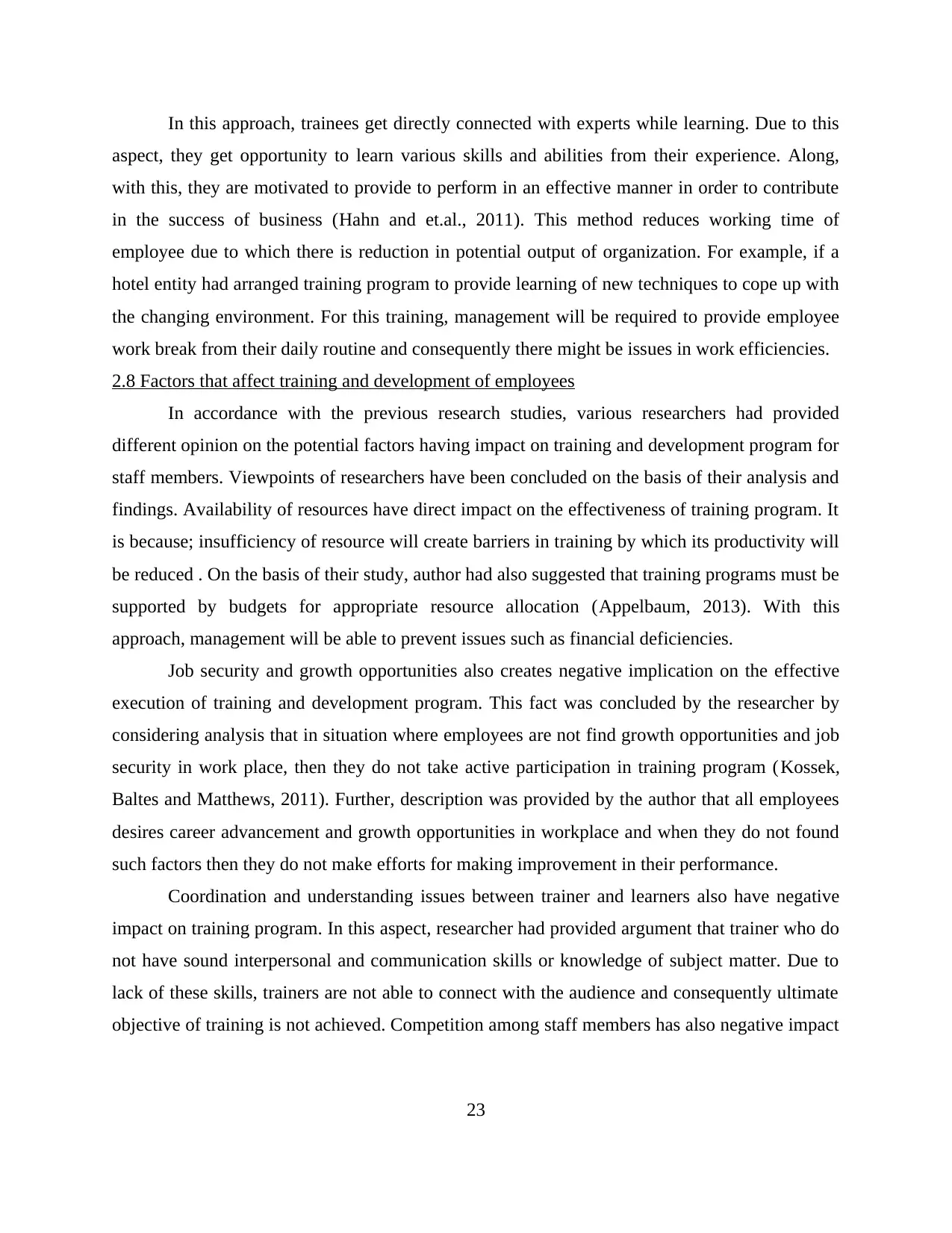
In this approach, trainees get directly connected with experts while learning. Due to this
aspect, they get opportunity to learn various skills and abilities from their experience. Along,
with this, they are motivated to provide to perform in an effective manner in order to contribute
in the success of business (Hahn and et.al., 2011). This method reduces working time of
employee due to which there is reduction in potential output of organization. For example, if a
hotel entity had arranged training program to provide learning of new techniques to cope up with
the changing environment. For this training, management will be required to provide employee
work break from their daily routine and consequently there might be issues in work efficiencies.
2.8 Factors that affect training and development of employees
In accordance with the previous research studies, various researchers had provided
different opinion on the potential factors having impact on training and development program for
staff members. Viewpoints of researchers have been concluded on the basis of their analysis and
findings. Availability of resources have direct impact on the effectiveness of training program. It
is because; insufficiency of resource will create barriers in training by which its productivity will
be reduced . On the basis of their study, author had also suggested that training programs must be
supported by budgets for appropriate resource allocation (Appelbaum, 2013). With this
approach, management will be able to prevent issues such as financial deficiencies.
Job security and growth opportunities also creates negative implication on the effective
execution of training and development program. This fact was concluded by the researcher by
considering analysis that in situation where employees are not find growth opportunities and job
security in work place, then they do not take active participation in training program (Kossek,
Baltes and Matthews, 2011). Further, description was provided by the author that all employees
desires career advancement and growth opportunities in workplace and when they do not found
such factors then they do not make efforts for making improvement in their performance.
Coordination and understanding issues between trainer and learners also have negative
impact on training program. In this aspect, researcher had provided argument that trainer who do
not have sound interpersonal and communication skills or knowledge of subject matter. Due to
lack of these skills, trainers are not able to connect with the audience and consequently ultimate
objective of training is not achieved. Competition among staff members has also negative impact
23
aspect, they get opportunity to learn various skills and abilities from their experience. Along,
with this, they are motivated to provide to perform in an effective manner in order to contribute
in the success of business (Hahn and et.al., 2011). This method reduces working time of
employee due to which there is reduction in potential output of organization. For example, if a
hotel entity had arranged training program to provide learning of new techniques to cope up with
the changing environment. For this training, management will be required to provide employee
work break from their daily routine and consequently there might be issues in work efficiencies.
2.8 Factors that affect training and development of employees
In accordance with the previous research studies, various researchers had provided
different opinion on the potential factors having impact on training and development program for
staff members. Viewpoints of researchers have been concluded on the basis of their analysis and
findings. Availability of resources have direct impact on the effectiveness of training program. It
is because; insufficiency of resource will create barriers in training by which its productivity will
be reduced . On the basis of their study, author had also suggested that training programs must be
supported by budgets for appropriate resource allocation (Appelbaum, 2013). With this
approach, management will be able to prevent issues such as financial deficiencies.
Job security and growth opportunities also creates negative implication on the effective
execution of training and development program. This fact was concluded by the researcher by
considering analysis that in situation where employees are not find growth opportunities and job
security in work place, then they do not take active participation in training program (Kossek,
Baltes and Matthews, 2011). Further, description was provided by the author that all employees
desires career advancement and growth opportunities in workplace and when they do not found
such factors then they do not make efforts for making improvement in their performance.
Coordination and understanding issues between trainer and learners also have negative
impact on training program. In this aspect, researcher had provided argument that trainer who do
not have sound interpersonal and communication skills or knowledge of subject matter. Due to
lack of these skills, trainers are not able to connect with the audience and consequently ultimate
objective of training is not achieved. Competition among staff members has also negative impact
23
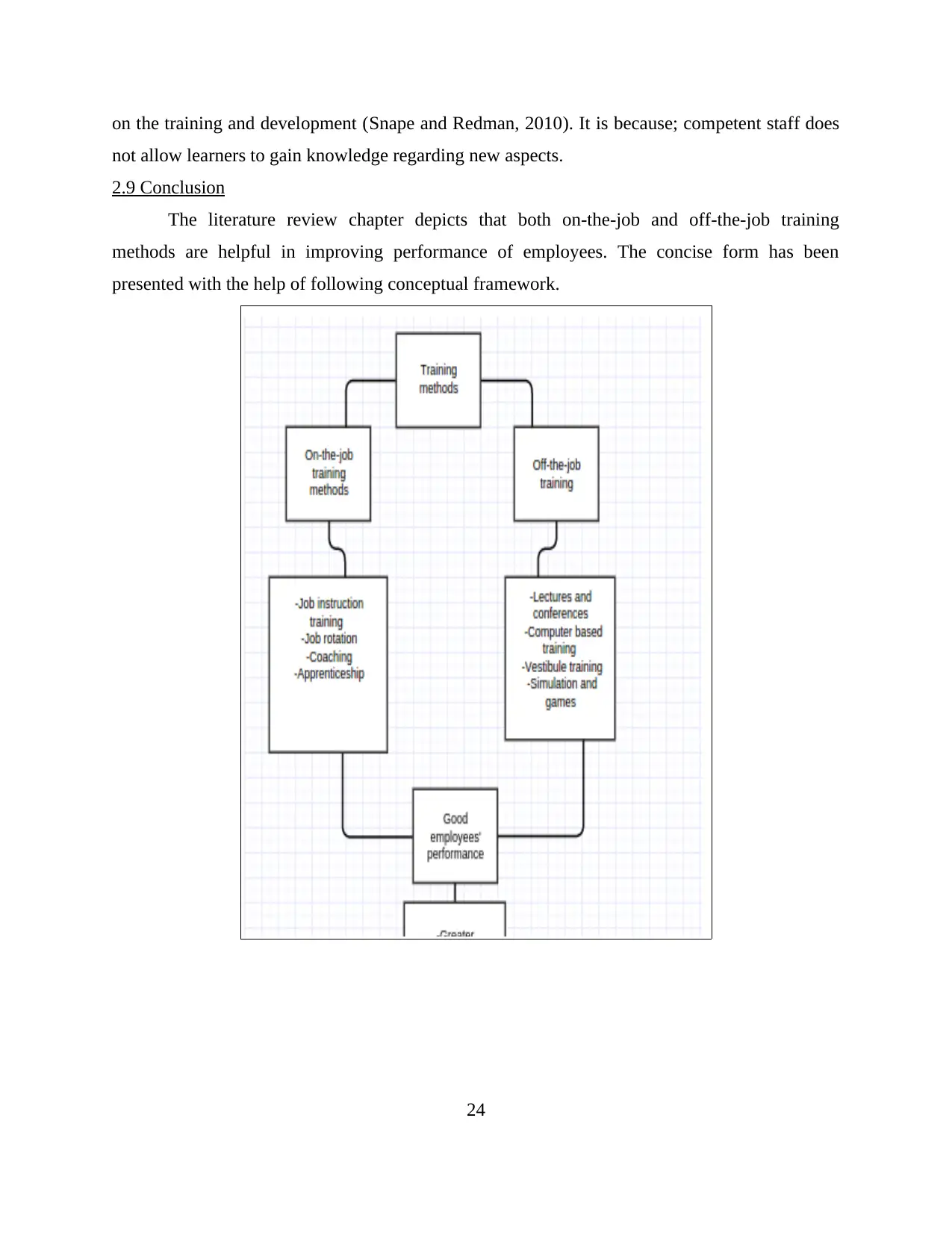
on the training and development (Snape and Redman, 2010). It is because; competent staff does
not allow learners to gain knowledge regarding new aspects.
2.9 Conclusion
The literature review chapter depicts that both on-the-job and off-the-job training
methods are helpful in improving performance of employees. The concise form has been
presented with the help of following conceptual framework.
24
I
not allow learners to gain knowledge regarding new aspects.
2.9 Conclusion
The literature review chapter depicts that both on-the-job and off-the-job training
methods are helpful in improving performance of employees. The concise form has been
presented with the help of following conceptual framework.
24
I
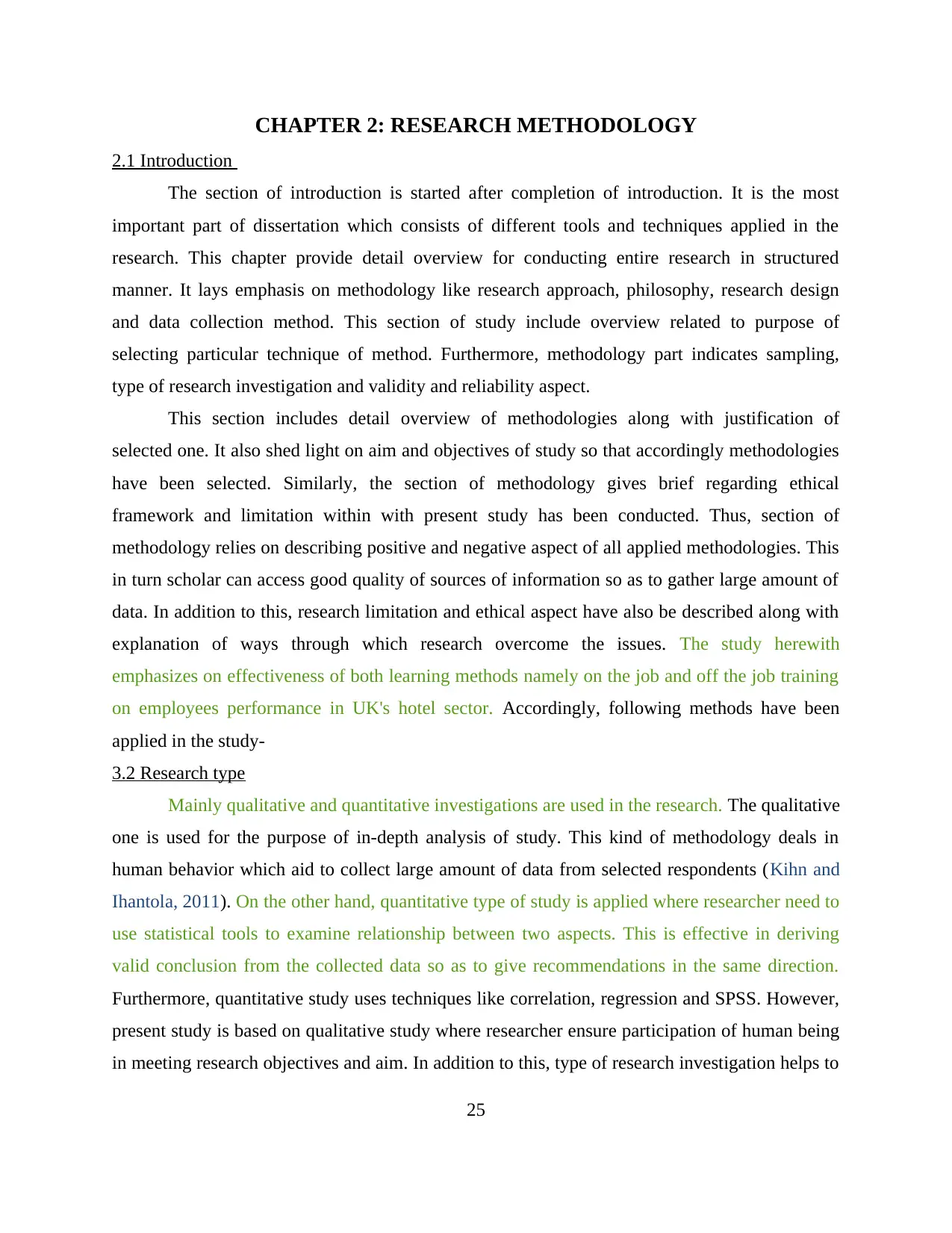
CHAPTER 2: RESEARCH METHODOLOGY
2.1 Introduction
The section of introduction is started after completion of introduction. It is the most
important part of dissertation which consists of different tools and techniques applied in the
research. This chapter provide detail overview for conducting entire research in structured
manner. It lays emphasis on methodology like research approach, philosophy, research design
and data collection method. This section of study include overview related to purpose of
selecting particular technique of method. Furthermore, methodology part indicates sampling,
type of research investigation and validity and reliability aspect.
This section includes detail overview of methodologies along with justification of
selected one. It also shed light on aim and objectives of study so that accordingly methodologies
have been selected. Similarly, the section of methodology gives brief regarding ethical
framework and limitation within with present study has been conducted. Thus, section of
methodology relies on describing positive and negative aspect of all applied methodologies. This
in turn scholar can access good quality of sources of information so as to gather large amount of
data. In addition to this, research limitation and ethical aspect have also be described along with
explanation of ways through which research overcome the issues. The study herewith
emphasizes on effectiveness of both learning methods namely on the job and off the job training
on employees performance in UK's hotel sector. Accordingly, following methods have been
applied in the study-
3.2 Research type
Mainly qualitative and quantitative investigations are used in the research. The qualitative
one is used for the purpose of in-depth analysis of study. This kind of methodology deals in
human behavior which aid to collect large amount of data from selected respondents (Kihn and
Ihantola, 2011). On the other hand, quantitative type of study is applied where researcher need to
use statistical tools to examine relationship between two aspects. This is effective in deriving
valid conclusion from the collected data so as to give recommendations in the same direction.
Furthermore, quantitative study uses techniques like correlation, regression and SPSS. However,
present study is based on qualitative study where researcher ensure participation of human being
in meeting research objectives and aim. In addition to this, type of research investigation helps to
25
2.1 Introduction
The section of introduction is started after completion of introduction. It is the most
important part of dissertation which consists of different tools and techniques applied in the
research. This chapter provide detail overview for conducting entire research in structured
manner. It lays emphasis on methodology like research approach, philosophy, research design
and data collection method. This section of study include overview related to purpose of
selecting particular technique of method. Furthermore, methodology part indicates sampling,
type of research investigation and validity and reliability aspect.
This section includes detail overview of methodologies along with justification of
selected one. It also shed light on aim and objectives of study so that accordingly methodologies
have been selected. Similarly, the section of methodology gives brief regarding ethical
framework and limitation within with present study has been conducted. Thus, section of
methodology relies on describing positive and negative aspect of all applied methodologies. This
in turn scholar can access good quality of sources of information so as to gather large amount of
data. In addition to this, research limitation and ethical aspect have also be described along with
explanation of ways through which research overcome the issues. The study herewith
emphasizes on effectiveness of both learning methods namely on the job and off the job training
on employees performance in UK's hotel sector. Accordingly, following methods have been
applied in the study-
3.2 Research type
Mainly qualitative and quantitative investigations are used in the research. The qualitative
one is used for the purpose of in-depth analysis of study. This kind of methodology deals in
human behavior which aid to collect large amount of data from selected respondents (Kihn and
Ihantola, 2011). On the other hand, quantitative type of study is applied where researcher need to
use statistical tools to examine relationship between two aspects. This is effective in deriving
valid conclusion from the collected data so as to give recommendations in the same direction.
Furthermore, quantitative study uses techniques like correlation, regression and SPSS. However,
present study is based on qualitative study where researcher ensure participation of human being
in meeting research objectives and aim. In addition to this, type of research investigation helps to
25
Secure Best Marks with AI Grader
Need help grading? Try our AI Grader for instant feedback on your assignments.
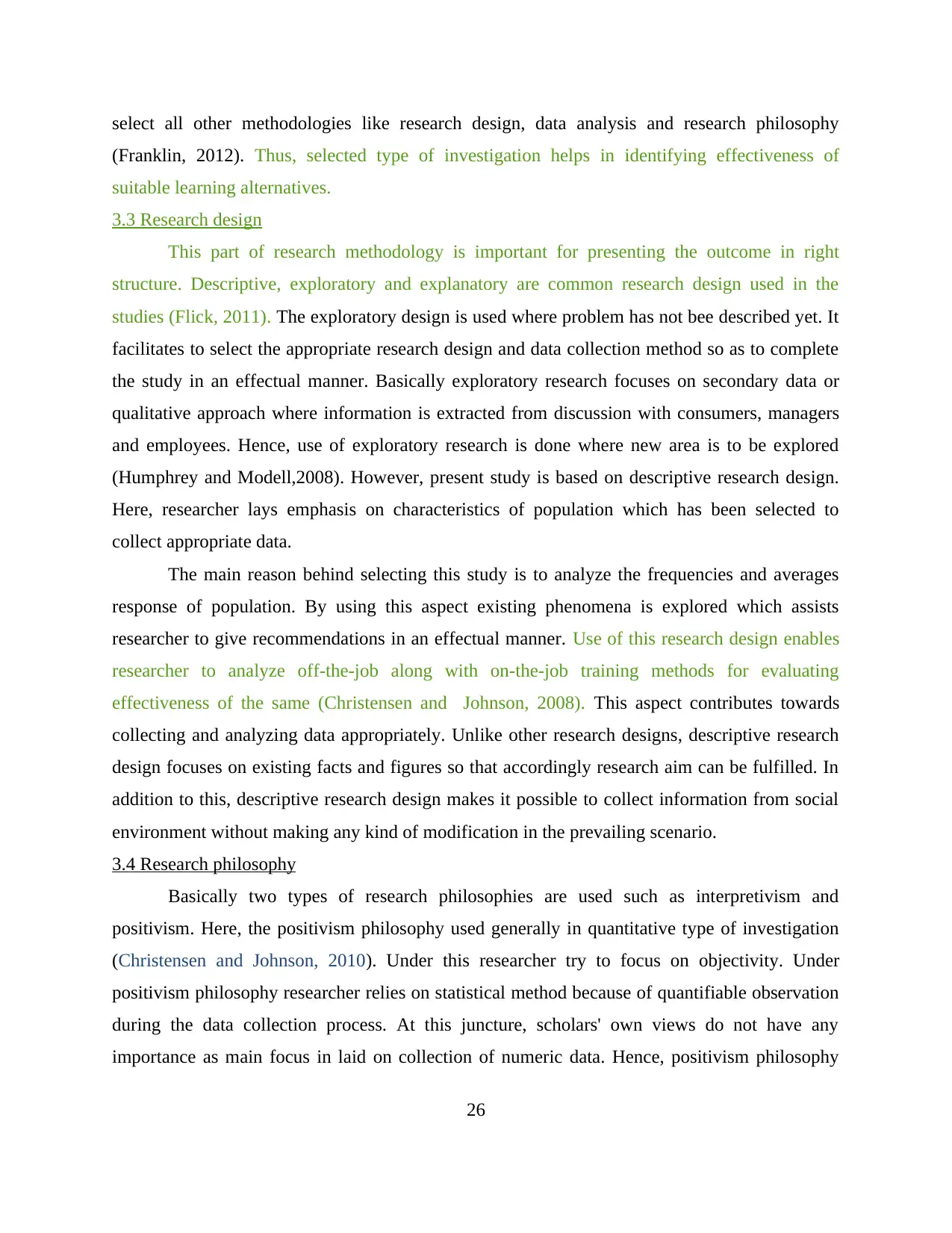
select all other methodologies like research design, data analysis and research philosophy
(Franklin, 2012). Thus, selected type of investigation helps in identifying effectiveness of
suitable learning alternatives.
3.3 Research design
This part of research methodology is important for presenting the outcome in right
structure. Descriptive, exploratory and explanatory are common research design used in the
studies (Flick, 2011). The exploratory design is used where problem has not bee described yet. It
facilitates to select the appropriate research design and data collection method so as to complete
the study in an effectual manner. Basically exploratory research focuses on secondary data or
qualitative approach where information is extracted from discussion with consumers, managers
and employees. Hence, use of exploratory research is done where new area is to be explored
(Humphrey and Modell,2008). However, present study is based on descriptive research design.
Here, researcher lays emphasis on characteristics of population which has been selected to
collect appropriate data.
The main reason behind selecting this study is to analyze the frequencies and averages
response of population. By using this aspect existing phenomena is explored which assists
researcher to give recommendations in an effectual manner. Use of this research design enables
researcher to analyze off-the-job along with on-the-job training methods for evaluating
effectiveness of the same (Christensen and Johnson, 2008). This aspect contributes towards
collecting and analyzing data appropriately. Unlike other research designs, descriptive research
design focuses on existing facts and figures so that accordingly research aim can be fulfilled. In
addition to this, descriptive research design makes it possible to collect information from social
environment without making any kind of modification in the prevailing scenario.
3.4 Research philosophy
Basically two types of research philosophies are used such as interpretivism and
positivism. Here, the positivism philosophy used generally in quantitative type of investigation
(Christensen and Johnson, 2010). Under this researcher try to focus on objectivity. Under
positivism philosophy researcher relies on statistical method because of quantifiable observation
during the data collection process. At this juncture, scholars' own views do not have any
importance as main focus in laid on collection of numeric data. Hence, positivism philosophy
26
(Franklin, 2012). Thus, selected type of investigation helps in identifying effectiveness of
suitable learning alternatives.
3.3 Research design
This part of research methodology is important for presenting the outcome in right
structure. Descriptive, exploratory and explanatory are common research design used in the
studies (Flick, 2011). The exploratory design is used where problem has not bee described yet. It
facilitates to select the appropriate research design and data collection method so as to complete
the study in an effectual manner. Basically exploratory research focuses on secondary data or
qualitative approach where information is extracted from discussion with consumers, managers
and employees. Hence, use of exploratory research is done where new area is to be explored
(Humphrey and Modell,2008). However, present study is based on descriptive research design.
Here, researcher lays emphasis on characteristics of population which has been selected to
collect appropriate data.
The main reason behind selecting this study is to analyze the frequencies and averages
response of population. By using this aspect existing phenomena is explored which assists
researcher to give recommendations in an effectual manner. Use of this research design enables
researcher to analyze off-the-job along with on-the-job training methods for evaluating
effectiveness of the same (Christensen and Johnson, 2008). This aspect contributes towards
collecting and analyzing data appropriately. Unlike other research designs, descriptive research
design focuses on existing facts and figures so that accordingly research aim can be fulfilled. In
addition to this, descriptive research design makes it possible to collect information from social
environment without making any kind of modification in the prevailing scenario.
3.4 Research philosophy
Basically two types of research philosophies are used such as interpretivism and
positivism. Here, the positivism philosophy used generally in quantitative type of investigation
(Christensen and Johnson, 2010). Under this researcher try to focus on objectivity. Under
positivism philosophy researcher relies on statistical method because of quantifiable observation
during the data collection process. At this juncture, scholars' own views do not have any
importance as main focus in laid on collection of numeric data. Hence, positivism philosophy
26
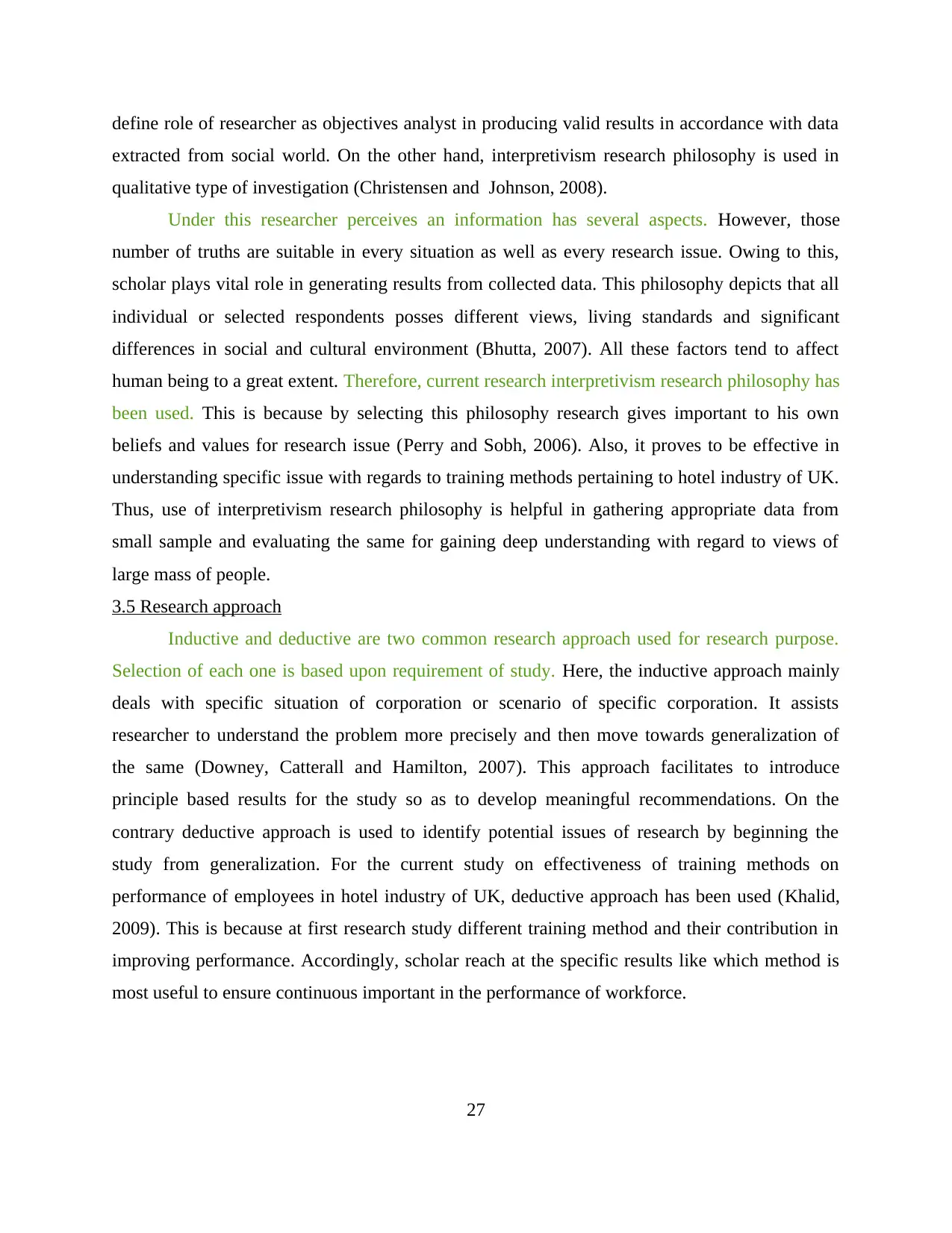
define role of researcher as objectives analyst in producing valid results in accordance with data
extracted from social world. On the other hand, interpretivism research philosophy is used in
qualitative type of investigation (Christensen and Johnson, 2008).
Under this researcher perceives an information has several aspects. However, those
number of truths are suitable in every situation as well as every research issue. Owing to this,
scholar plays vital role in generating results from collected data. This philosophy depicts that all
individual or selected respondents posses different views, living standards and significant
differences in social and cultural environment (Bhutta, 2007). All these factors tend to affect
human being to a great extent. Therefore, current research interpretivism research philosophy has
been used. This is because by selecting this philosophy research gives important to his own
beliefs and values for research issue (Perry and Sobh, 2006). Also, it proves to be effective in
understanding specific issue with regards to training methods pertaining to hotel industry of UK.
Thus, use of interpretivism research philosophy is helpful in gathering appropriate data from
small sample and evaluating the same for gaining deep understanding with regard to views of
large mass of people.
3.5 Research approach
Inductive and deductive are two common research approach used for research purpose.
Selection of each one is based upon requirement of study. Here, the inductive approach mainly
deals with specific situation of corporation or scenario of specific corporation. It assists
researcher to understand the problem more precisely and then move towards generalization of
the same (Downey, Catterall and Hamilton, 2007). This approach facilitates to introduce
principle based results for the study so as to develop meaningful recommendations. On the
contrary deductive approach is used to identify potential issues of research by beginning the
study from generalization. For the current study on effectiveness of training methods on
performance of employees in hotel industry of UK, deductive approach has been used (Khalid,
2009). This is because at first research study different training method and their contribution in
improving performance. Accordingly, scholar reach at the specific results like which method is
most useful to ensure continuous important in the performance of workforce.
27
extracted from social world. On the other hand, interpretivism research philosophy is used in
qualitative type of investigation (Christensen and Johnson, 2008).
Under this researcher perceives an information has several aspects. However, those
number of truths are suitable in every situation as well as every research issue. Owing to this,
scholar plays vital role in generating results from collected data. This philosophy depicts that all
individual or selected respondents posses different views, living standards and significant
differences in social and cultural environment (Bhutta, 2007). All these factors tend to affect
human being to a great extent. Therefore, current research interpretivism research philosophy has
been used. This is because by selecting this philosophy research gives important to his own
beliefs and values for research issue (Perry and Sobh, 2006). Also, it proves to be effective in
understanding specific issue with regards to training methods pertaining to hotel industry of UK.
Thus, use of interpretivism research philosophy is helpful in gathering appropriate data from
small sample and evaluating the same for gaining deep understanding with regard to views of
large mass of people.
3.5 Research approach
Inductive and deductive are two common research approach used for research purpose.
Selection of each one is based upon requirement of study. Here, the inductive approach mainly
deals with specific situation of corporation or scenario of specific corporation. It assists
researcher to understand the problem more precisely and then move towards generalization of
the same (Downey, Catterall and Hamilton, 2007). This approach facilitates to introduce
principle based results for the study so as to develop meaningful recommendations. On the
contrary deductive approach is used to identify potential issues of research by beginning the
study from generalization. For the current study on effectiveness of training methods on
performance of employees in hotel industry of UK, deductive approach has been used (Khalid,
2009). This is because at first research study different training method and their contribution in
improving performance. Accordingly, scholar reach at the specific results like which method is
most useful to ensure continuous important in the performance of workforce.
27
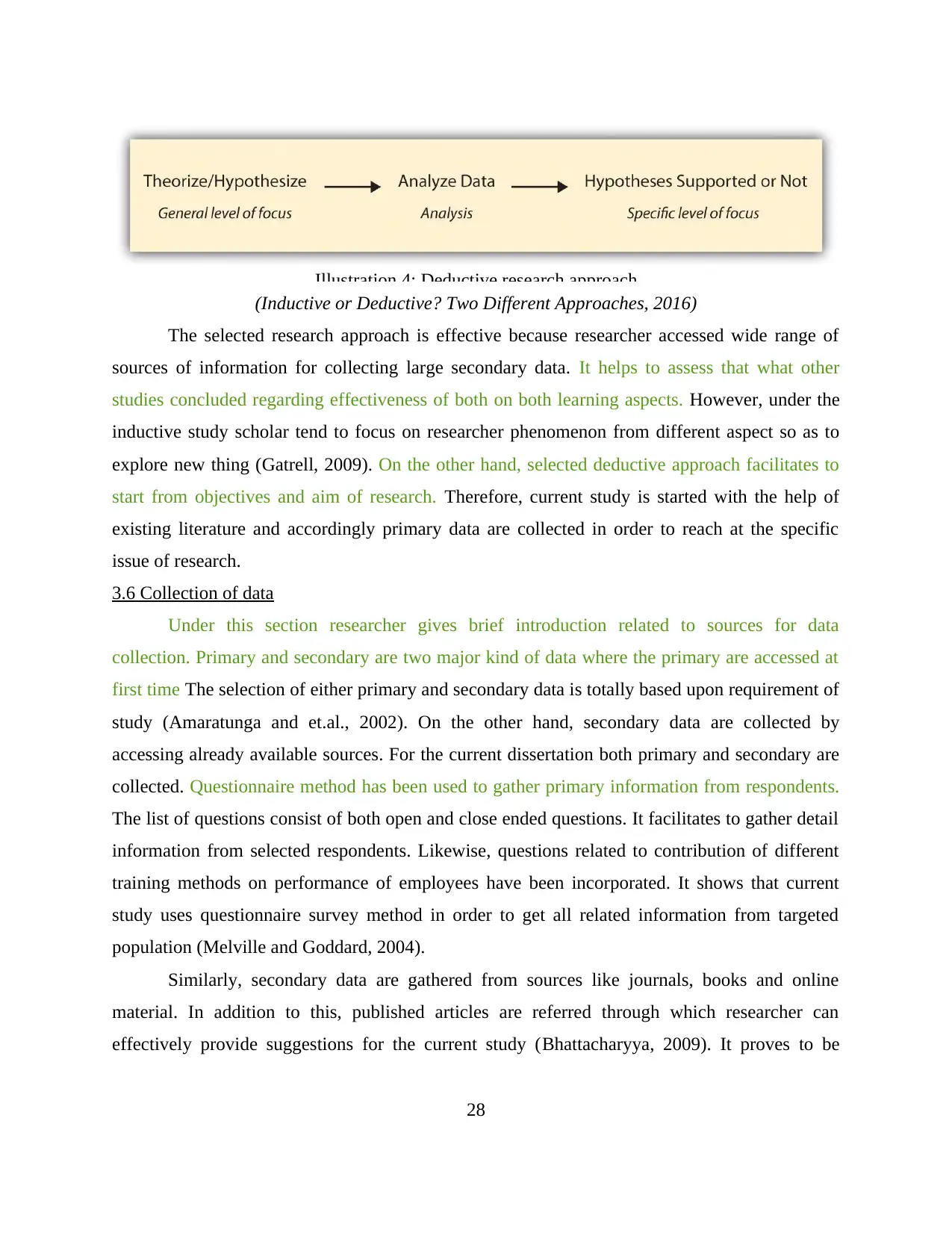
(Inductive or Deductive? Two Different Approaches, 2016)
The selected research approach is effective because researcher accessed wide range of
sources of information for collecting large secondary data. It helps to assess that what other
studies concluded regarding effectiveness of both on both learning aspects. However, under the
inductive study scholar tend to focus on researcher phenomenon from different aspect so as to
explore new thing (Gatrell, 2009). On the other hand, selected deductive approach facilitates to
start from objectives and aim of research. Therefore, current study is started with the help of
existing literature and accordingly primary data are collected in order to reach at the specific
issue of research.
3.6 Collection of data
Under this section researcher gives brief introduction related to sources for data
collection. Primary and secondary are two major kind of data where the primary are accessed at
first time The selection of either primary and secondary data is totally based upon requirement of
study (Amaratunga and et.al., 2002). On the other hand, secondary data are collected by
accessing already available sources. For the current dissertation both primary and secondary are
collected. Questionnaire method has been used to gather primary information from respondents.
The list of questions consist of both open and close ended questions. It facilitates to gather detail
information from selected respondents. Likewise, questions related to contribution of different
training methods on performance of employees have been incorporated. It shows that current
study uses questionnaire survey method in order to get all related information from targeted
population (Melville and Goddard, 2004).
Similarly, secondary data are gathered from sources like journals, books and online
material. In addition to this, published articles are referred through which researcher can
effectively provide suggestions for the current study (Bhattacharyya, 2009). It proves to be
28
Illustration 4: Deductive research approach
The selected research approach is effective because researcher accessed wide range of
sources of information for collecting large secondary data. It helps to assess that what other
studies concluded regarding effectiveness of both on both learning aspects. However, under the
inductive study scholar tend to focus on researcher phenomenon from different aspect so as to
explore new thing (Gatrell, 2009). On the other hand, selected deductive approach facilitates to
start from objectives and aim of research. Therefore, current study is started with the help of
existing literature and accordingly primary data are collected in order to reach at the specific
issue of research.
3.6 Collection of data
Under this section researcher gives brief introduction related to sources for data
collection. Primary and secondary are two major kind of data where the primary are accessed at
first time The selection of either primary and secondary data is totally based upon requirement of
study (Amaratunga and et.al., 2002). On the other hand, secondary data are collected by
accessing already available sources. For the current dissertation both primary and secondary are
collected. Questionnaire method has been used to gather primary information from respondents.
The list of questions consist of both open and close ended questions. It facilitates to gather detail
information from selected respondents. Likewise, questions related to contribution of different
training methods on performance of employees have been incorporated. It shows that current
study uses questionnaire survey method in order to get all related information from targeted
population (Melville and Goddard, 2004).
Similarly, secondary data are gathered from sources like journals, books and online
material. In addition to this, published articles are referred through which researcher can
effectively provide suggestions for the current study (Bhattacharyya, 2009). It proves to be
28
Illustration 4: Deductive research approach
Paraphrase This Document
Need a fresh take? Get an instant paraphrase of this document with our AI Paraphraser
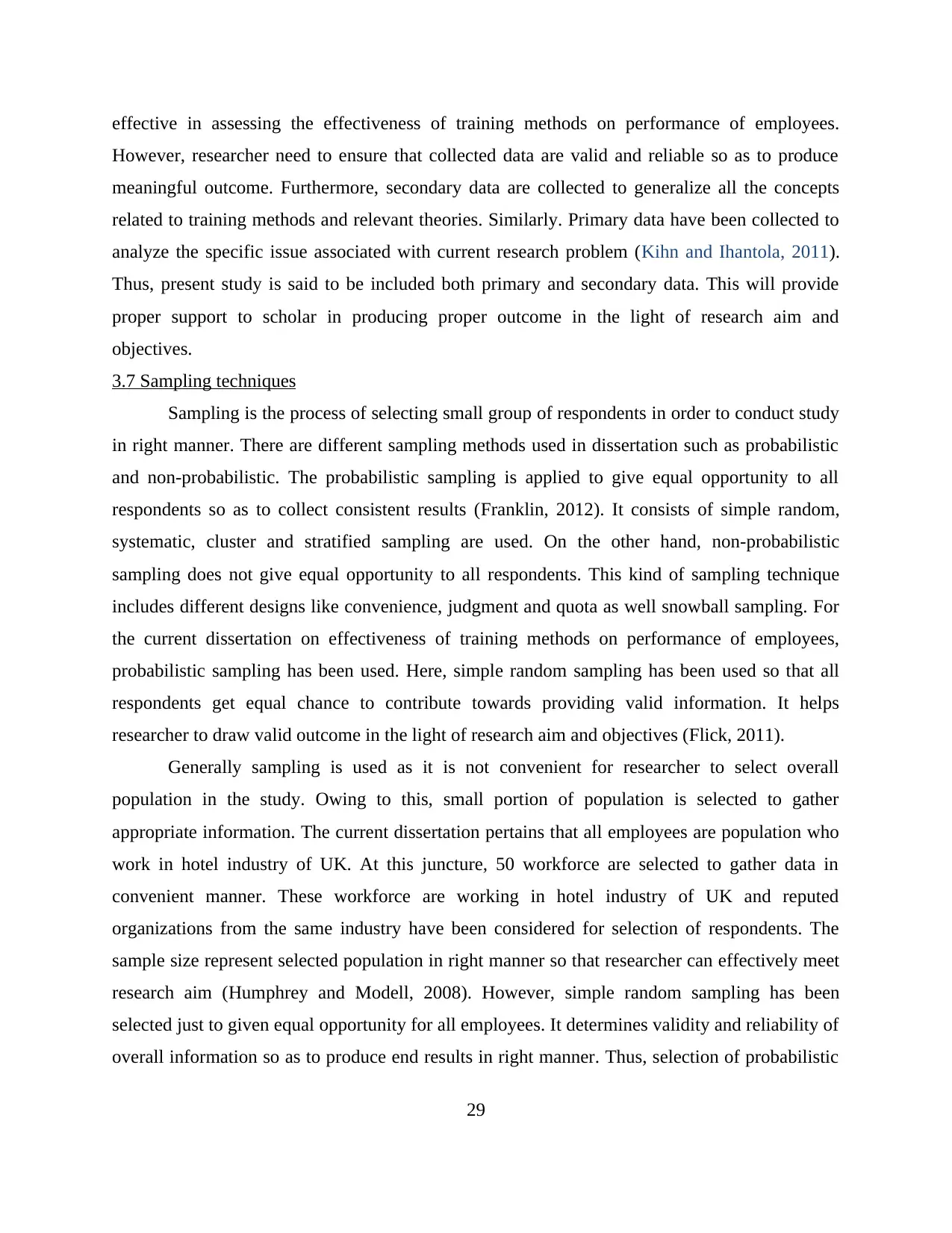
effective in assessing the effectiveness of training methods on performance of employees.
However, researcher need to ensure that collected data are valid and reliable so as to produce
meaningful outcome. Furthermore, secondary data are collected to generalize all the concepts
related to training methods and relevant theories. Similarly. Primary data have been collected to
analyze the specific issue associated with current research problem (Kihn and Ihantola, 2011).
Thus, present study is said to be included both primary and secondary data. This will provide
proper support to scholar in producing proper outcome in the light of research aim and
objectives.
3.7 Sampling techniques
Sampling is the process of selecting small group of respondents in order to conduct study
in right manner. There are different sampling methods used in dissertation such as probabilistic
and non-probabilistic. The probabilistic sampling is applied to give equal opportunity to all
respondents so as to collect consistent results (Franklin, 2012). It consists of simple random,
systematic, cluster and stratified sampling are used. On the other hand, non-probabilistic
sampling does not give equal opportunity to all respondents. This kind of sampling technique
includes different designs like convenience, judgment and quota as well snowball sampling. For
the current dissertation on effectiveness of training methods on performance of employees,
probabilistic sampling has been used. Here, simple random sampling has been used so that all
respondents get equal chance to contribute towards providing valid information. It helps
researcher to draw valid outcome in the light of research aim and objectives (Flick, 2011).
Generally sampling is used as it is not convenient for researcher to select overall
population in the study. Owing to this, small portion of population is selected to gather
appropriate information. The current dissertation pertains that all employees are population who
work in hotel industry of UK. At this juncture, 50 workforce are selected to gather data in
convenient manner. These workforce are working in hotel industry of UK and reputed
organizations from the same industry have been considered for selection of respondents. The
sample size represent selected population in right manner so that researcher can effectively meet
research aim (Humphrey and Modell, 2008). However, simple random sampling has been
selected just to given equal opportunity for all employees. It determines validity and reliability of
overall information so as to produce end results in right manner. Thus, selection of probabilistic
29
However, researcher need to ensure that collected data are valid and reliable so as to produce
meaningful outcome. Furthermore, secondary data are collected to generalize all the concepts
related to training methods and relevant theories. Similarly. Primary data have been collected to
analyze the specific issue associated with current research problem (Kihn and Ihantola, 2011).
Thus, present study is said to be included both primary and secondary data. This will provide
proper support to scholar in producing proper outcome in the light of research aim and
objectives.
3.7 Sampling techniques
Sampling is the process of selecting small group of respondents in order to conduct study
in right manner. There are different sampling methods used in dissertation such as probabilistic
and non-probabilistic. The probabilistic sampling is applied to give equal opportunity to all
respondents so as to collect consistent results (Franklin, 2012). It consists of simple random,
systematic, cluster and stratified sampling are used. On the other hand, non-probabilistic
sampling does not give equal opportunity to all respondents. This kind of sampling technique
includes different designs like convenience, judgment and quota as well snowball sampling. For
the current dissertation on effectiveness of training methods on performance of employees,
probabilistic sampling has been used. Here, simple random sampling has been used so that all
respondents get equal chance to contribute towards providing valid information. It helps
researcher to draw valid outcome in the light of research aim and objectives (Flick, 2011).
Generally sampling is used as it is not convenient for researcher to select overall
population in the study. Owing to this, small portion of population is selected to gather
appropriate information. The current dissertation pertains that all employees are population who
work in hotel industry of UK. At this juncture, 50 workforce are selected to gather data in
convenient manner. These workforce are working in hotel industry of UK and reputed
organizations from the same industry have been considered for selection of respondents. The
sample size represent selected population in right manner so that researcher can effectively meet
research aim (Humphrey and Modell, 2008). However, simple random sampling has been
selected just to given equal opportunity for all employees. It determines validity and reliability of
overall information so as to produce end results in right manner. Thus, selection of probabilistic
29
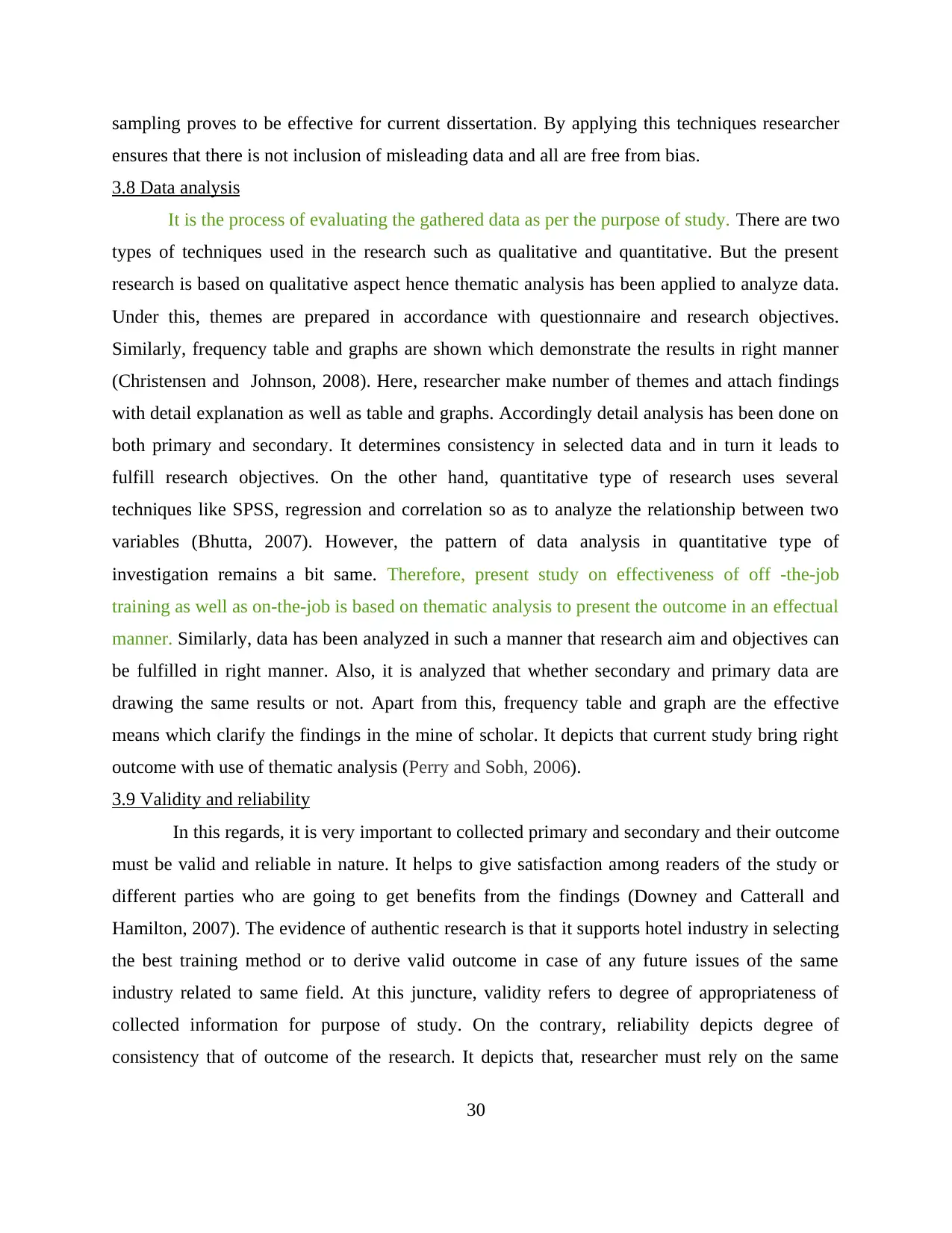
sampling proves to be effective for current dissertation. By applying this techniques researcher
ensures that there is not inclusion of misleading data and all are free from bias.
3.8 Data analysis
It is the process of evaluating the gathered data as per the purpose of study. There are two
types of techniques used in the research such as qualitative and quantitative. But the present
research is based on qualitative aspect hence thematic analysis has been applied to analyze data.
Under this, themes are prepared in accordance with questionnaire and research objectives.
Similarly, frequency table and graphs are shown which demonstrate the results in right manner
(Christensen and Johnson, 2008). Here, researcher make number of themes and attach findings
with detail explanation as well as table and graphs. Accordingly detail analysis has been done on
both primary and secondary. It determines consistency in selected data and in turn it leads to
fulfill research objectives. On the other hand, quantitative type of research uses several
techniques like SPSS, regression and correlation so as to analyze the relationship between two
variables (Bhutta, 2007). However, the pattern of data analysis in quantitative type of
investigation remains a bit same. Therefore, present study on effectiveness of off -the-job
training as well as on-the-job is based on thematic analysis to present the outcome in an effectual
manner. Similarly, data has been analyzed in such a manner that research aim and objectives can
be fulfilled in right manner. Also, it is analyzed that whether secondary and primary data are
drawing the same results or not. Apart from this, frequency table and graph are the effective
means which clarify the findings in the mine of scholar. It depicts that current study bring right
outcome with use of thematic analysis (Perry and Sobh, 2006).
3.9 Validity and reliability
In this regards, it is very important to collected primary and secondary and their outcome
must be valid and reliable in nature. It helps to give satisfaction among readers of the study or
different parties who are going to get benefits from the findings (Downey and Catterall and
Hamilton, 2007). The evidence of authentic research is that it supports hotel industry in selecting
the best training method or to derive valid outcome in case of any future issues of the same
industry related to same field. At this juncture, validity refers to degree of appropriateness of
collected information for purpose of study. On the contrary, reliability depicts degree of
consistency that of outcome of the research. It depicts that, researcher must rely on the same
30
ensures that there is not inclusion of misleading data and all are free from bias.
3.8 Data analysis
It is the process of evaluating the gathered data as per the purpose of study. There are two
types of techniques used in the research such as qualitative and quantitative. But the present
research is based on qualitative aspect hence thematic analysis has been applied to analyze data.
Under this, themes are prepared in accordance with questionnaire and research objectives.
Similarly, frequency table and graphs are shown which demonstrate the results in right manner
(Christensen and Johnson, 2008). Here, researcher make number of themes and attach findings
with detail explanation as well as table and graphs. Accordingly detail analysis has been done on
both primary and secondary. It determines consistency in selected data and in turn it leads to
fulfill research objectives. On the other hand, quantitative type of research uses several
techniques like SPSS, regression and correlation so as to analyze the relationship between two
variables (Bhutta, 2007). However, the pattern of data analysis in quantitative type of
investigation remains a bit same. Therefore, present study on effectiveness of off -the-job
training as well as on-the-job is based on thematic analysis to present the outcome in an effectual
manner. Similarly, data has been analyzed in such a manner that research aim and objectives can
be fulfilled in right manner. Also, it is analyzed that whether secondary and primary data are
drawing the same results or not. Apart from this, frequency table and graph are the effective
means which clarify the findings in the mine of scholar. It depicts that current study bring right
outcome with use of thematic analysis (Perry and Sobh, 2006).
3.9 Validity and reliability
In this regards, it is very important to collected primary and secondary and their outcome
must be valid and reliable in nature. It helps to give satisfaction among readers of the study or
different parties who are going to get benefits from the findings (Downey and Catterall and
Hamilton, 2007). The evidence of authentic research is that it supports hotel industry in selecting
the best training method or to derive valid outcome in case of any future issues of the same
industry related to same field. At this juncture, validity refers to degree of appropriateness of
collected information for purpose of study. On the contrary, reliability depicts degree of
consistency that of outcome of the research. It depicts that, researcher must rely on the same
30
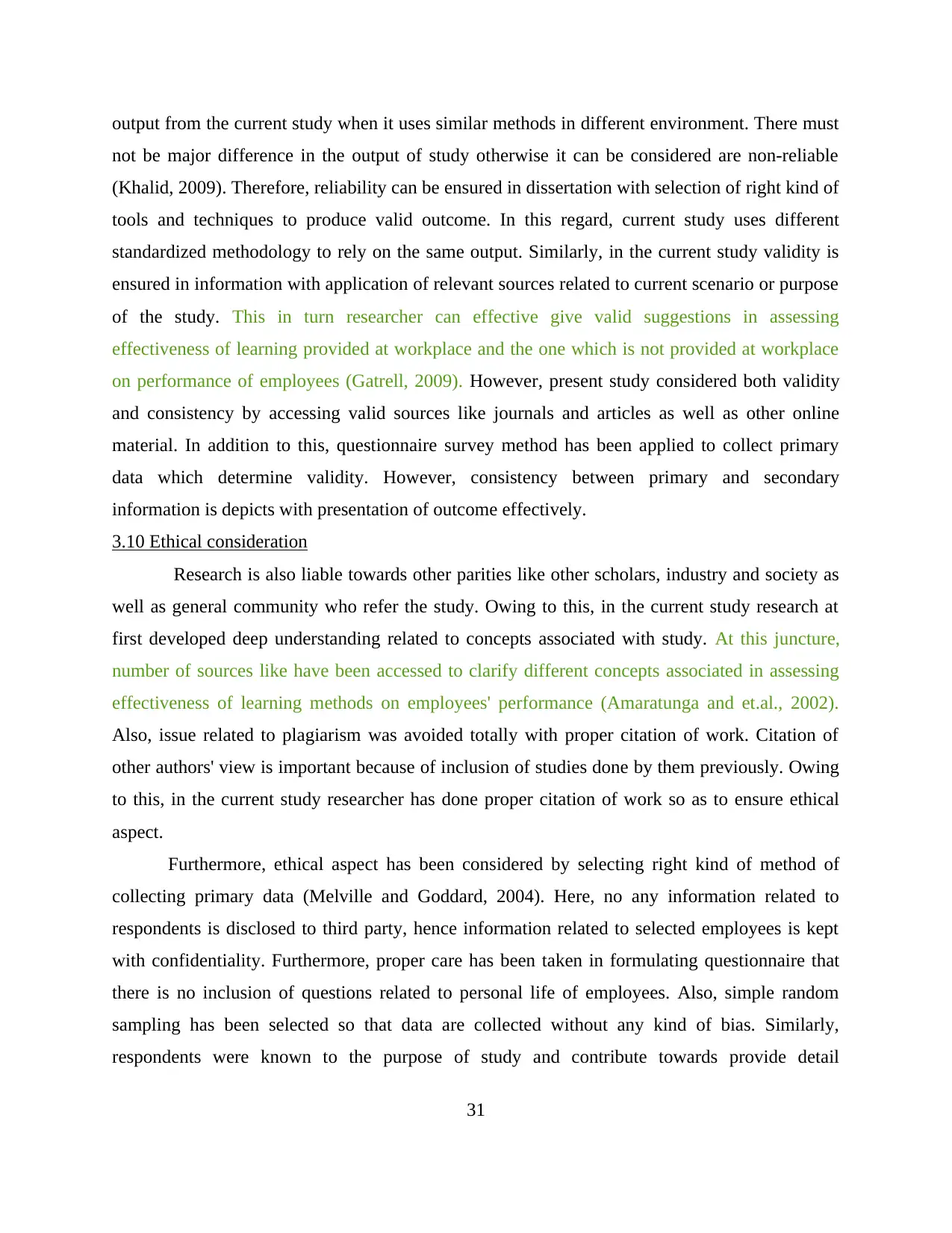
output from the current study when it uses similar methods in different environment. There must
not be major difference in the output of study otherwise it can be considered are non-reliable
(Khalid, 2009). Therefore, reliability can be ensured in dissertation with selection of right kind of
tools and techniques to produce valid outcome. In this regard, current study uses different
standardized methodology to rely on the same output. Similarly, in the current study validity is
ensured in information with application of relevant sources related to current scenario or purpose
of the study. This in turn researcher can effective give valid suggestions in assessing
effectiveness of learning provided at workplace and the one which is not provided at workplace
on performance of employees (Gatrell, 2009). However, present study considered both validity
and consistency by accessing valid sources like journals and articles as well as other online
material. In addition to this, questionnaire survey method has been applied to collect primary
data which determine validity. However, consistency between primary and secondary
information is depicts with presentation of outcome effectively.
3.10 Ethical consideration
Research is also liable towards other parities like other scholars, industry and society as
well as general community who refer the study. Owing to this, in the current study research at
first developed deep understanding related to concepts associated with study. At this juncture,
number of sources like have been accessed to clarify different concepts associated in assessing
effectiveness of learning methods on employees' performance (Amaratunga and et.al., 2002).
Also, issue related to plagiarism was avoided totally with proper citation of work. Citation of
other authors' view is important because of inclusion of studies done by them previously. Owing
to this, in the current study researcher has done proper citation of work so as to ensure ethical
aspect.
Furthermore, ethical aspect has been considered by selecting right kind of method of
collecting primary data (Melville and Goddard, 2004). Here, no any information related to
respondents is disclosed to third party, hence information related to selected employees is kept
with confidentiality. Furthermore, proper care has been taken in formulating questionnaire that
there is no inclusion of questions related to personal life of employees. Also, simple random
sampling has been selected so that data are collected without any kind of bias. Similarly,
respondents were known to the purpose of study and contribute towards provide detail
31
not be major difference in the output of study otherwise it can be considered are non-reliable
(Khalid, 2009). Therefore, reliability can be ensured in dissertation with selection of right kind of
tools and techniques to produce valid outcome. In this regard, current study uses different
standardized methodology to rely on the same output. Similarly, in the current study validity is
ensured in information with application of relevant sources related to current scenario or purpose
of the study. This in turn researcher can effective give valid suggestions in assessing
effectiveness of learning provided at workplace and the one which is not provided at workplace
on performance of employees (Gatrell, 2009). However, present study considered both validity
and consistency by accessing valid sources like journals and articles as well as other online
material. In addition to this, questionnaire survey method has been applied to collect primary
data which determine validity. However, consistency between primary and secondary
information is depicts with presentation of outcome effectively.
3.10 Ethical consideration
Research is also liable towards other parities like other scholars, industry and society as
well as general community who refer the study. Owing to this, in the current study research at
first developed deep understanding related to concepts associated with study. At this juncture,
number of sources like have been accessed to clarify different concepts associated in assessing
effectiveness of learning methods on employees' performance (Amaratunga and et.al., 2002).
Also, issue related to plagiarism was avoided totally with proper citation of work. Citation of
other authors' view is important because of inclusion of studies done by them previously. Owing
to this, in the current study researcher has done proper citation of work so as to ensure ethical
aspect.
Furthermore, ethical aspect has been considered by selecting right kind of method of
collecting primary data (Melville and Goddard, 2004). Here, no any information related to
respondents is disclosed to third party, hence information related to selected employees is kept
with confidentiality. Furthermore, proper care has been taken in formulating questionnaire that
there is no inclusion of questions related to personal life of employees. Also, simple random
sampling has been selected so that data are collected without any kind of bias. Similarly,
respondents were known to the purpose of study and contribute towards provide detail
31
Secure Best Marks with AI Grader
Need help grading? Try our AI Grader for instant feedback on your assignments.

information so as to completing the study on right manner (Bhattacharyya, 2009). Moreover,
selected respondents were not forced to provide information related to training and they were
communicate proper regarding the study.
Apart from this, biasness is totally avoided for producing valid outcome which prove to
be effective for different parties who are associated with study (Bhutta, 2007). In addition to this,
appropriate sources are selected for collecting data and previous done studies are also referred in
order generate valid outcome. Thus, researcher focused on ethical consideration properly which
leads to complete the study without any kind of ethical issues. Apart from this, scholar has
ensured that commencement of study and its purpose does not harm any body in any context.
3.11 Limitations
Every research has some limitations and it is very important for researcher to focus on the
same. No any study is completed without some of limitations but possible try is made to
complete study in right manner.
Generally, lack of sufficient information is the main issues in the study. However, the
current study does not have literature gap hence there is huge amount of information is
already provided (Flick, 2011).
The limitation actually faced in present study is related to time. But, this issues is
resolved by using proper planning for completion of study on right time. It proves to be
effective in completing all chapter of study on right time and drawing valid outcome of
the same in accordance with aim and objectives (Khalid, 2009).
Furthermore, issues is faced in approaching respondents because of time constraints.
Although, researcher uses questionnaire survey for respondents so as to consume less
time in getting responses.
The research limitation was faced due to restricted sources of information. It created
issues in accessing good sources of information. However, prior permission has been
taken for some of the sources so as to gather appropriate data (Amaratunga and et.al.,
2002).
32
selected respondents were not forced to provide information related to training and they were
communicate proper regarding the study.
Apart from this, biasness is totally avoided for producing valid outcome which prove to
be effective for different parties who are associated with study (Bhutta, 2007). In addition to this,
appropriate sources are selected for collecting data and previous done studies are also referred in
order generate valid outcome. Thus, researcher focused on ethical consideration properly which
leads to complete the study without any kind of ethical issues. Apart from this, scholar has
ensured that commencement of study and its purpose does not harm any body in any context.
3.11 Limitations
Every research has some limitations and it is very important for researcher to focus on the
same. No any study is completed without some of limitations but possible try is made to
complete study in right manner.
Generally, lack of sufficient information is the main issues in the study. However, the
current study does not have literature gap hence there is huge amount of information is
already provided (Flick, 2011).
The limitation actually faced in present study is related to time. But, this issues is
resolved by using proper planning for completion of study on right time. It proves to be
effective in completing all chapter of study on right time and drawing valid outcome of
the same in accordance with aim and objectives (Khalid, 2009).
Furthermore, issues is faced in approaching respondents because of time constraints.
Although, researcher uses questionnaire survey for respondents so as to consume less
time in getting responses.
The research limitation was faced due to restricted sources of information. It created
issues in accessing good sources of information. However, prior permission has been
taken for some of the sources so as to gather appropriate data (Amaratunga and et.al.,
2002).
32
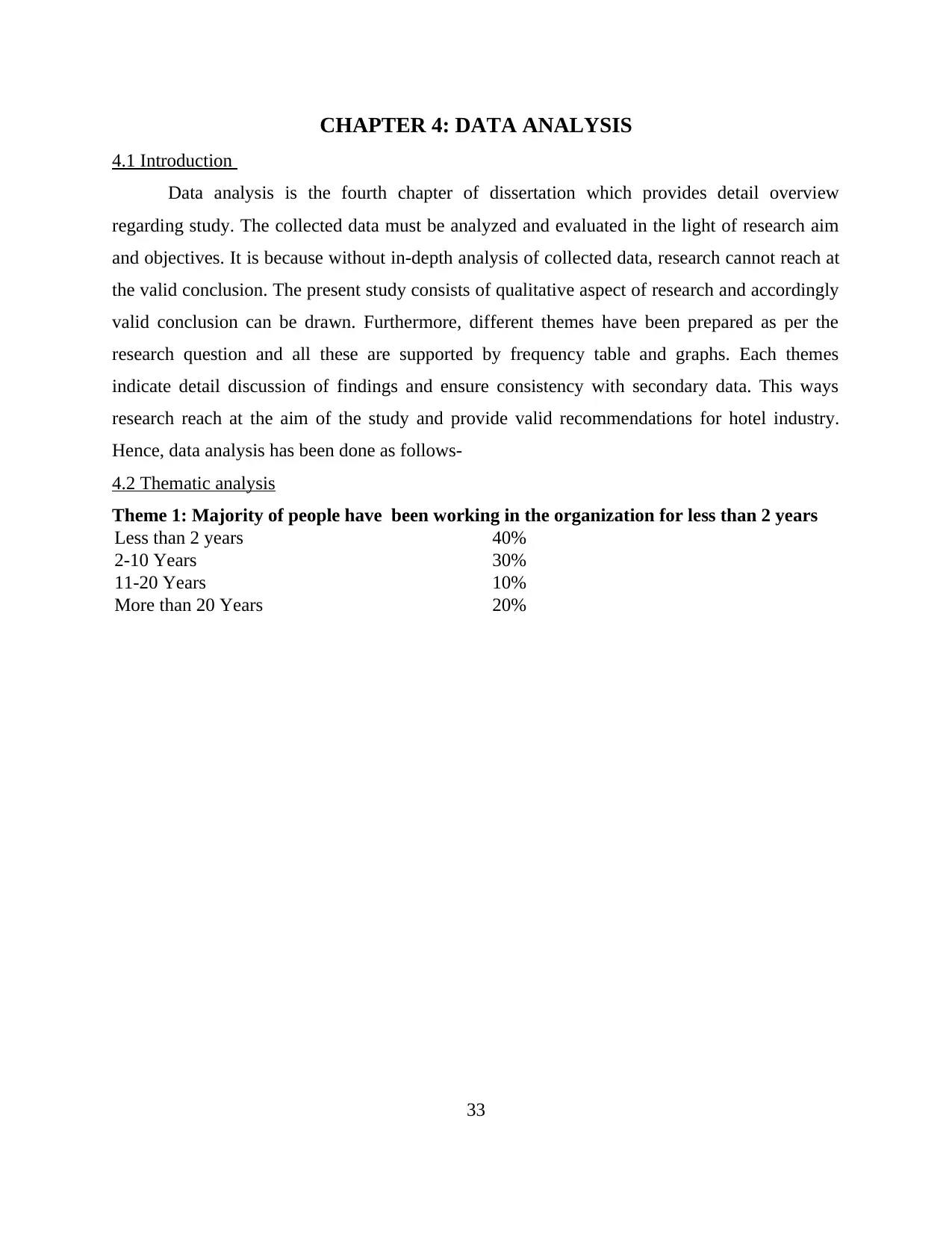
CHAPTER 4: DATA ANALYSIS
4.1 Introduction
Data analysis is the fourth chapter of dissertation which provides detail overview
regarding study. The collected data must be analyzed and evaluated in the light of research aim
and objectives. It is because without in-depth analysis of collected data, research cannot reach at
the valid conclusion. The present study consists of qualitative aspect of research and accordingly
valid conclusion can be drawn. Furthermore, different themes have been prepared as per the
research question and all these are supported by frequency table and graphs. Each themes
indicate detail discussion of findings and ensure consistency with secondary data. This ways
research reach at the aim of the study and provide valid recommendations for hotel industry.
Hence, data analysis has been done as follows-
4.2 Thematic analysis
Theme 1: Majority of people have been working in the organization for less than 2 years
Less than 2 years 40%
2-10 Years 30%
11-20 Years 10%
More than 20 Years 20%
33
4.1 Introduction
Data analysis is the fourth chapter of dissertation which provides detail overview
regarding study. The collected data must be analyzed and evaluated in the light of research aim
and objectives. It is because without in-depth analysis of collected data, research cannot reach at
the valid conclusion. The present study consists of qualitative aspect of research and accordingly
valid conclusion can be drawn. Furthermore, different themes have been prepared as per the
research question and all these are supported by frequency table and graphs. Each themes
indicate detail discussion of findings and ensure consistency with secondary data. This ways
research reach at the aim of the study and provide valid recommendations for hotel industry.
Hence, data analysis has been done as follows-
4.2 Thematic analysis
Theme 1: Majority of people have been working in the organization for less than 2 years
Less than 2 years 40%
2-10 Years 30%
11-20 Years 10%
More than 20 Years 20%
33
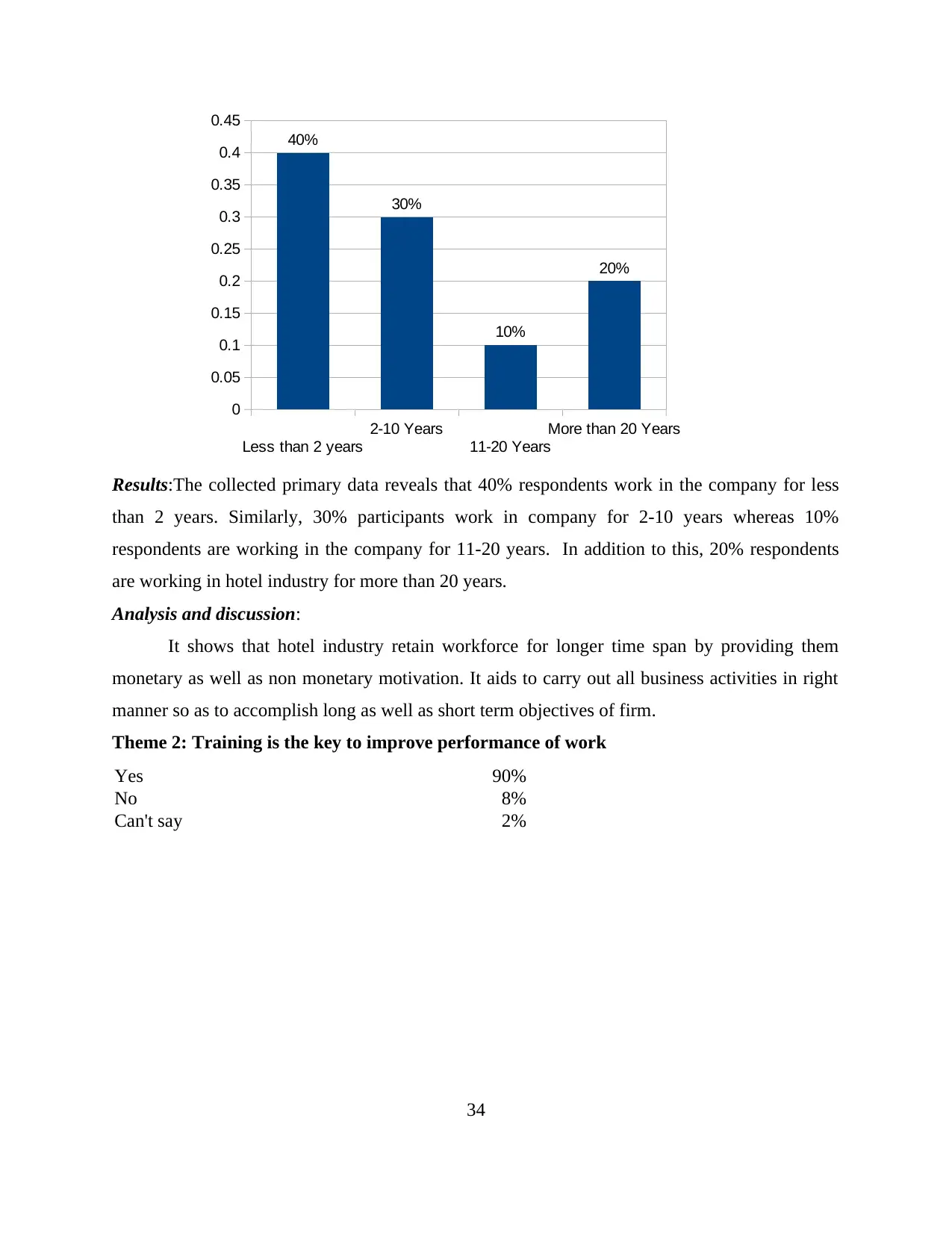
Results:The collected primary data reveals that 40% respondents work in the company for less
than 2 years. Similarly, 30% participants work in company for 2-10 years whereas 10%
respondents are working in the company for 11-20 years. In addition to this, 20% respondents
are working in hotel industry for more than 20 years.
Analysis and discussion:
It shows that hotel industry retain workforce for longer time span by providing them
monetary as well as non monetary motivation. It aids to carry out all business activities in right
manner so as to accomplish long as well as short term objectives of firm.
Theme 2: Training is the key to improve performance of work
Yes 90%
No 8%
Can't say 2%
34
Less than 2 years
2-10 Years
11-20 Years
More than 20 Years
0
0.05
0.1
0.15
0.2
0.25
0.3
0.35
0.4
0.45
40%
30%
10%
20%
than 2 years. Similarly, 30% participants work in company for 2-10 years whereas 10%
respondents are working in the company for 11-20 years. In addition to this, 20% respondents
are working in hotel industry for more than 20 years.
Analysis and discussion:
It shows that hotel industry retain workforce for longer time span by providing them
monetary as well as non monetary motivation. It aids to carry out all business activities in right
manner so as to accomplish long as well as short term objectives of firm.
Theme 2: Training is the key to improve performance of work
Yes 90%
No 8%
Can't say 2%
34
Less than 2 years
2-10 Years
11-20 Years
More than 20 Years
0
0.05
0.1
0.15
0.2
0.25
0.3
0.35
0.4
0.45
40%
30%
10%
20%
Paraphrase This Document
Need a fresh take? Get an instant paraphrase of this document with our AI Paraphraser

Results:The collected primary data depicts that 90% participants or employees consider that
training is the key to improve the performance at work. On the other hand, 8% respondents said
that training does not aid to improve performance of work. In addition to this, remaining 2%
employees do not have any idea regarding training and development activities. The results are
aligned with second research objectives because majority of respondents stated that training is
the key improve performance at work
Analysis and discussion: It depicts that an organization must ensure inclusion of different kind
of training at workplace so as to enhance skills and knowledge of workforce. It leads to deliver
good quality of services to large number of buyers. It facilitates to carry out all business
activities in an effectual manner. Furthermore, secondary data also shows the same results that
training tend to generate positive attitude among employees. This aspect enables employees to
focus on their job and increase overall rate of return of corporation in the marketplace.
Theme 3: Management's suggestions is imperative measure used by organization to select
employees for training
On request of employees 20%
Performance appraisal 30%
Management's suggestions 30%
All of the above 20%
35
90%
8%
2%
training is the key to improve the performance at work. On the other hand, 8% respondents said
that training does not aid to improve performance of work. In addition to this, remaining 2%
employees do not have any idea regarding training and development activities. The results are
aligned with second research objectives because majority of respondents stated that training is
the key improve performance at work
Analysis and discussion: It depicts that an organization must ensure inclusion of different kind
of training at workplace so as to enhance skills and knowledge of workforce. It leads to deliver
good quality of services to large number of buyers. It facilitates to carry out all business
activities in an effectual manner. Furthermore, secondary data also shows the same results that
training tend to generate positive attitude among employees. This aspect enables employees to
focus on their job and increase overall rate of return of corporation in the marketplace.
Theme 3: Management's suggestions is imperative measure used by organization to select
employees for training
On request of employees 20%
Performance appraisal 30%
Management's suggestions 30%
All of the above 20%
35
90%
8%
2%
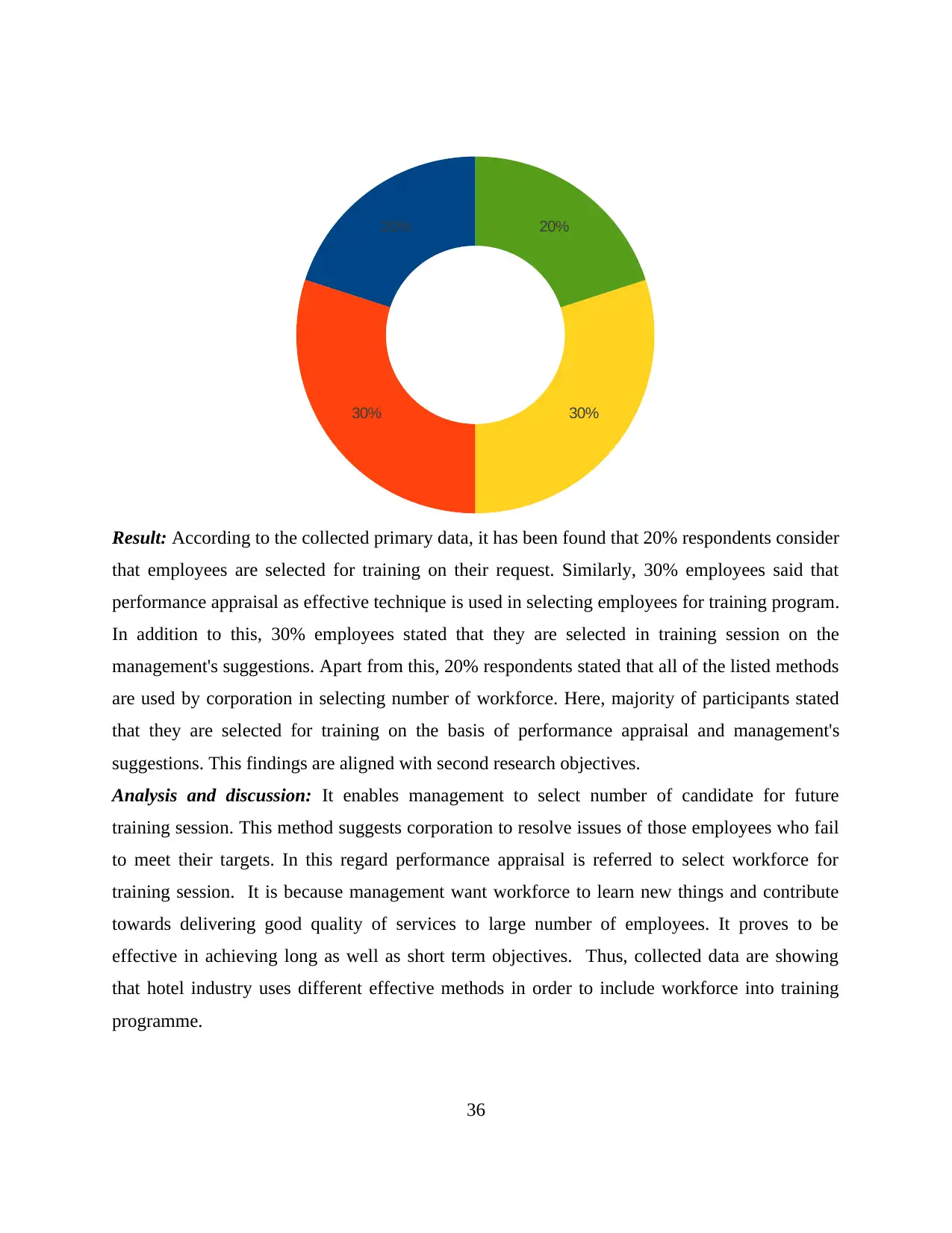
Result: According to the collected primary data, it has been found that 20% respondents consider
that employees are selected for training on their request. Similarly, 30% employees said that
performance appraisal as effective technique is used in selecting employees for training program.
In addition to this, 30% employees stated that they are selected in training session on the
management's suggestions. Apart from this, 20% respondents stated that all of the listed methods
are used by corporation in selecting number of workforce. Here, majority of participants stated
that they are selected for training on the basis of performance appraisal and management's
suggestions. This findings are aligned with second research objectives.
Analysis and discussion: It enables management to select number of candidate for future
training session. This method suggests corporation to resolve issues of those employees who fail
to meet their targets. In this regard performance appraisal is referred to select workforce for
training session. It is because management want workforce to learn new things and contribute
towards delivering good quality of services to large number of employees. It proves to be
effective in achieving long as well as short term objectives. Thus, collected data are showing
that hotel industry uses different effective methods in order to include workforce into training
programme.
36
20%
30% 30%
20%
that employees are selected for training on their request. Similarly, 30% employees said that
performance appraisal as effective technique is used in selecting employees for training program.
In addition to this, 30% employees stated that they are selected in training session on the
management's suggestions. Apart from this, 20% respondents stated that all of the listed methods
are used by corporation in selecting number of workforce. Here, majority of participants stated
that they are selected for training on the basis of performance appraisal and management's
suggestions. This findings are aligned with second research objectives.
Analysis and discussion: It enables management to select number of candidate for future
training session. This method suggests corporation to resolve issues of those employees who fail
to meet their targets. In this regard performance appraisal is referred to select workforce for
training session. It is because management want workforce to learn new things and contribute
towards delivering good quality of services to large number of employees. It proves to be
effective in achieving long as well as short term objectives. Thus, collected data are showing
that hotel industry uses different effective methods in order to include workforce into training
programme.
36
20%
30% 30%
20%
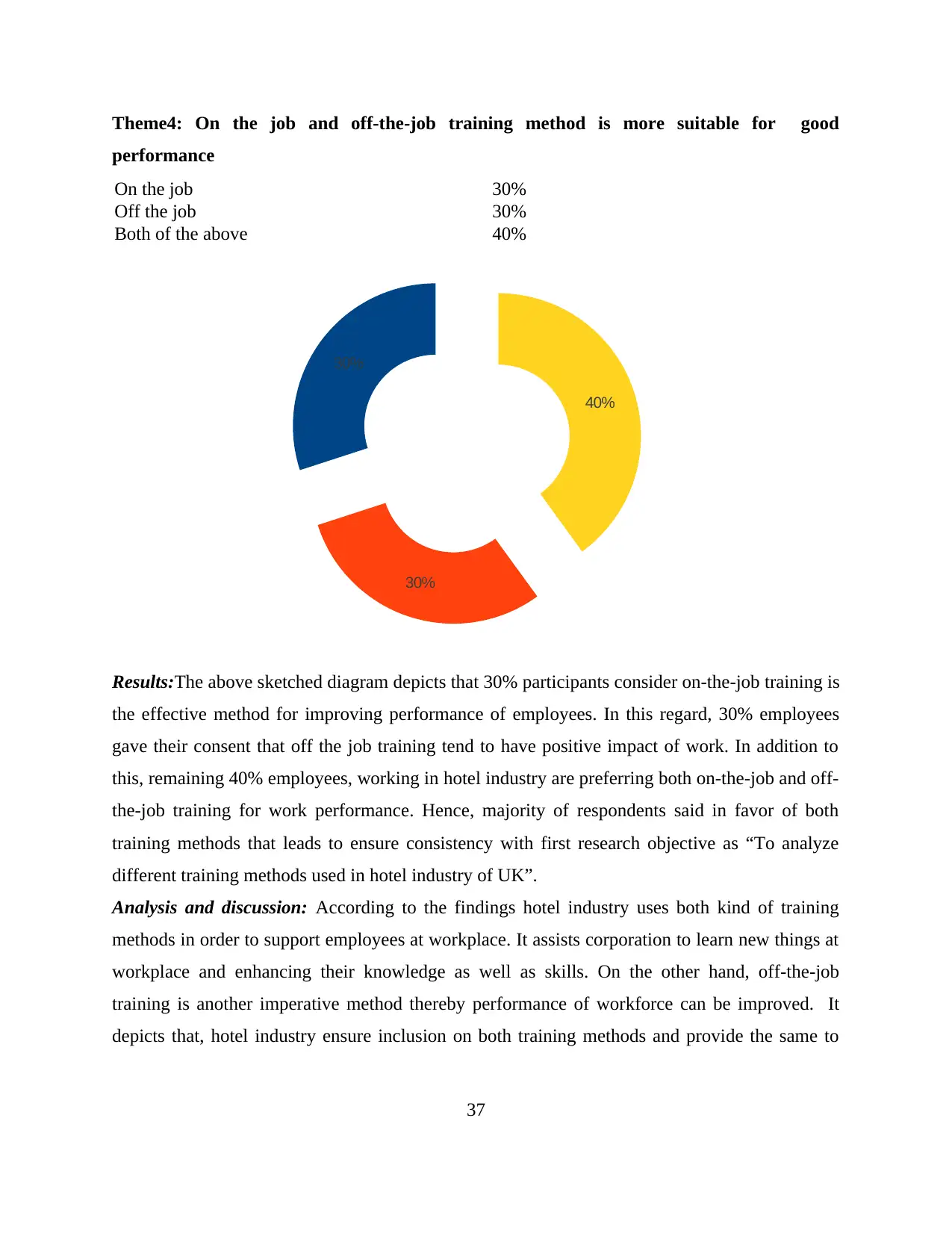
Theme4: On the job and off-the-job training method is more suitable for good
performance
On the job 30%
Off the job 30%
Both of the above 40%
Results:The above sketched diagram depicts that 30% participants consider on-the-job training is
the effective method for improving performance of employees. In this regard, 30% employees
gave their consent that off the job training tend to have positive impact of work. In addition to
this, remaining 40% employees, working in hotel industry are preferring both on-the-job and off-
the-job training for work performance. Hence, majority of respondents said in favor of both
training methods that leads to ensure consistency with first research objective as “To analyze
different training methods used in hotel industry of UK”.
Analysis and discussion: According to the findings hotel industry uses both kind of training
methods in order to support employees at workplace. It assists corporation to learn new things at
workplace and enhancing their knowledge as well as skills. On the other hand, off-the-job
training is another imperative method thereby performance of workforce can be improved. It
depicts that, hotel industry ensure inclusion on both training methods and provide the same to
37
30%
30%
40%
performance
On the job 30%
Off the job 30%
Both of the above 40%
Results:The above sketched diagram depicts that 30% participants consider on-the-job training is
the effective method for improving performance of employees. In this regard, 30% employees
gave their consent that off the job training tend to have positive impact of work. In addition to
this, remaining 40% employees, working in hotel industry are preferring both on-the-job and off-
the-job training for work performance. Hence, majority of respondents said in favor of both
training methods that leads to ensure consistency with first research objective as “To analyze
different training methods used in hotel industry of UK”.
Analysis and discussion: According to the findings hotel industry uses both kind of training
methods in order to support employees at workplace. It assists corporation to learn new things at
workplace and enhancing their knowledge as well as skills. On the other hand, off-the-job
training is another imperative method thereby performance of workforce can be improved. It
depicts that, hotel industry ensure inclusion on both training methods and provide the same to
37
30%
30%
40%
Secure Best Marks with AI Grader
Need help grading? Try our AI Grader for instant feedback on your assignments.
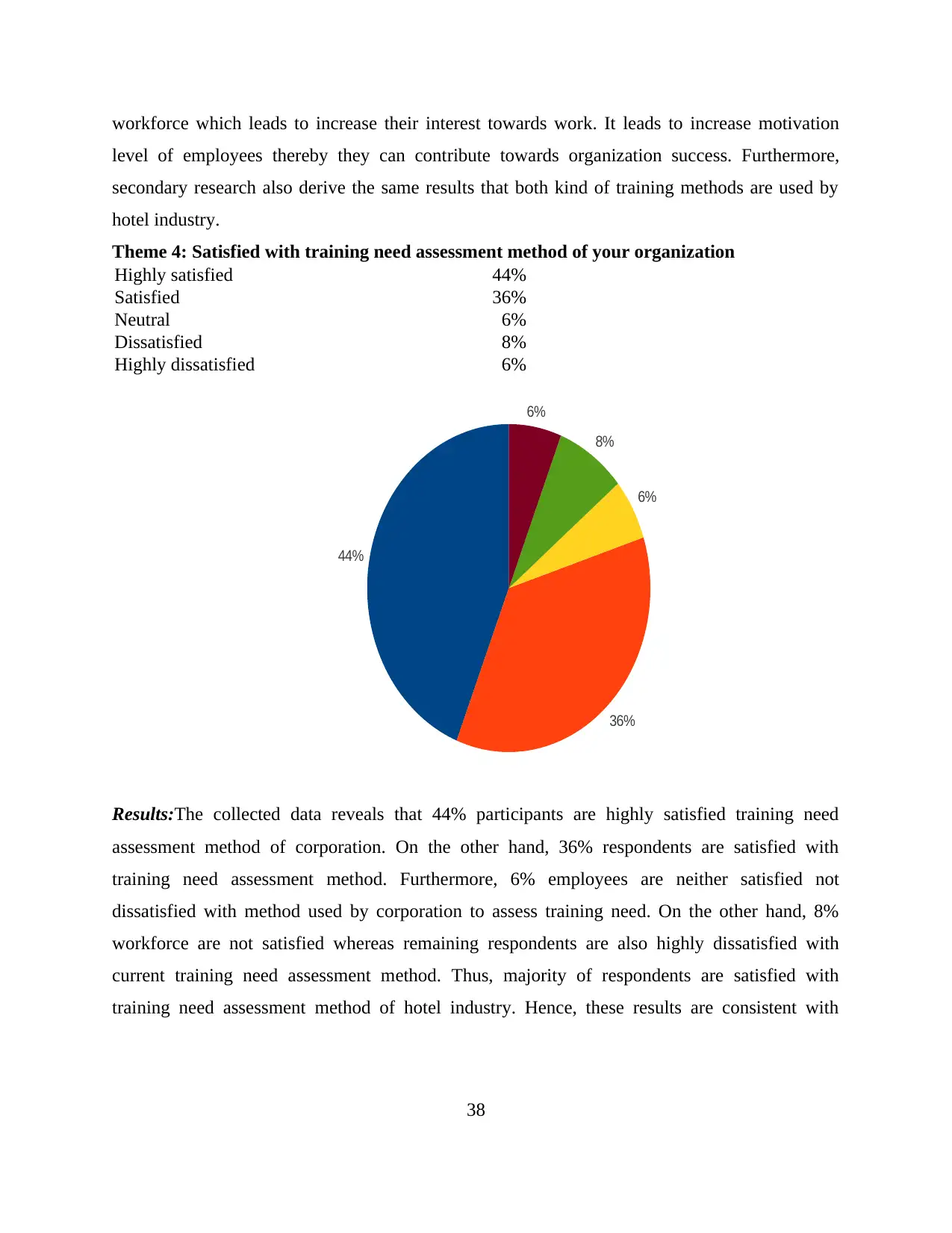
workforce which leads to increase their interest towards work. It leads to increase motivation
level of employees thereby they can contribute towards organization success. Furthermore,
secondary research also derive the same results that both kind of training methods are used by
hotel industry.
Theme 4: Satisfied with training need assessment method of your organization
Highly satisfied 44%
Satisfied 36%
Neutral 6%
Dissatisfied 8%
Highly dissatisfied 6%
Results:The collected data reveals that 44% participants are highly satisfied training need
assessment method of corporation. On the other hand, 36% respondents are satisfied with
training need assessment method. Furthermore, 6% employees are neither satisfied not
dissatisfied with method used by corporation to assess training need. On the other hand, 8%
workforce are not satisfied whereas remaining respondents are also highly dissatisfied with
current training need assessment method. Thus, majority of respondents are satisfied with
training need assessment method of hotel industry. Hence, these results are consistent with
38
44%
36%
6%
8%
6%
level of employees thereby they can contribute towards organization success. Furthermore,
secondary research also derive the same results that both kind of training methods are used by
hotel industry.
Theme 4: Satisfied with training need assessment method of your organization
Highly satisfied 44%
Satisfied 36%
Neutral 6%
Dissatisfied 8%
Highly dissatisfied 6%
Results:The collected data reveals that 44% participants are highly satisfied training need
assessment method of corporation. On the other hand, 36% respondents are satisfied with
training need assessment method. Furthermore, 6% employees are neither satisfied not
dissatisfied with method used by corporation to assess training need. On the other hand, 8%
workforce are not satisfied whereas remaining respondents are also highly dissatisfied with
current training need assessment method. Thus, majority of respondents are satisfied with
training need assessment method of hotel industry. Hence, these results are consistent with
38
44%
36%
6%
8%
6%
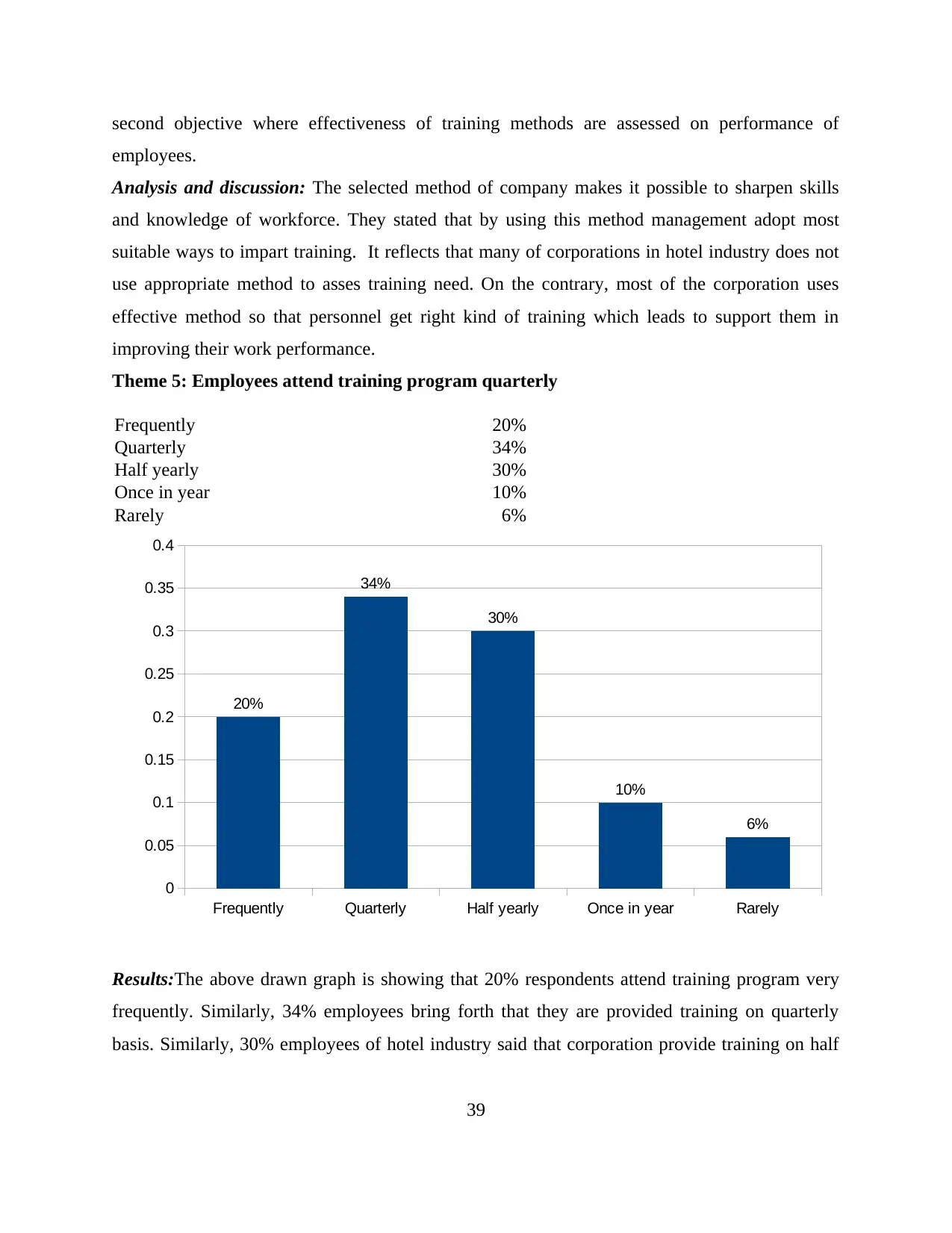
second objective where effectiveness of training methods are assessed on performance of
employees.
Analysis and discussion: The selected method of company makes it possible to sharpen skills
and knowledge of workforce. They stated that by using this method management adopt most
suitable ways to impart training. It reflects that many of corporations in hotel industry does not
use appropriate method to asses training need. On the contrary, most of the corporation uses
effective method so that personnel get right kind of training which leads to support them in
improving their work performance.
Theme 5: Employees attend training program quarterly
Frequently 20%
Quarterly 34%
Half yearly 30%
Once in year 10%
Rarely 6%
Results:The above drawn graph is showing that 20% respondents attend training program very
frequently. Similarly, 34% employees bring forth that they are provided training on quarterly
basis. Similarly, 30% employees of hotel industry said that corporation provide training on half
39
Frequently Quarterly Half yearly Once in year Rarely
0
0.05
0.1
0.15
0.2
0.25
0.3
0.35
0.4
20%
34%
30%
10%
6%
employees.
Analysis and discussion: The selected method of company makes it possible to sharpen skills
and knowledge of workforce. They stated that by using this method management adopt most
suitable ways to impart training. It reflects that many of corporations in hotel industry does not
use appropriate method to asses training need. On the contrary, most of the corporation uses
effective method so that personnel get right kind of training which leads to support them in
improving their work performance.
Theme 5: Employees attend training program quarterly
Frequently 20%
Quarterly 34%
Half yearly 30%
Once in year 10%
Rarely 6%
Results:The above drawn graph is showing that 20% respondents attend training program very
frequently. Similarly, 34% employees bring forth that they are provided training on quarterly
basis. Similarly, 30% employees of hotel industry said that corporation provide training on half
39
Frequently Quarterly Half yearly Once in year Rarely
0
0.05
0.1
0.15
0.2
0.25
0.3
0.35
0.4
20%
34%
30%
10%
6%
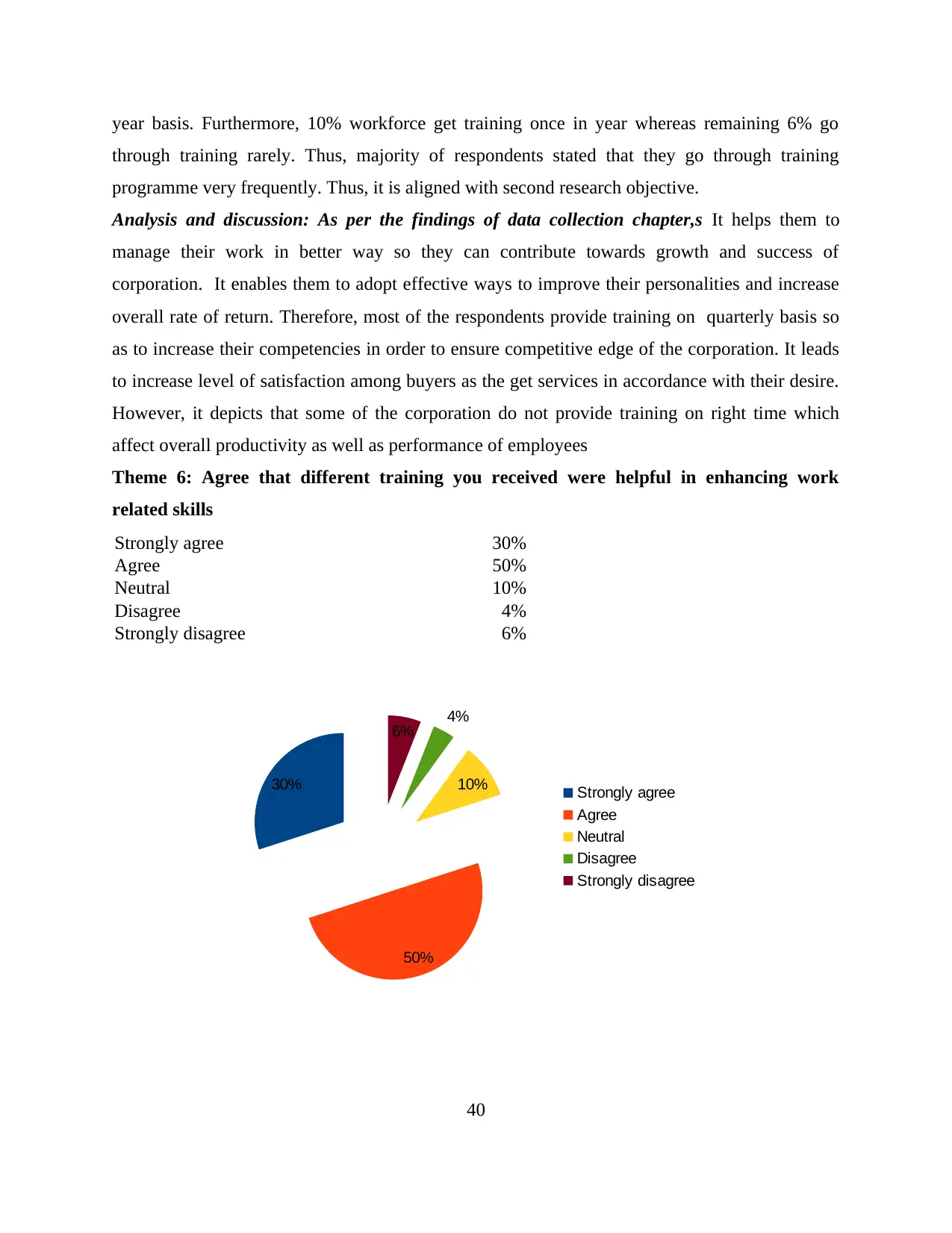
year basis. Furthermore, 10% workforce get training once in year whereas remaining 6% go
through training rarely. Thus, majority of respondents stated that they go through training
programme very frequently. Thus, it is aligned with second research objective.
Analysis and discussion: As per the findings of data collection chapter,s It helps them to
manage their work in better way so they can contribute towards growth and success of
corporation. It enables them to adopt effective ways to improve their personalities and increase
overall rate of return. Therefore, most of the respondents provide training on quarterly basis so
as to increase their competencies in order to ensure competitive edge of the corporation. It leads
to increase level of satisfaction among buyers as the get services in accordance with their desire.
However, it depicts that some of the corporation do not provide training on right time which
affect overall productivity as well as performance of employees
Theme 6: Agree that different training you received were helpful in enhancing work
related skills
Strongly agree 30%
Agree 50%
Neutral 10%
Disagree 4%
Strongly disagree 6%
40
30%
50%
10%
4%
6%
Strongly agree
Agree
Neutral
Disagree
Strongly disagree
through training rarely. Thus, majority of respondents stated that they go through training
programme very frequently. Thus, it is aligned with second research objective.
Analysis and discussion: As per the findings of data collection chapter,s It helps them to
manage their work in better way so they can contribute towards growth and success of
corporation. It enables them to adopt effective ways to improve their personalities and increase
overall rate of return. Therefore, most of the respondents provide training on quarterly basis so
as to increase their competencies in order to ensure competitive edge of the corporation. It leads
to increase level of satisfaction among buyers as the get services in accordance with their desire.
However, it depicts that some of the corporation do not provide training on right time which
affect overall productivity as well as performance of employees
Theme 6: Agree that different training you received were helpful in enhancing work
related skills
Strongly agree 30%
Agree 50%
Neutral 10%
Disagree 4%
Strongly disagree 6%
40
30%
50%
10%
4%
6%
Strongly agree
Agree
Neutral
Disagree
Strongly disagree
Paraphrase This Document
Need a fresh take? Get an instant paraphrase of this document with our AI Paraphraser
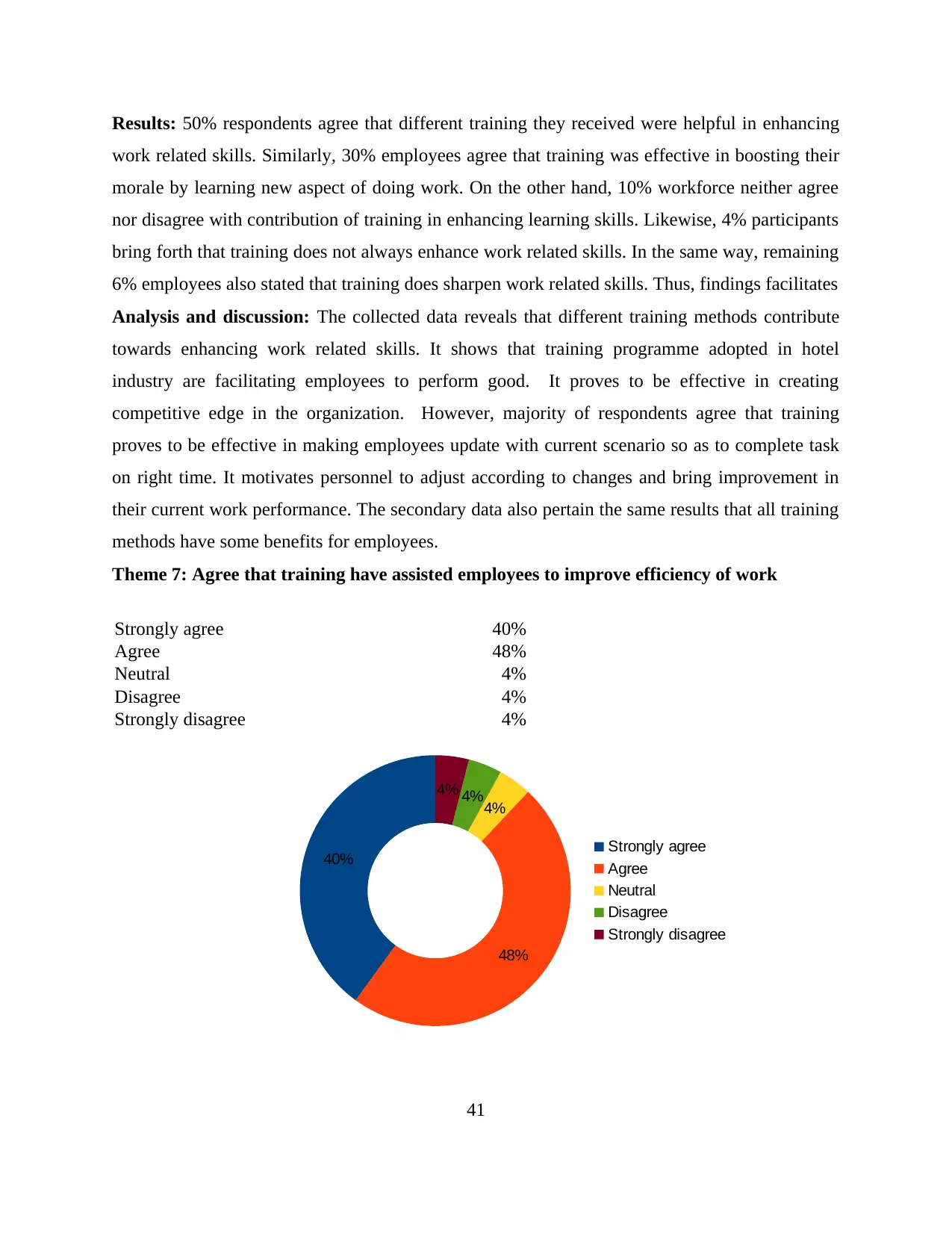
Results: 50% respondents agree that different training they received were helpful in enhancing
work related skills. Similarly, 30% employees agree that training was effective in boosting their
morale by learning new aspect of doing work. On the other hand, 10% workforce neither agree
nor disagree with contribution of training in enhancing learning skills. Likewise, 4% participants
bring forth that training does not always enhance work related skills. In the same way, remaining
6% employees also stated that training does sharpen work related skills. Thus, findings facilitates
Analysis and discussion: The collected data reveals that different training methods contribute
towards enhancing work related skills. It shows that training programme adopted in hotel
industry are facilitating employees to perform good. It proves to be effective in creating
competitive edge in the organization. However, majority of respondents agree that training
proves to be effective in making employees update with current scenario so as to complete task
on right time. It motivates personnel to adjust according to changes and bring improvement in
their current work performance. The secondary data also pertain the same results that all training
methods have some benefits for employees.
Theme 7: Agree that training have assisted employees to improve efficiency of work
Strongly agree 40%
Agree 48%
Neutral 4%
Disagree 4%
Strongly disagree 4%
41
40%
48%
4%
4%4%
Strongly agree
Agree
Neutral
Disagree
Strongly disagree
work related skills. Similarly, 30% employees agree that training was effective in boosting their
morale by learning new aspect of doing work. On the other hand, 10% workforce neither agree
nor disagree with contribution of training in enhancing learning skills. Likewise, 4% participants
bring forth that training does not always enhance work related skills. In the same way, remaining
6% employees also stated that training does sharpen work related skills. Thus, findings facilitates
Analysis and discussion: The collected data reveals that different training methods contribute
towards enhancing work related skills. It shows that training programme adopted in hotel
industry are facilitating employees to perform good. It proves to be effective in creating
competitive edge in the organization. However, majority of respondents agree that training
proves to be effective in making employees update with current scenario so as to complete task
on right time. It motivates personnel to adjust according to changes and bring improvement in
their current work performance. The secondary data also pertain the same results that all training
methods have some benefits for employees.
Theme 7: Agree that training have assisted employees to improve efficiency of work
Strongly agree 40%
Agree 48%
Neutral 4%
Disagree 4%
Strongly disagree 4%
41
40%
48%
4%
4%4%
Strongly agree
Agree
Neutral
Disagree
Strongly disagree

Results:The above sketched diagrams is showing that 40% employees of hotel industry strongly
agree efficiency of work can be increased through training programme. Majority of respondents
(48%) agree that training have assisted them to improvement in work efficiency. 4% personnel
neither agree nor disagree regarding efficiency in work with regards to training. 4 % employees
of hotel industry disagree with role of training on quality of work. In addition to this, remaining
4% workforce strongly disagree and stated that training program motivate employees. The
findings shed light on second research objectives as “assess the effectiveness of on the job and
off the job training method on performance of employee in hotel industry of UK”. Hence, the
second objectives is achieved.
Analysis and discussion: The collected primary data are showing that employees noticed
significant impact of work quality after attending training programme. It also assists them to
carry out all business activities effectively and meet expectations of large number of buyers.
After getting training they get motivation and overall of quality of their work is improved. They
also stated that is not necessary that training increase work quality. Thus, majority of employees
consider that training program assisted them in bringing improvement in work quality. However,
it enables them to perform good in organization and get rewards for their better performance.
Therefore, primary data and secondary data bring forth the same outcome that training tend to
affect performance of employees in positive manner. Although selection of appropriate training
method is based on requirement of corporation as well as workforce.
Theme 8: On-the-job training is outstanding
Outstanding 40%
Excellent 20%
Good 20%
Average 20%
42
agree efficiency of work can be increased through training programme. Majority of respondents
(48%) agree that training have assisted them to improvement in work efficiency. 4% personnel
neither agree nor disagree regarding efficiency in work with regards to training. 4 % employees
of hotel industry disagree with role of training on quality of work. In addition to this, remaining
4% workforce strongly disagree and stated that training program motivate employees. The
findings shed light on second research objectives as “assess the effectiveness of on the job and
off the job training method on performance of employee in hotel industry of UK”. Hence, the
second objectives is achieved.
Analysis and discussion: The collected primary data are showing that employees noticed
significant impact of work quality after attending training programme. It also assists them to
carry out all business activities effectively and meet expectations of large number of buyers.
After getting training they get motivation and overall of quality of their work is improved. They
also stated that is not necessary that training increase work quality. Thus, majority of employees
consider that training program assisted them in bringing improvement in work quality. However,
it enables them to perform good in organization and get rewards for their better performance.
Therefore, primary data and secondary data bring forth the same outcome that training tend to
affect performance of employees in positive manner. Although selection of appropriate training
method is based on requirement of corporation as well as workforce.
Theme 8: On-the-job training is outstanding
Outstanding 40%
Excellent 20%
Good 20%
Average 20%
42
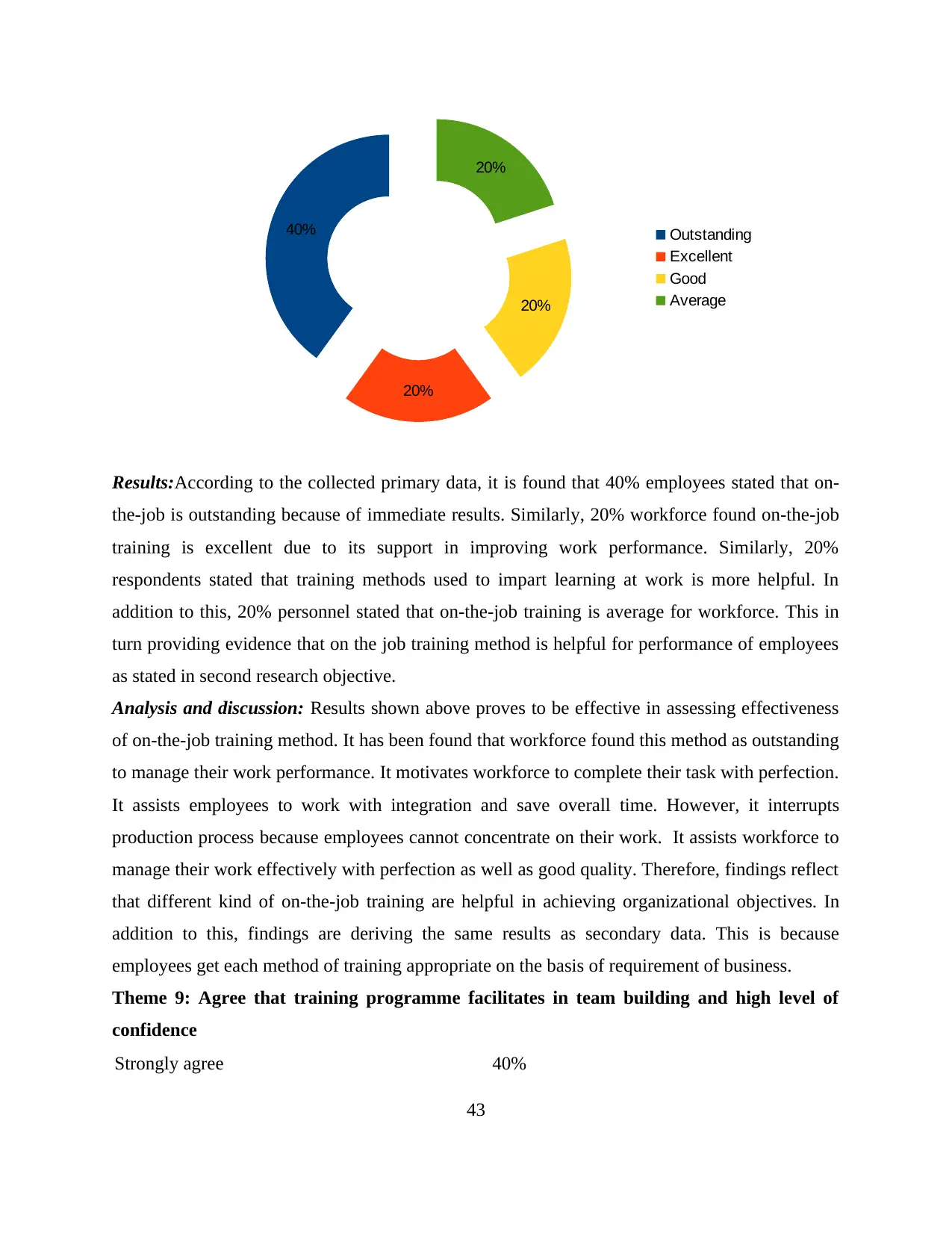
Results:According to the collected primary data, it is found that 40% employees stated that on-
the-job is outstanding because of immediate results. Similarly, 20% workforce found on-the-job
training is excellent due to its support in improving work performance. Similarly, 20%
respondents stated that training methods used to impart learning at work is more helpful. In
addition to this, 20% personnel stated that on-the-job training is average for workforce. This in
turn providing evidence that on the job training method is helpful for performance of employees
as stated in second research objective.
Analysis and discussion: Results shown above proves to be effective in assessing effectiveness
of on-the-job training method. It has been found that workforce found this method as outstanding
to manage their work performance. It motivates workforce to complete their task with perfection.
It assists employees to work with integration and save overall time. However, it interrupts
production process because employees cannot concentrate on their work. It assists workforce to
manage their work effectively with perfection as well as good quality. Therefore, findings reflect
that different kind of on-the-job training are helpful in achieving organizational objectives. In
addition to this, findings are deriving the same results as secondary data. This is because
employees get each method of training appropriate on the basis of requirement of business.
Theme 9: Agree that training programme facilitates in team building and high level of
confidence
Strongly agree 40%
43
40%
20%
20%
20%
Outstanding
Excellent
Good
Average
the-job is outstanding because of immediate results. Similarly, 20% workforce found on-the-job
training is excellent due to its support in improving work performance. Similarly, 20%
respondents stated that training methods used to impart learning at work is more helpful. In
addition to this, 20% personnel stated that on-the-job training is average for workforce. This in
turn providing evidence that on the job training method is helpful for performance of employees
as stated in second research objective.
Analysis and discussion: Results shown above proves to be effective in assessing effectiveness
of on-the-job training method. It has been found that workforce found this method as outstanding
to manage their work performance. It motivates workforce to complete their task with perfection.
It assists employees to work with integration and save overall time. However, it interrupts
production process because employees cannot concentrate on their work. It assists workforce to
manage their work effectively with perfection as well as good quality. Therefore, findings reflect
that different kind of on-the-job training are helpful in achieving organizational objectives. In
addition to this, findings are deriving the same results as secondary data. This is because
employees get each method of training appropriate on the basis of requirement of business.
Theme 9: Agree that training programme facilitates in team building and high level of
confidence
Strongly agree 40%
43
40%
20%
20%
20%
Outstanding
Excellent
Good
Average
Secure Best Marks with AI Grader
Need help grading? Try our AI Grader for instant feedback on your assignments.
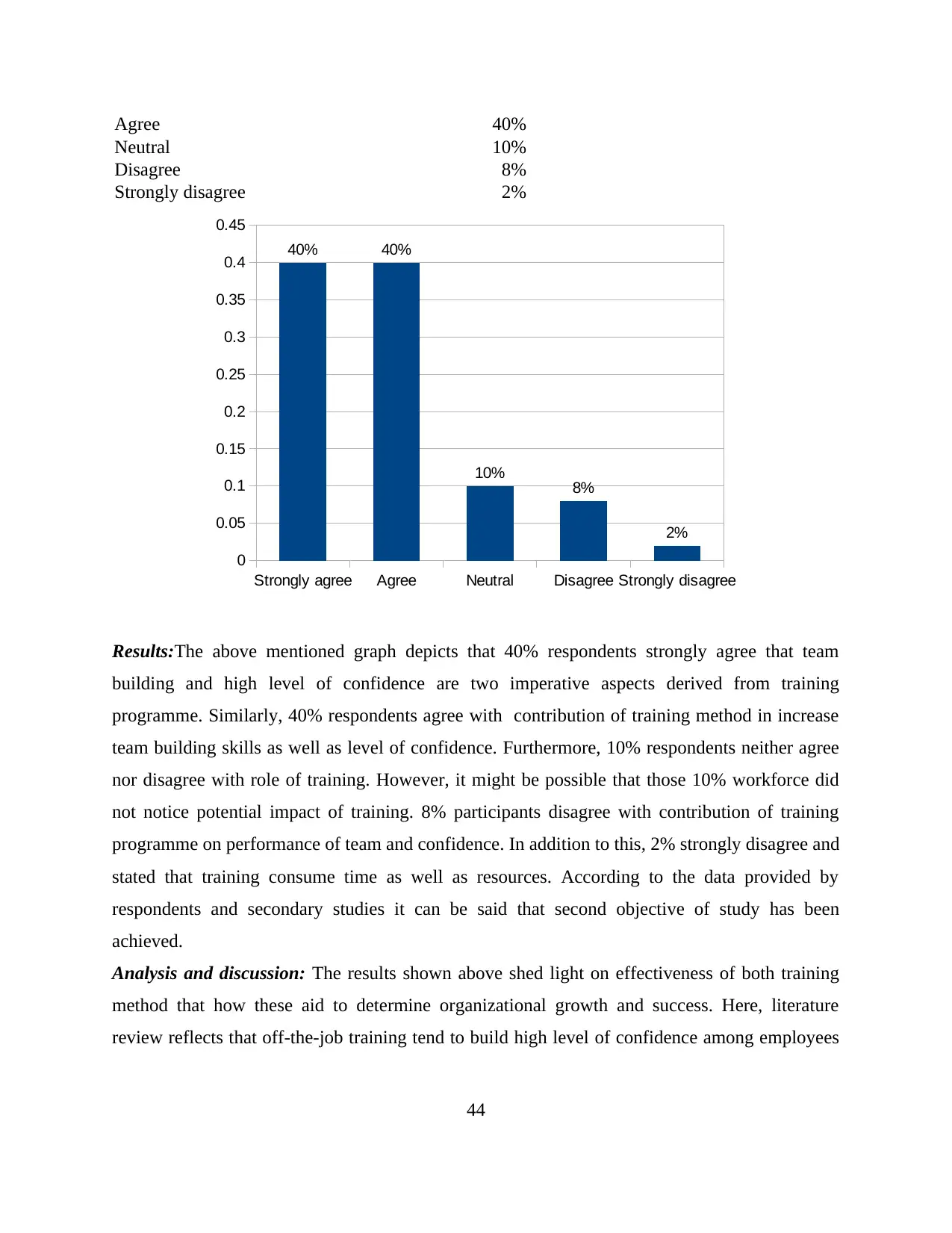
Agree 40%
Neutral 10%
Disagree 8%
Strongly disagree 2%
Results:The above mentioned graph depicts that 40% respondents strongly agree that team
building and high level of confidence are two imperative aspects derived from training
programme. Similarly, 40% respondents agree with contribution of training method in increase
team building skills as well as level of confidence. Furthermore, 10% respondents neither agree
nor disagree with role of training. However, it might be possible that those 10% workforce did
not notice potential impact of training. 8% participants disagree with contribution of training
programme on performance of team and confidence. In addition to this, 2% strongly disagree and
stated that training consume time as well as resources. According to the data provided by
respondents and secondary studies it can be said that second objective of study has been
achieved.
Analysis and discussion: The results shown above shed light on effectiveness of both training
method that how these aid to determine organizational growth and success. Here, literature
review reflects that off-the-job training tend to build high level of confidence among employees
44
Strongly agree Agree Neutral Disagree Strongly disagree
0
0.05
0.1
0.15
0.2
0.25
0.3
0.35
0.4
0.45
40% 40%
10% 8%
2%
Neutral 10%
Disagree 8%
Strongly disagree 2%
Results:The above mentioned graph depicts that 40% respondents strongly agree that team
building and high level of confidence are two imperative aspects derived from training
programme. Similarly, 40% respondents agree with contribution of training method in increase
team building skills as well as level of confidence. Furthermore, 10% respondents neither agree
nor disagree with role of training. However, it might be possible that those 10% workforce did
not notice potential impact of training. 8% participants disagree with contribution of training
programme on performance of team and confidence. In addition to this, 2% strongly disagree and
stated that training consume time as well as resources. According to the data provided by
respondents and secondary studies it can be said that second objective of study has been
achieved.
Analysis and discussion: The results shown above shed light on effectiveness of both training
method that how these aid to determine organizational growth and success. Here, literature
review reflects that off-the-job training tend to build high level of confidence among employees
44
Strongly agree Agree Neutral Disagree Strongly disagree
0
0.05
0.1
0.15
0.2
0.25
0.3
0.35
0.4
0.45
40% 40%
10% 8%
2%
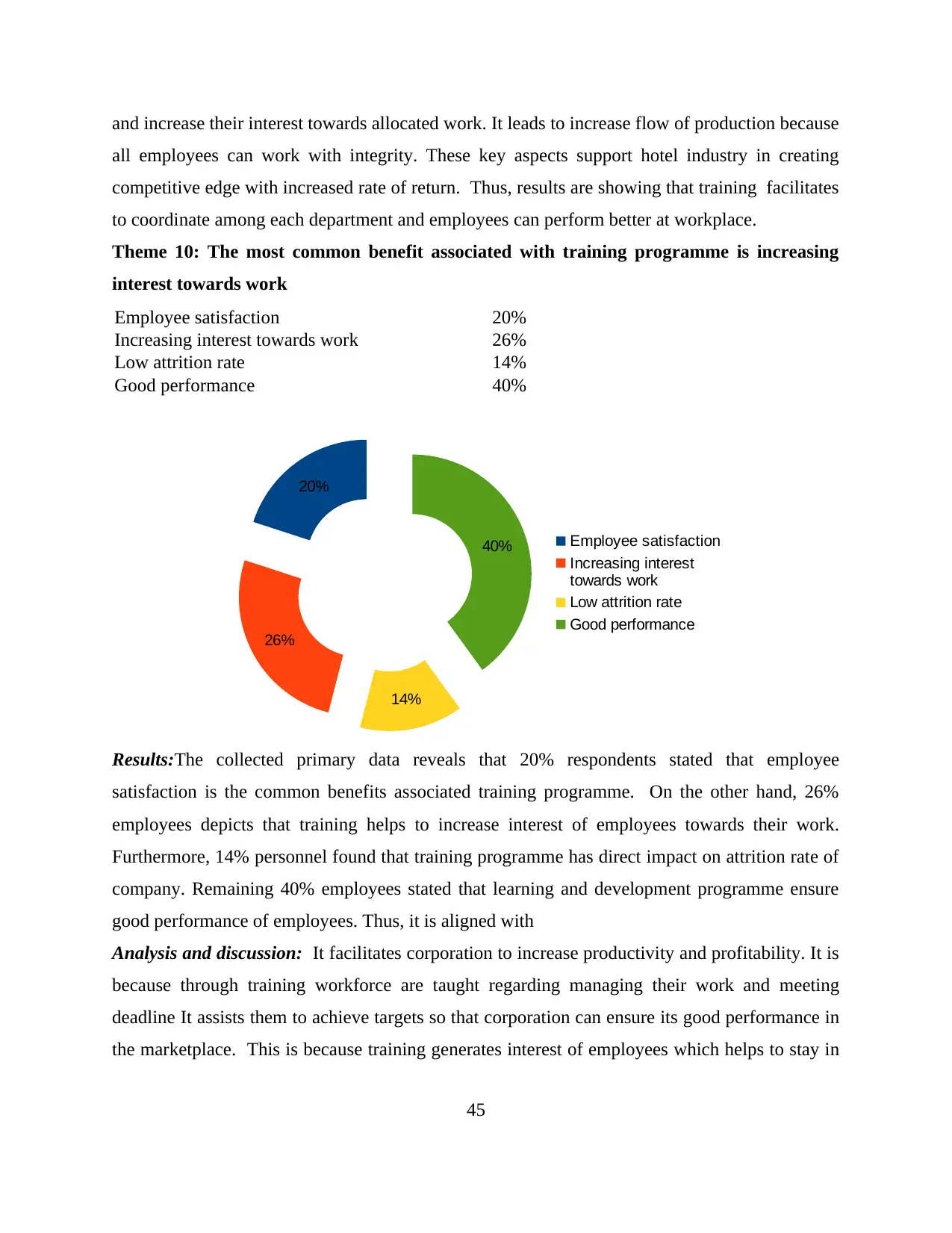
and increase their interest towards allocated work. It leads to increase flow of production because
all employees can work with integrity. These key aspects support hotel industry in creating
competitive edge with increased rate of return. Thus, results are showing that training facilitates
to coordinate among each department and employees can perform better at workplace.
Theme 10: The most common benefit associated with training programme is increasing
interest towards work
Employee satisfaction 20%
Increasing interest towards work 26%
Low attrition rate 14%
Good performance 40%
Results:The collected primary data reveals that 20% respondents stated that employee
satisfaction is the common benefits associated training programme. On the other hand, 26%
employees depicts that training helps to increase interest of employees towards their work.
Furthermore, 14% personnel found that training programme has direct impact on attrition rate of
company. Remaining 40% employees stated that learning and development programme ensure
good performance of employees. Thus, it is aligned with
Analysis and discussion: It facilitates corporation to increase productivity and profitability. It is
because through training workforce are taught regarding managing their work and meeting
deadline It assists them to achieve targets so that corporation can ensure its good performance in
the marketplace. This is because training generates interest of employees which helps to stay in
45
20%
26%
14%
40% Employee satisfaction
Increasing interest
towards work
Low attrition rate
Good performance
all employees can work with integrity. These key aspects support hotel industry in creating
competitive edge with increased rate of return. Thus, results are showing that training facilitates
to coordinate among each department and employees can perform better at workplace.
Theme 10: The most common benefit associated with training programme is increasing
interest towards work
Employee satisfaction 20%
Increasing interest towards work 26%
Low attrition rate 14%
Good performance 40%
Results:The collected primary data reveals that 20% respondents stated that employee
satisfaction is the common benefits associated training programme. On the other hand, 26%
employees depicts that training helps to increase interest of employees towards their work.
Furthermore, 14% personnel found that training programme has direct impact on attrition rate of
company. Remaining 40% employees stated that learning and development programme ensure
good performance of employees. Thus, it is aligned with
Analysis and discussion: It facilitates corporation to increase productivity and profitability. It is
because through training workforce are taught regarding managing their work and meeting
deadline It assists them to achieve targets so that corporation can ensure its good performance in
the marketplace. This is because training generates interest of employees which helps to stay in
45
20%
26%
14%
40% Employee satisfaction
Increasing interest
towards work
Low attrition rate
Good performance
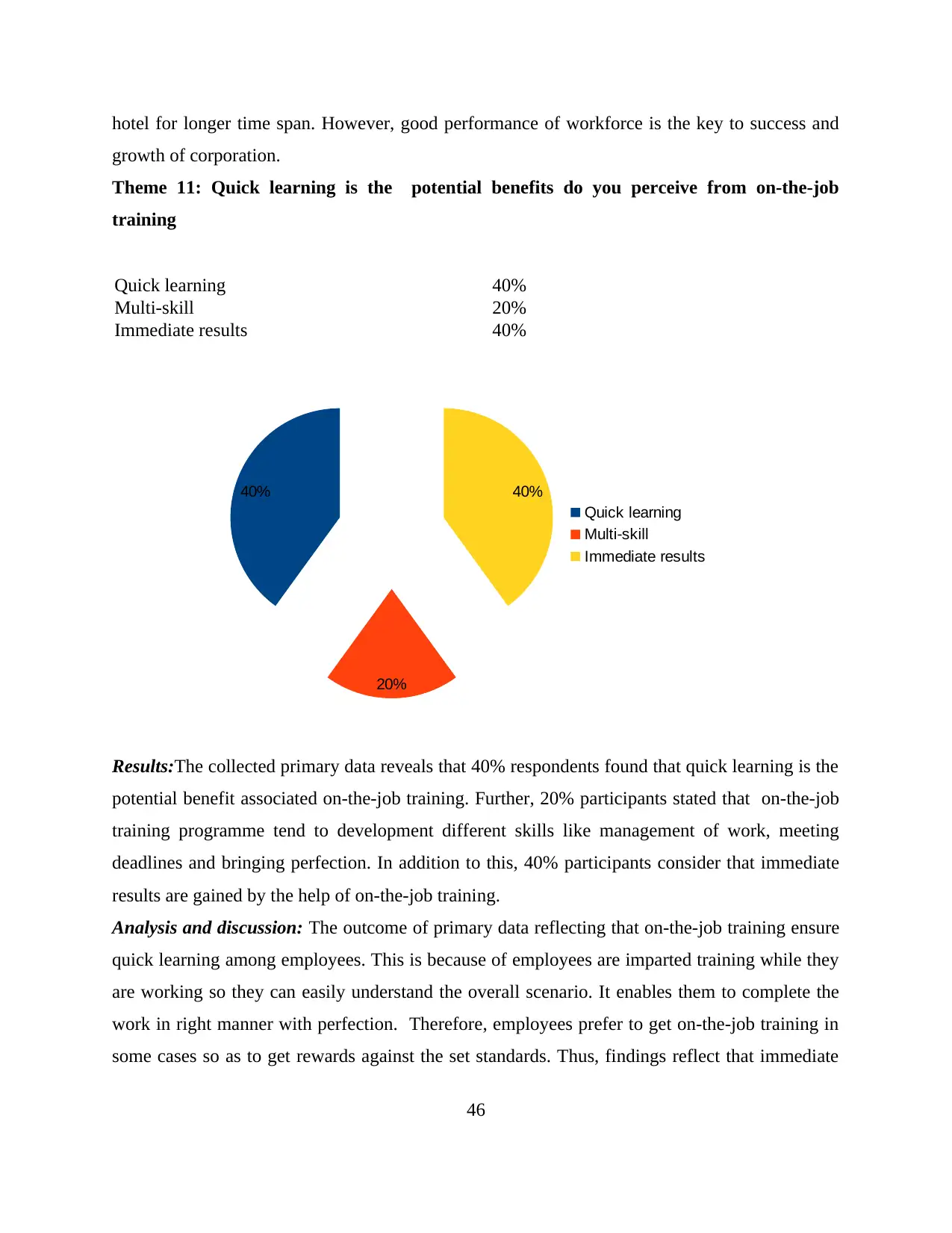
hotel for longer time span. However, good performance of workforce is the key to success and
growth of corporation.
Theme 11: Quick learning is the potential benefits do you perceive from on-the-job
training
Quick learning 40%
Multi-skill 20%
Immediate results 40%
Results:The collected primary data reveals that 40% respondents found that quick learning is the
potential benefit associated on-the-job training. Further, 20% participants stated that on-the-job
training programme tend to development different skills like management of work, meeting
deadlines and bringing perfection. In addition to this, 40% participants consider that immediate
results are gained by the help of on-the-job training.
Analysis and discussion: The outcome of primary data reflecting that on-the-job training ensure
quick learning among employees. This is because of employees are imparted training while they
are working so they can easily understand the overall scenario. It enables them to complete the
work in right manner with perfection. Therefore, employees prefer to get on-the-job training in
some cases so as to get rewards against the set standards. Thus, findings reflect that immediate
46
40%
20%
40%
Quick learning
Multi-skill
Immediate results
growth of corporation.
Theme 11: Quick learning is the potential benefits do you perceive from on-the-job
training
Quick learning 40%
Multi-skill 20%
Immediate results 40%
Results:The collected primary data reveals that 40% respondents found that quick learning is the
potential benefit associated on-the-job training. Further, 20% participants stated that on-the-job
training programme tend to development different skills like management of work, meeting
deadlines and bringing perfection. In addition to this, 40% participants consider that immediate
results are gained by the help of on-the-job training.
Analysis and discussion: The outcome of primary data reflecting that on-the-job training ensure
quick learning among employees. This is because of employees are imparted training while they
are working so they can easily understand the overall scenario. It enables them to complete the
work in right manner with perfection. Therefore, employees prefer to get on-the-job training in
some cases so as to get rewards against the set standards. Thus, findings reflect that immediate
46
40%
20%
40%
Quick learning
Multi-skill
Immediate results
Paraphrase This Document
Need a fresh take? Get an instant paraphrase of this document with our AI Paraphraser
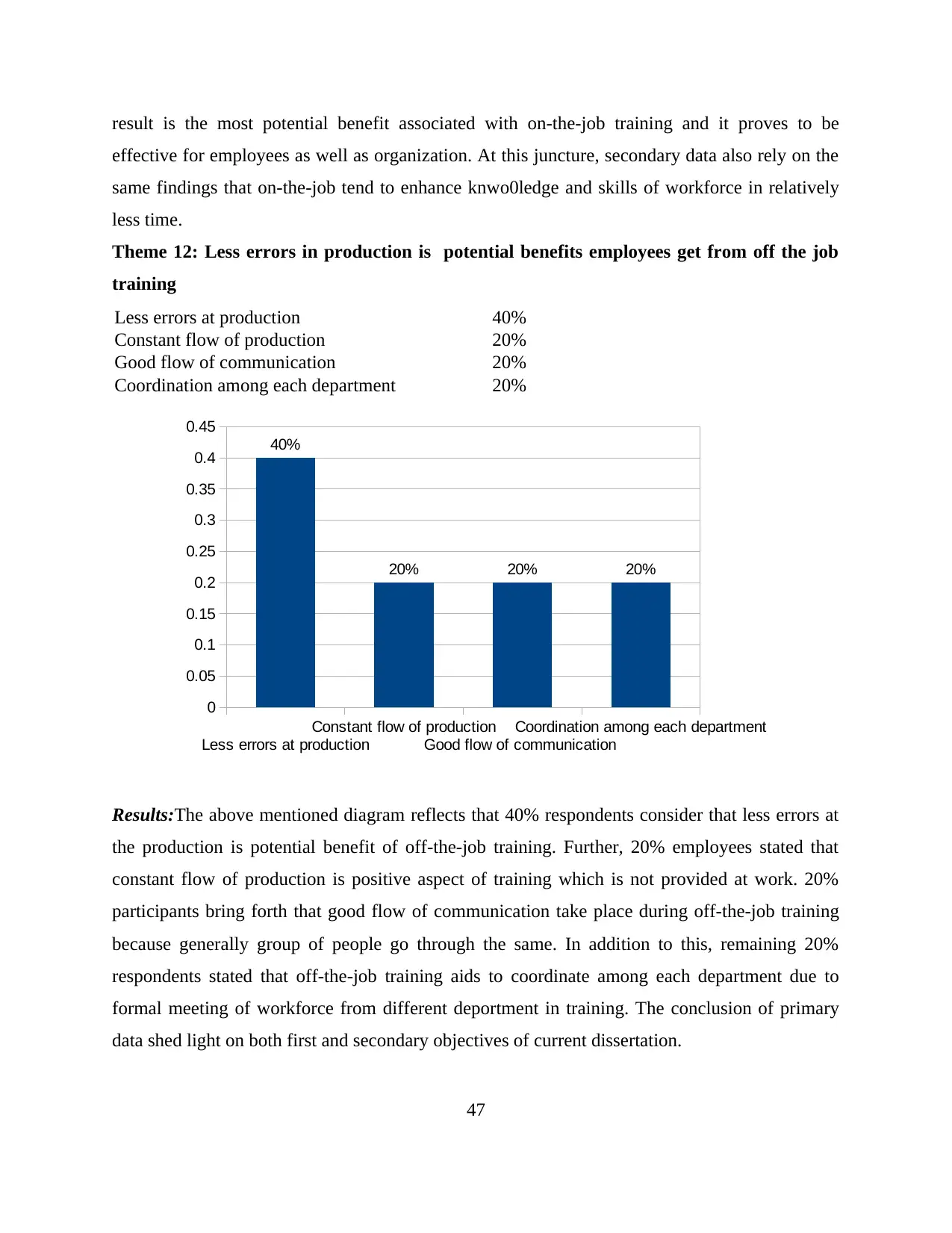
result is the most potential benefit associated with on-the-job training and it proves to be
effective for employees as well as organization. At this juncture, secondary data also rely on the
same findings that on-the-job tend to enhance knwo0ledge and skills of workforce in relatively
less time.
Theme 12: Less errors in production is potential benefits employees get from off the job
training
Less errors at production 40%
Constant flow of production 20%
Good flow of communication 20%
Coordination among each department 20%
Results:The above mentioned diagram reflects that 40% respondents consider that less errors at
the production is potential benefit of off-the-job training. Further, 20% employees stated that
constant flow of production is positive aspect of training which is not provided at work. 20%
participants bring forth that good flow of communication take place during off-the-job training
because generally group of people go through the same. In addition to this, remaining 20%
respondents stated that off-the-job training aids to coordinate among each department due to
formal meeting of workforce from different deportment in training. The conclusion of primary
data shed light on both first and secondary objectives of current dissertation.
47
Less errors at production
Constant flow of production
Good flow of communication
Coordination among each department
0
0.05
0.1
0.15
0.2
0.25
0.3
0.35
0.4
0.45
40%
20% 20% 20%
effective for employees as well as organization. At this juncture, secondary data also rely on the
same findings that on-the-job tend to enhance knwo0ledge and skills of workforce in relatively
less time.
Theme 12: Less errors in production is potential benefits employees get from off the job
training
Less errors at production 40%
Constant flow of production 20%
Good flow of communication 20%
Coordination among each department 20%
Results:The above mentioned diagram reflects that 40% respondents consider that less errors at
the production is potential benefit of off-the-job training. Further, 20% employees stated that
constant flow of production is positive aspect of training which is not provided at work. 20%
participants bring forth that good flow of communication take place during off-the-job training
because generally group of people go through the same. In addition to this, remaining 20%
respondents stated that off-the-job training aids to coordinate among each department due to
formal meeting of workforce from different deportment in training. The conclusion of primary
data shed light on both first and secondary objectives of current dissertation.
47
Less errors at production
Constant flow of production
Good flow of communication
Coordination among each department
0
0.05
0.1
0.15
0.2
0.25
0.3
0.35
0.4
0.45
40%
20% 20% 20%
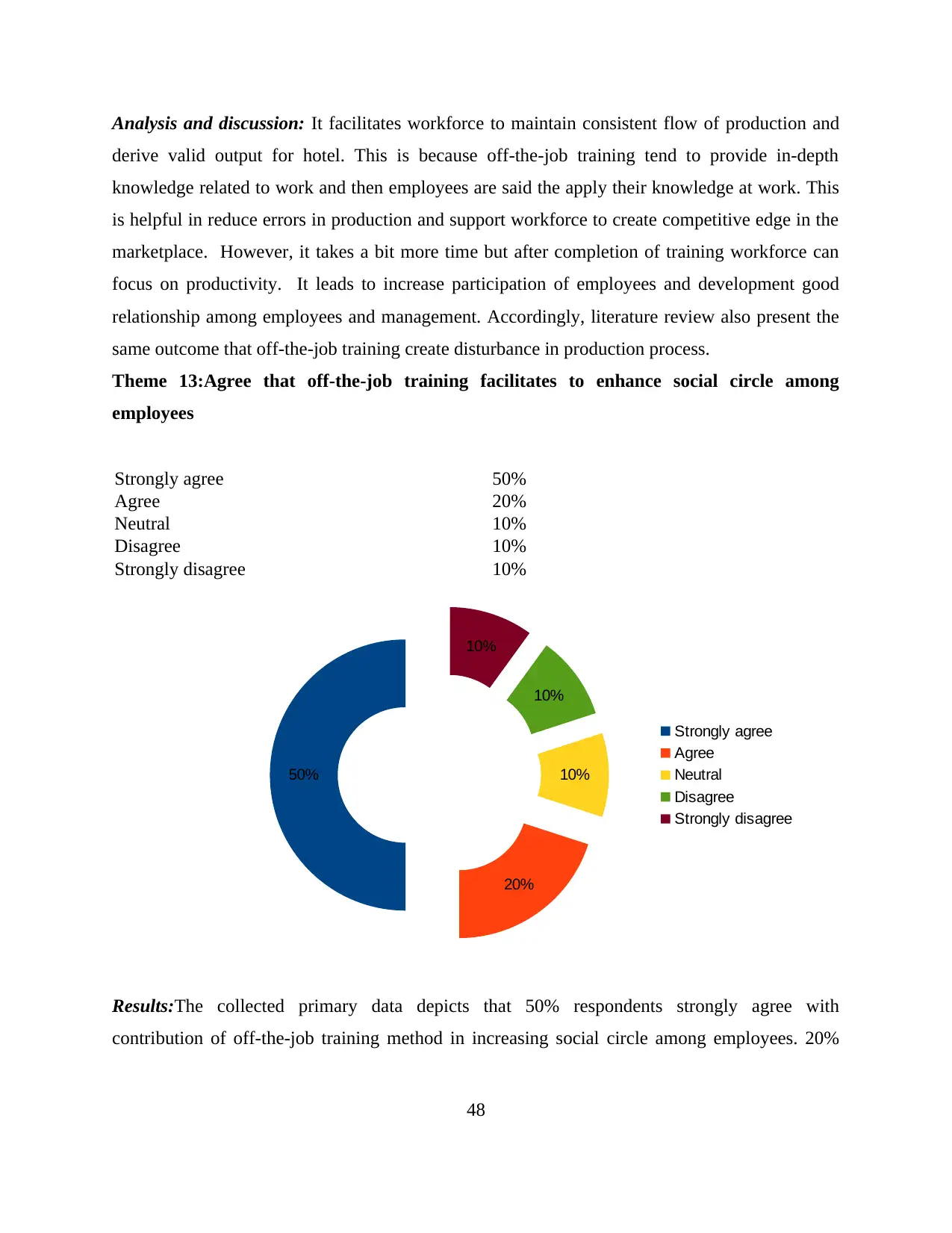
Analysis and discussion: It facilitates workforce to maintain consistent flow of production and
derive valid output for hotel. This is because off-the-job training tend to provide in-depth
knowledge related to work and then employees are said the apply their knowledge at work. This
is helpful in reduce errors in production and support workforce to create competitive edge in the
marketplace. However, it takes a bit more time but after completion of training workforce can
focus on productivity. It leads to increase participation of employees and development good
relationship among employees and management. Accordingly, literature review also present the
same outcome that off-the-job training create disturbance in production process.
Theme 13:Agree that off-the-job training facilitates to enhance social circle among
employees
Strongly agree 50%
Agree 20%
Neutral 10%
Disagree 10%
Strongly disagree 10%
Results:The collected primary data depicts that 50% respondents strongly agree with
contribution of off-the-job training method in increasing social circle among employees. 20%
48
50%
20%
10%
10%
10%
Strongly agree
Agree
Neutral
Disagree
Strongly disagree
derive valid output for hotel. This is because off-the-job training tend to provide in-depth
knowledge related to work and then employees are said the apply their knowledge at work. This
is helpful in reduce errors in production and support workforce to create competitive edge in the
marketplace. However, it takes a bit more time but after completion of training workforce can
focus on productivity. It leads to increase participation of employees and development good
relationship among employees and management. Accordingly, literature review also present the
same outcome that off-the-job training create disturbance in production process.
Theme 13:Agree that off-the-job training facilitates to enhance social circle among
employees
Strongly agree 50%
Agree 20%
Neutral 10%
Disagree 10%
Strongly disagree 10%
Results:The collected primary data depicts that 50% respondents strongly agree with
contribution of off-the-job training method in increasing social circle among employees. 20%
48
50%
20%
10%
10%
10%
Strongly agree
Agree
Neutral
Disagree
Strongly disagree
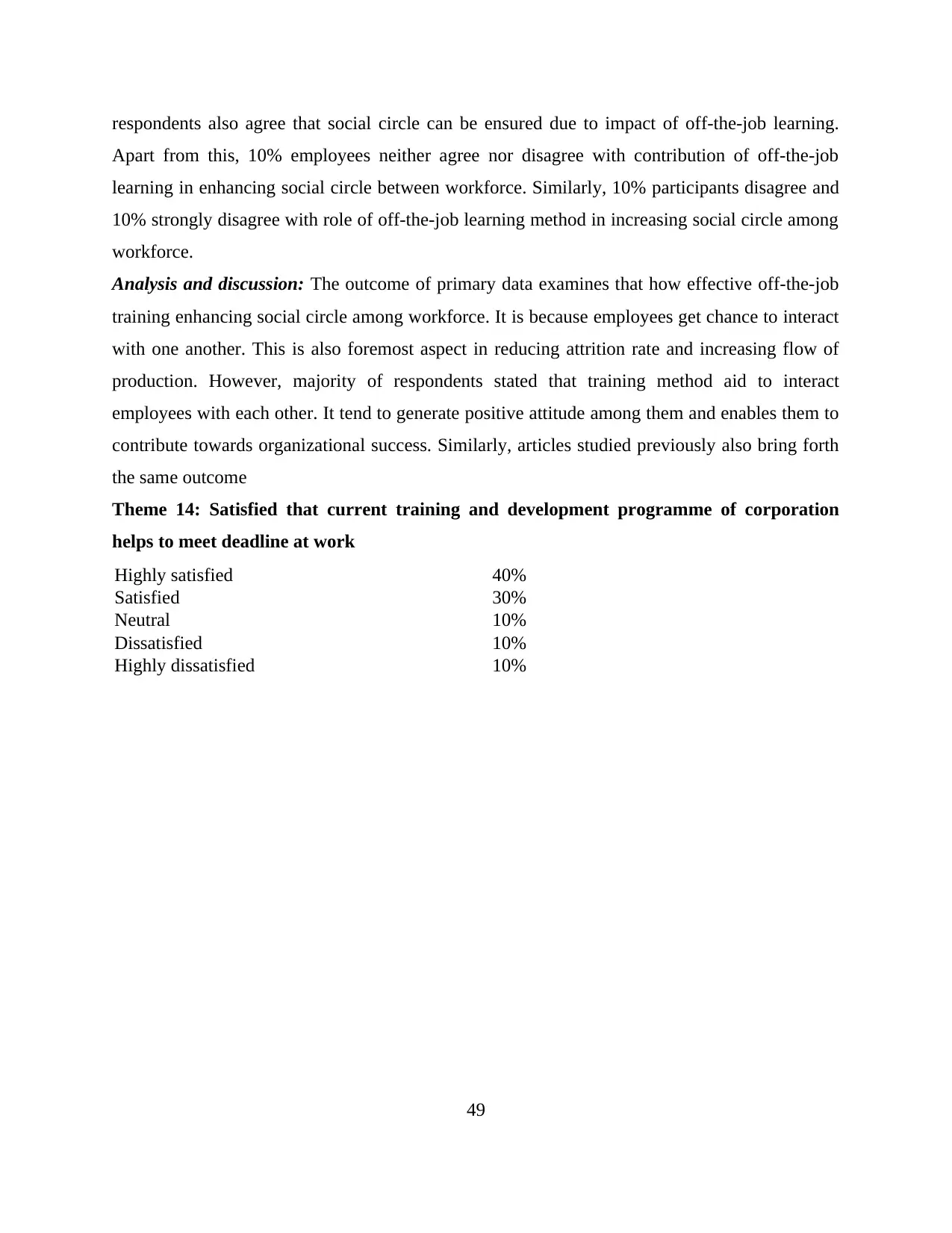
respondents also agree that social circle can be ensured due to impact of off-the-job learning.
Apart from this, 10% employees neither agree nor disagree with contribution of off-the-job
learning in enhancing social circle between workforce. Similarly, 10% participants disagree and
10% strongly disagree with role of off-the-job learning method in increasing social circle among
workforce.
Analysis and discussion: The outcome of primary data examines that how effective off-the-job
training enhancing social circle among workforce. It is because employees get chance to interact
with one another. This is also foremost aspect in reducing attrition rate and increasing flow of
production. However, majority of respondents stated that training method aid to interact
employees with each other. It tend to generate positive attitude among them and enables them to
contribute towards organizational success. Similarly, articles studied previously also bring forth
the same outcome
Theme 14: Satisfied that current training and development programme of corporation
helps to meet deadline at work
Highly satisfied 40%
Satisfied 30%
Neutral 10%
Dissatisfied 10%
Highly dissatisfied 10%
49
Apart from this, 10% employees neither agree nor disagree with contribution of off-the-job
learning in enhancing social circle between workforce. Similarly, 10% participants disagree and
10% strongly disagree with role of off-the-job learning method in increasing social circle among
workforce.
Analysis and discussion: The outcome of primary data examines that how effective off-the-job
training enhancing social circle among workforce. It is because employees get chance to interact
with one another. This is also foremost aspect in reducing attrition rate and increasing flow of
production. However, majority of respondents stated that training method aid to interact
employees with each other. It tend to generate positive attitude among them and enables them to
contribute towards organizational success. Similarly, articles studied previously also bring forth
the same outcome
Theme 14: Satisfied that current training and development programme of corporation
helps to meet deadline at work
Highly satisfied 40%
Satisfied 30%
Neutral 10%
Dissatisfied 10%
Highly dissatisfied 10%
49
Secure Best Marks with AI Grader
Need help grading? Try our AI Grader for instant feedback on your assignments.
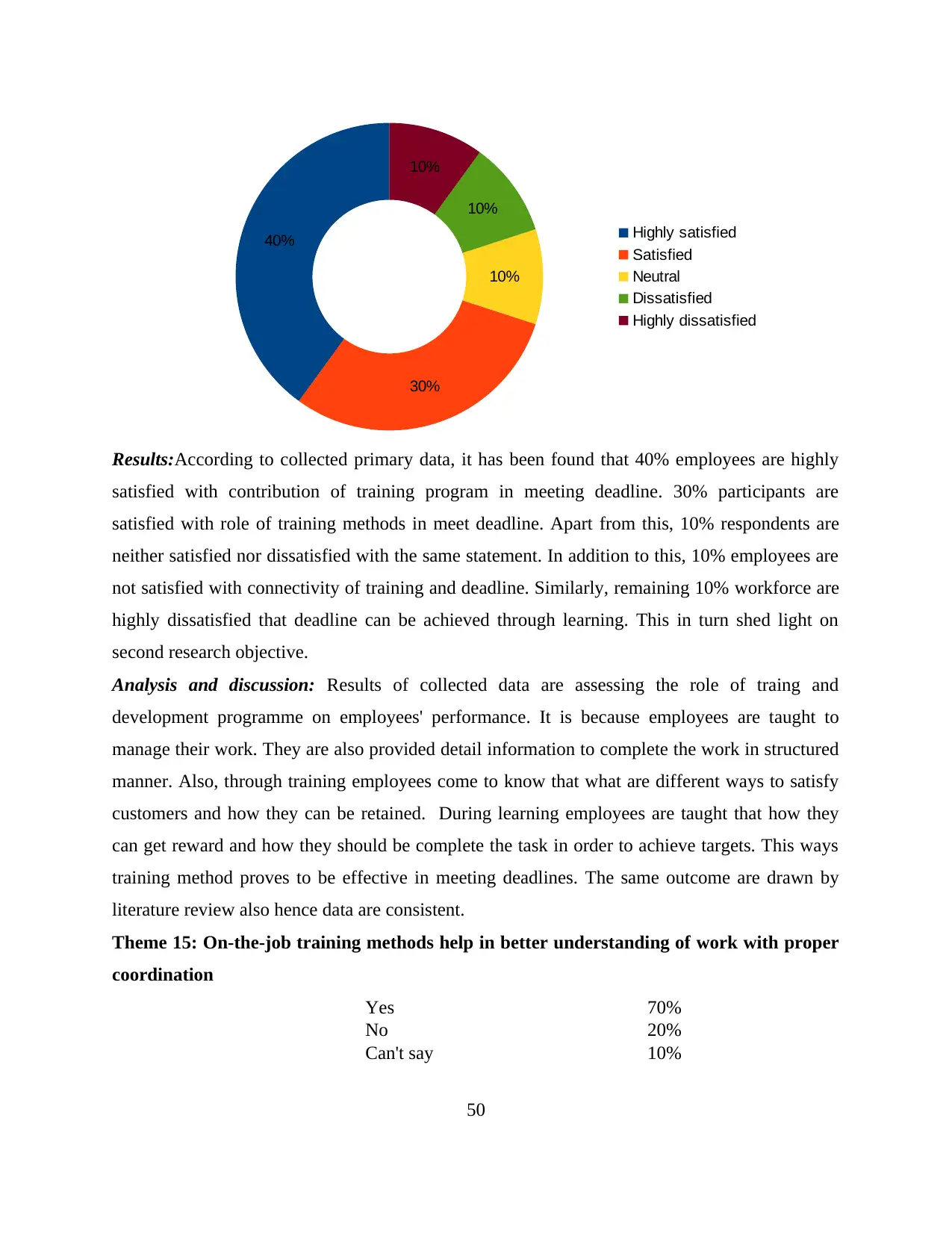
Results:According to collected primary data, it has been found that 40% employees are highly
satisfied with contribution of training program in meeting deadline. 30% participants are
satisfied with role of training methods in meet deadline. Apart from this, 10% respondents are
neither satisfied nor dissatisfied with the same statement. In addition to this, 10% employees are
not satisfied with connectivity of training and deadline. Similarly, remaining 10% workforce are
highly dissatisfied that deadline can be achieved through learning. This in turn shed light on
second research objective.
Analysis and discussion: Results of collected data are assessing the role of traing and
development programme on employees' performance. It is because employees are taught to
manage their work. They are also provided detail information to complete the work in structured
manner. Also, through training employees come to know that what are different ways to satisfy
customers and how they can be retained. During learning employees are taught that how they
can get reward and how they should be complete the task in order to achieve targets. This ways
training method proves to be effective in meeting deadlines. The same outcome are drawn by
literature review also hence data are consistent.
Theme 15: On-the-job training methods help in better understanding of work with proper
coordination
Yes 70%
No 20%
Can't say 10%
50
40%
30%
10%
10%
10%
Highly satisfied
Satisfied
Neutral
Dissatisfied
Highly dissatisfied
satisfied with contribution of training program in meeting deadline. 30% participants are
satisfied with role of training methods in meet deadline. Apart from this, 10% respondents are
neither satisfied nor dissatisfied with the same statement. In addition to this, 10% employees are
not satisfied with connectivity of training and deadline. Similarly, remaining 10% workforce are
highly dissatisfied that deadline can be achieved through learning. This in turn shed light on
second research objective.
Analysis and discussion: Results of collected data are assessing the role of traing and
development programme on employees' performance. It is because employees are taught to
manage their work. They are also provided detail information to complete the work in structured
manner. Also, through training employees come to know that what are different ways to satisfy
customers and how they can be retained. During learning employees are taught that how they
can get reward and how they should be complete the task in order to achieve targets. This ways
training method proves to be effective in meeting deadlines. The same outcome are drawn by
literature review also hence data are consistent.
Theme 15: On-the-job training methods help in better understanding of work with proper
coordination
Yes 70%
No 20%
Can't say 10%
50
40%
30%
10%
10%
10%
Highly satisfied
Satisfied
Neutral
Dissatisfied
Highly dissatisfied
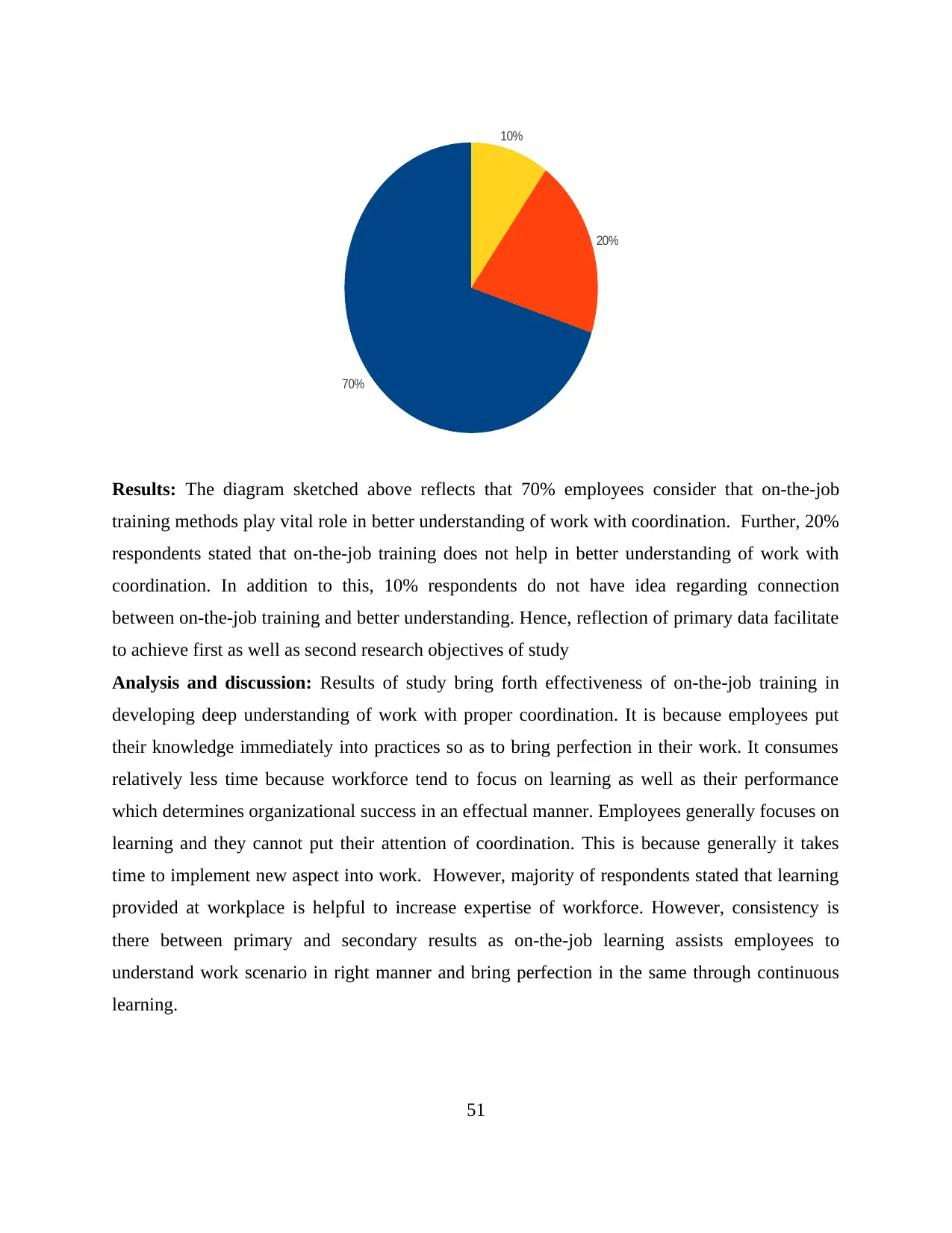
Results: The diagram sketched above reflects that 70% employees consider that on-the-job
training methods play vital role in better understanding of work with coordination. Further, 20%
respondents stated that on-the-job training does not help in better understanding of work with
coordination. In addition to this, 10% respondents do not have idea regarding connection
between on-the-job training and better understanding. Hence, reflection of primary data facilitate
to achieve first as well as second research objectives of study
Analysis and discussion: Results of study bring forth effectiveness of on-the-job training in
developing deep understanding of work with proper coordination. It is because employees put
their knowledge immediately into practices so as to bring perfection in their work. It consumes
relatively less time because workforce tend to focus on learning as well as their performance
which determines organizational success in an effectual manner. Employees generally focuses on
learning and they cannot put their attention of coordination. This is because generally it takes
time to implement new aspect into work. However, majority of respondents stated that learning
provided at workplace is helpful to increase expertise of workforce. However, consistency is
there between primary and secondary results as on-the-job learning assists employees to
understand work scenario in right manner and bring perfection in the same through continuous
learning.
51
70%
20%
10%
training methods play vital role in better understanding of work with coordination. Further, 20%
respondents stated that on-the-job training does not help in better understanding of work with
coordination. In addition to this, 10% respondents do not have idea regarding connection
between on-the-job training and better understanding. Hence, reflection of primary data facilitate
to achieve first as well as second research objectives of study
Analysis and discussion: Results of study bring forth effectiveness of on-the-job training in
developing deep understanding of work with proper coordination. It is because employees put
their knowledge immediately into practices so as to bring perfection in their work. It consumes
relatively less time because workforce tend to focus on learning as well as their performance
which determines organizational success in an effectual manner. Employees generally focuses on
learning and they cannot put their attention of coordination. This is because generally it takes
time to implement new aspect into work. However, majority of respondents stated that learning
provided at workplace is helpful to increase expertise of workforce. However, consistency is
there between primary and secondary results as on-the-job learning assists employees to
understand work scenario in right manner and bring perfection in the same through continuous
learning.
51
70%
20%
10%
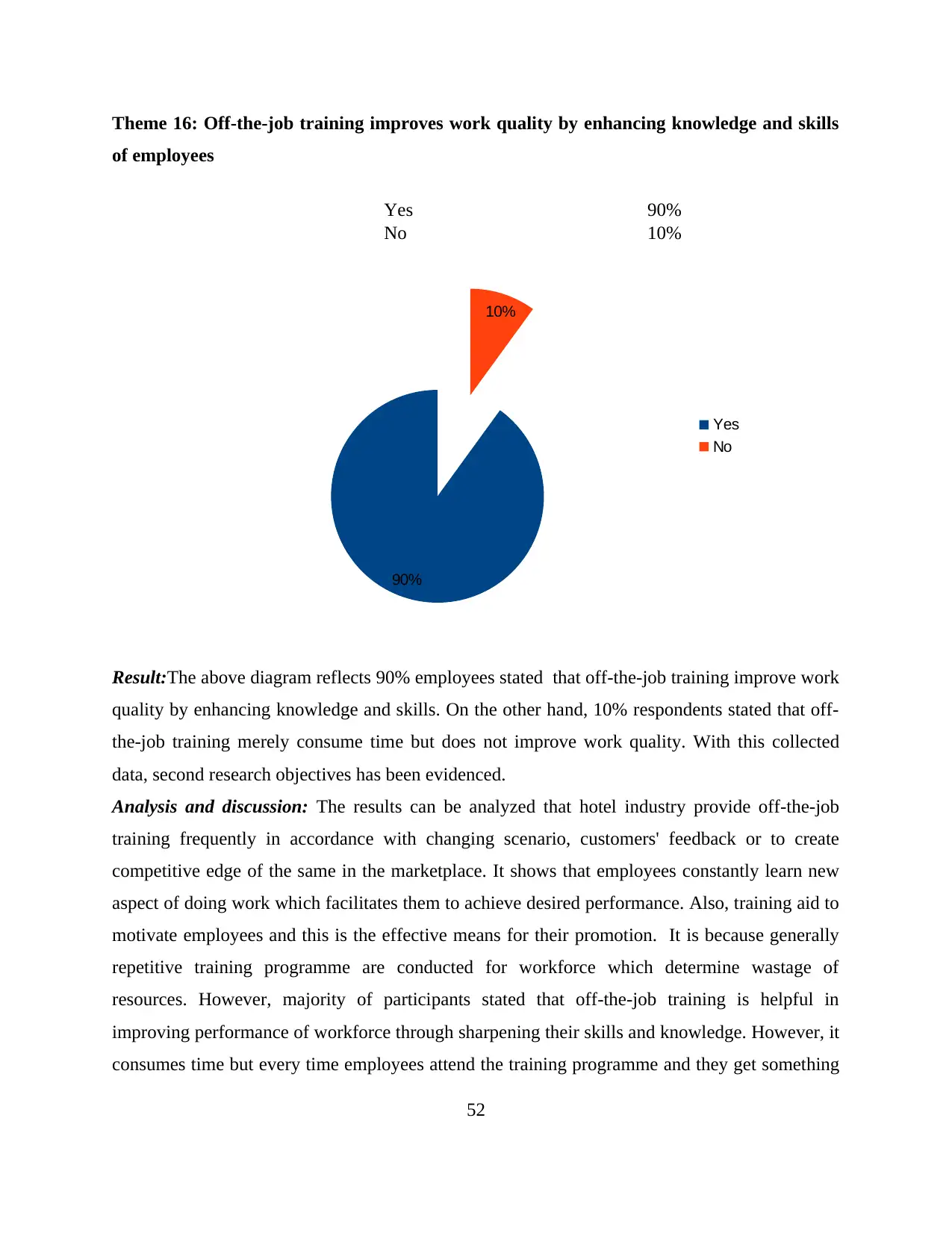
Theme 16: Off-the-job training improves work quality by enhancing knowledge and skills
of employees
Yes 90%
No 10%
Result:The above diagram reflects 90% employees stated that off-the-job training improve work
quality by enhancing knowledge and skills. On the other hand, 10% respondents stated that off-
the-job training merely consume time but does not improve work quality. With this collected
data, second research objectives has been evidenced.
Analysis and discussion: The results can be analyzed that hotel industry provide off-the-job
training frequently in accordance with changing scenario, customers' feedback or to create
competitive edge of the same in the marketplace. It shows that employees constantly learn new
aspect of doing work which facilitates them to achieve desired performance. Also, training aid to
motivate employees and this is the effective means for their promotion. It is because generally
repetitive training programme are conducted for workforce which determine wastage of
resources. However, majority of participants stated that off-the-job training is helpful in
improving performance of workforce through sharpening their skills and knowledge. However, it
consumes time but every time employees attend the training programme and they get something
52
90%
10%
Yes
No
of employees
Yes 90%
No 10%
Result:The above diagram reflects 90% employees stated that off-the-job training improve work
quality by enhancing knowledge and skills. On the other hand, 10% respondents stated that off-
the-job training merely consume time but does not improve work quality. With this collected
data, second research objectives has been evidenced.
Analysis and discussion: The results can be analyzed that hotel industry provide off-the-job
training frequently in accordance with changing scenario, customers' feedback or to create
competitive edge of the same in the marketplace. It shows that employees constantly learn new
aspect of doing work which facilitates them to achieve desired performance. Also, training aid to
motivate employees and this is the effective means for their promotion. It is because generally
repetitive training programme are conducted for workforce which determine wastage of
resources. However, majority of participants stated that off-the-job training is helpful in
improving performance of workforce through sharpening their skills and knowledge. However, it
consumes time but every time employees attend the training programme and they get something
52
90%
10%
Yes
No
Paraphrase This Document
Need a fresh take? Get an instant paraphrase of this document with our AI Paraphraser
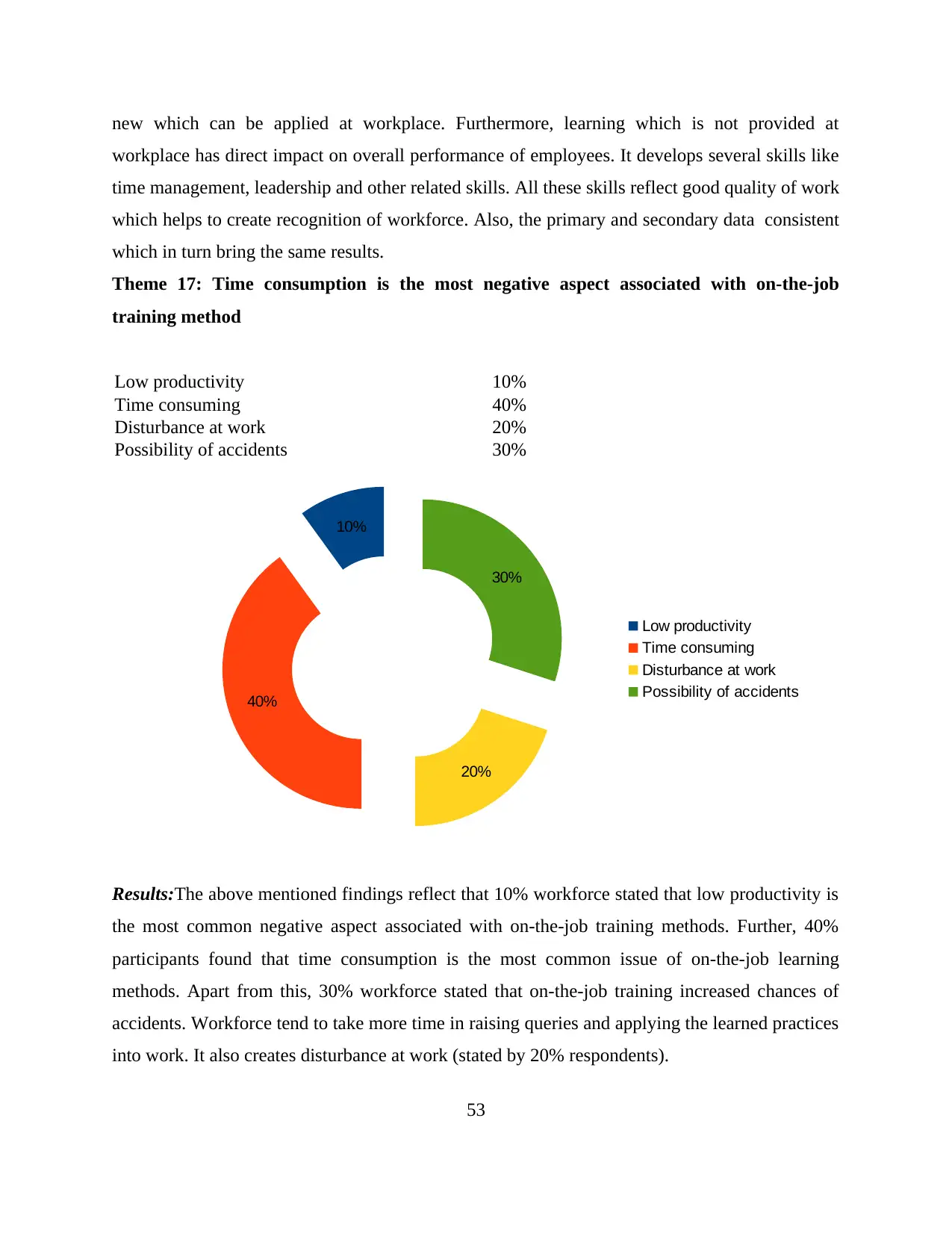
new which can be applied at workplace. Furthermore, learning which is not provided at
workplace has direct impact on overall performance of employees. It develops several skills like
time management, leadership and other related skills. All these skills reflect good quality of work
which helps to create recognition of workforce. Also, the primary and secondary data consistent
which in turn bring the same results.
Theme 17: Time consumption is the most negative aspect associated with on-the-job
training method
Low productivity 10%
Time consuming 40%
Disturbance at work 20%
Possibility of accidents 30%
Results:The above mentioned findings reflect that 10% workforce stated that low productivity is
the most common negative aspect associated with on-the-job training methods. Further, 40%
participants found that time consumption is the most common issue of on-the-job learning
methods. Apart from this, 30% workforce stated that on-the-job training increased chances of
accidents. Workforce tend to take more time in raising queries and applying the learned practices
into work. It also creates disturbance at work (stated by 20% respondents).
53
10%
40%
20%
30%
Low productivity
Time consuming
Disturbance at work
Possibility of accidents
workplace has direct impact on overall performance of employees. It develops several skills like
time management, leadership and other related skills. All these skills reflect good quality of work
which helps to create recognition of workforce. Also, the primary and secondary data consistent
which in turn bring the same results.
Theme 17: Time consumption is the most negative aspect associated with on-the-job
training method
Low productivity 10%
Time consuming 40%
Disturbance at work 20%
Possibility of accidents 30%
Results:The above mentioned findings reflect that 10% workforce stated that low productivity is
the most common negative aspect associated with on-the-job training methods. Further, 40%
participants found that time consumption is the most common issue of on-the-job learning
methods. Apart from this, 30% workforce stated that on-the-job training increased chances of
accidents. Workforce tend to take more time in raising queries and applying the learned practices
into work. It also creates disturbance at work (stated by 20% respondents).
53
10%
40%
20%
30%
Low productivity
Time consuming
Disturbance at work
Possibility of accidents
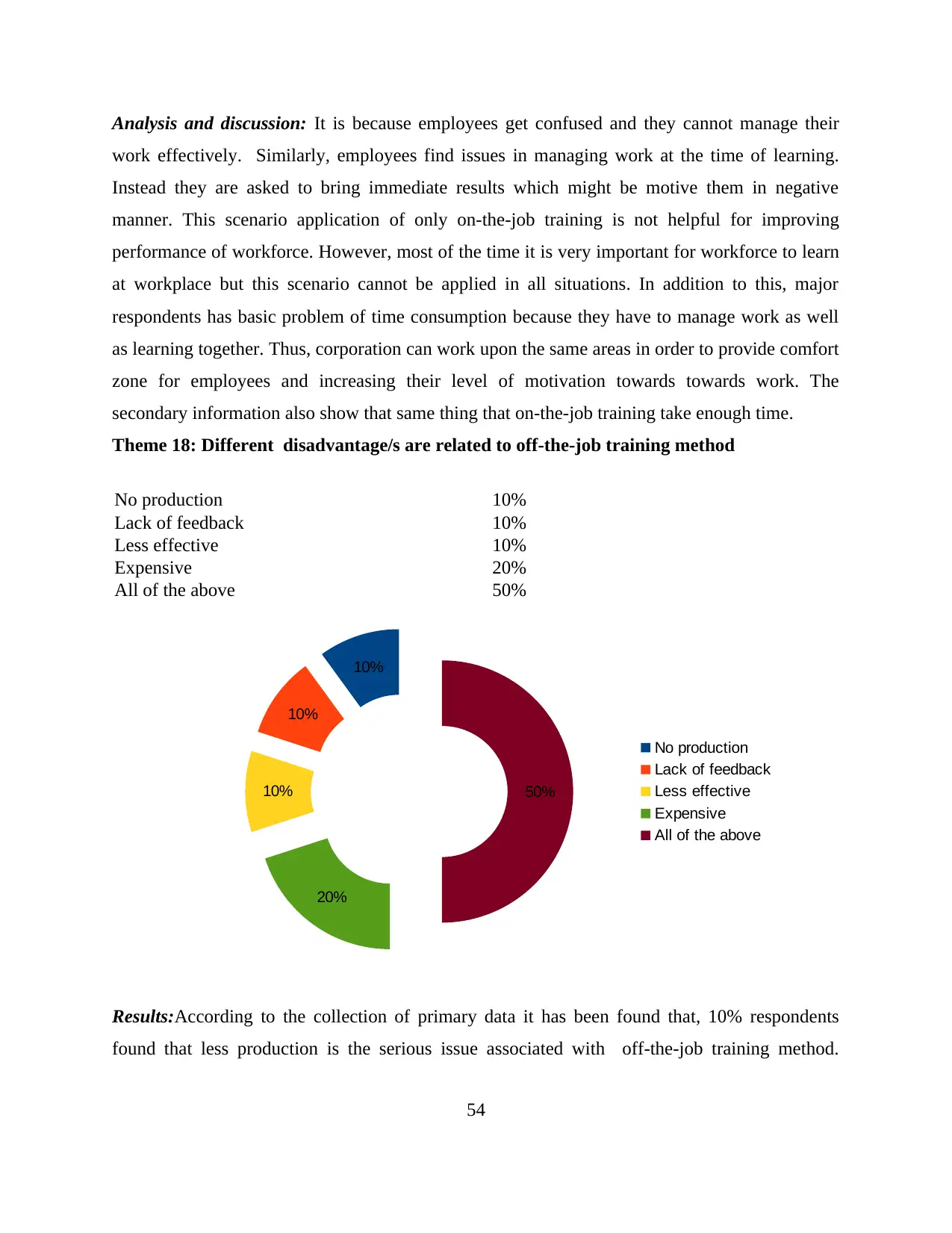
Analysis and discussion: It is because employees get confused and they cannot manage their
work effectively. Similarly, employees find issues in managing work at the time of learning.
Instead they are asked to bring immediate results which might be motive them in negative
manner. This scenario application of only on-the-job training is not helpful for improving
performance of workforce. However, most of the time it is very important for workforce to learn
at workplace but this scenario cannot be applied in all situations. In addition to this, major
respondents has basic problem of time consumption because they have to manage work as well
as learning together. Thus, corporation can work upon the same areas in order to provide comfort
zone for employees and increasing their level of motivation towards towards work. The
secondary information also show that same thing that on-the-job training take enough time.
Theme 18: Different disadvantage/s are related to off-the-job training method
No production 10%
Lack of feedback 10%
Less effective 10%
Expensive 20%
All of the above 50%
Results:According to the collection of primary data it has been found that, 10% respondents
found that less production is the serious issue associated with off-the-job training method.
54
10%
10%
10%
20%
50%
No production
Lack of feedback
Less effective
Expensive
All of the above
work effectively. Similarly, employees find issues in managing work at the time of learning.
Instead they are asked to bring immediate results which might be motive them in negative
manner. This scenario application of only on-the-job training is not helpful for improving
performance of workforce. However, most of the time it is very important for workforce to learn
at workplace but this scenario cannot be applied in all situations. In addition to this, major
respondents has basic problem of time consumption because they have to manage work as well
as learning together. Thus, corporation can work upon the same areas in order to provide comfort
zone for employees and increasing their level of motivation towards towards work. The
secondary information also show that same thing that on-the-job training take enough time.
Theme 18: Different disadvantage/s are related to off-the-job training method
No production 10%
Lack of feedback 10%
Less effective 10%
Expensive 20%
All of the above 50%
Results:According to the collection of primary data it has been found that, 10% respondents
found that less production is the serious issue associated with off-the-job training method.
54
10%
10%
10%
20%
50%
No production
Lack of feedback
Less effective
Expensive
All of the above
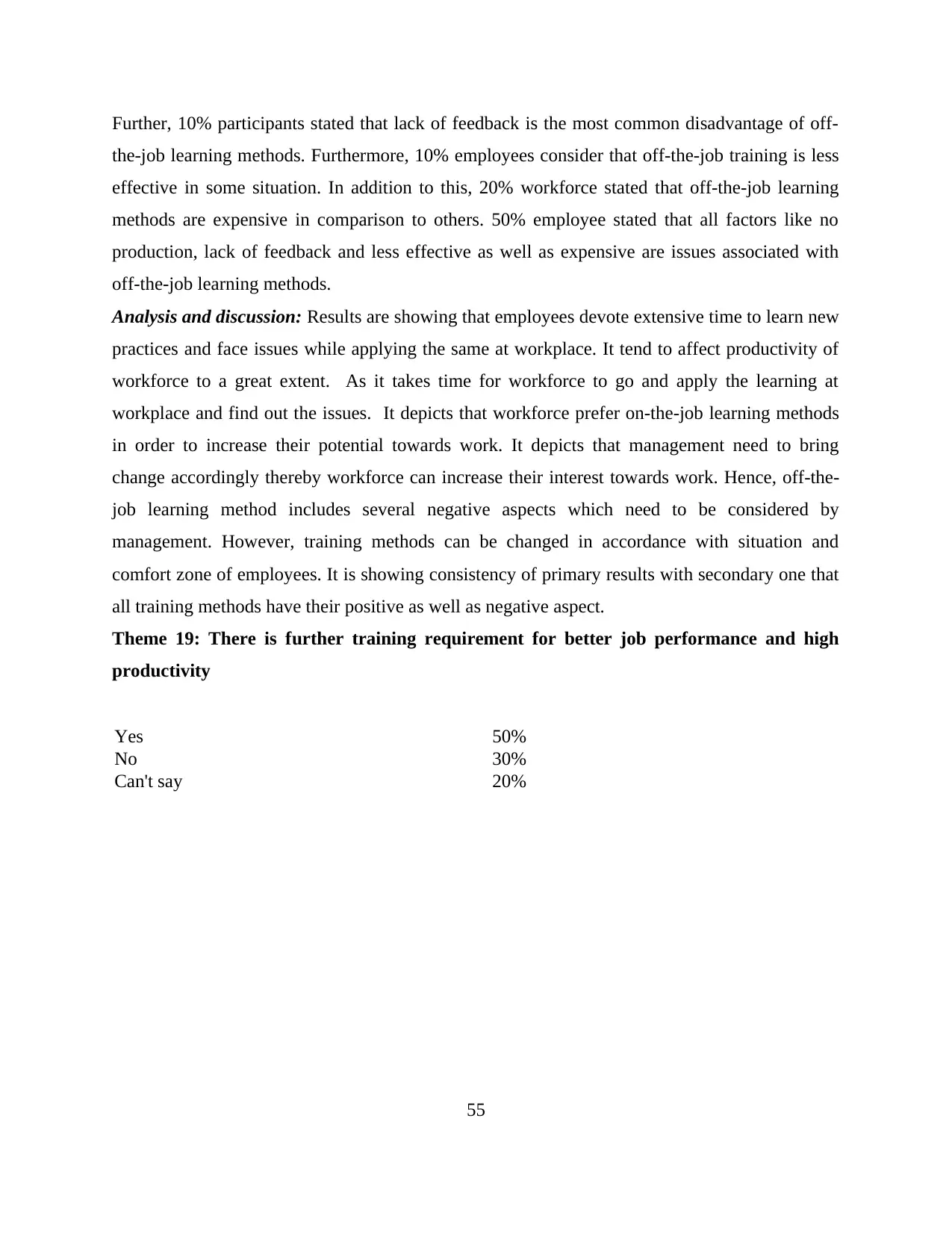
Further, 10% participants stated that lack of feedback is the most common disadvantage of off-
the-job learning methods. Furthermore, 10% employees consider that off-the-job training is less
effective in some situation. In addition to this, 20% workforce stated that off-the-job learning
methods are expensive in comparison to others. 50% employee stated that all factors like no
production, lack of feedback and less effective as well as expensive are issues associated with
off-the-job learning methods.
Analysis and discussion: Results are showing that employees devote extensive time to learn new
practices and face issues while applying the same at workplace. It tend to affect productivity of
workforce to a great extent. As it takes time for workforce to go and apply the learning at
workplace and find out the issues. It depicts that workforce prefer on-the-job learning methods
in order to increase their potential towards work. It depicts that management need to bring
change accordingly thereby workforce can increase their interest towards work. Hence, off-the-
job learning method includes several negative aspects which need to be considered by
management. However, training methods can be changed in accordance with situation and
comfort zone of employees. It is showing consistency of primary results with secondary one that
all training methods have their positive as well as negative aspect.
Theme 19: There is further training requirement for better job performance and high
productivity
Yes 50%
No 30%
Can't say 20%
55
the-job learning methods. Furthermore, 10% employees consider that off-the-job training is less
effective in some situation. In addition to this, 20% workforce stated that off-the-job learning
methods are expensive in comparison to others. 50% employee stated that all factors like no
production, lack of feedback and less effective as well as expensive are issues associated with
off-the-job learning methods.
Analysis and discussion: Results are showing that employees devote extensive time to learn new
practices and face issues while applying the same at workplace. It tend to affect productivity of
workforce to a great extent. As it takes time for workforce to go and apply the learning at
workplace and find out the issues. It depicts that workforce prefer on-the-job learning methods
in order to increase their potential towards work. It depicts that management need to bring
change accordingly thereby workforce can increase their interest towards work. Hence, off-the-
job learning method includes several negative aspects which need to be considered by
management. However, training methods can be changed in accordance with situation and
comfort zone of employees. It is showing consistency of primary results with secondary one that
all training methods have their positive as well as negative aspect.
Theme 19: There is further training requirement for better job performance and high
productivity
Yes 50%
No 30%
Can't say 20%
55
Secure Best Marks with AI Grader
Need help grading? Try our AI Grader for instant feedback on your assignments.

Results: The collected primary data reveals that 50% respondents have further requirement of
training in order to ensure their better performance and job productivity. Furthermore, 30%
participants do not require training for better job performance and high productivity. In addition
to this, remaining 20% workforce do not have any idea regarding further training requirement.
Analysis and discussion: The results depicts that employees are motivating towards learning
new aspect of doing work. It assists them to work with integration and deliver good quality of
services to large number buyers in accordance with their experience. Thus, results are showing
that employees need training on right so as to enhance their overall potential in order to perform
good at workplace. Furthermore, aforementioned results show that employees perform good only
after learning new aspect so as to manage work in an effectual manner.
56
50%
30%
20%
Yes
No
Can't say
training in order to ensure their better performance and job productivity. Furthermore, 30%
participants do not require training for better job performance and high productivity. In addition
to this, remaining 20% workforce do not have any idea regarding further training requirement.
Analysis and discussion: The results depicts that employees are motivating towards learning
new aspect of doing work. It assists them to work with integration and deliver good quality of
services to large number buyers in accordance with their experience. Thus, results are showing
that employees need training on right so as to enhance their overall potential in order to perform
good at workplace. Furthermore, aforementioned results show that employees perform good only
after learning new aspect so as to manage work in an effectual manner.
56
50%
30%
20%
Yes
No
Can't say

CHAPTER 5: CONCLUSION AND RECOMMEDATIONS
5.1 Conclusion
At the completion of entire research, conclusion is drawn in the light of findings of the
study. It facilitates researcher to provide valid recommendations for selected industry so that
potential issues can be resolved effectively. Thus, conclusion is drawn in accordance with
research objectives-
Objectives 1: To analyze different training methods used in hotel industry of UK
The analysis chapter shed light on different training methods used by hotel industry. It
depicts that on-the-job and off-the-job training methods are applied by hotels in order to increase
expertise of workforce. Here, lectures, conferences and computer based training are provided in
the form of off-the-job training. It supports workforce to manage their task effectively. However,
such kind of training method consume relative extensive time. It is because at first employees are
provided training by arranging necessary resources and then they are put at workplace to
implement the learned aspect. This becomes long process which tend to increase cost of
production and create barriers in meeting deadline. However, on-the-job learning methods are
fruitful for experienced workforce in some circumstances. This aspects resolve their issues at
workplace and enables them to focus on their work in an effectual manner.
Further, mentorship and job rotation are form of on-the-job training. Here, mentorship is
effective means for learning for those who work under their supervisor. The knowledge and
skills of such kind of employees keep on updating under supervision. It is because during that
period they are told regarding their mistakes and right ways of doing work is also taught to them.
It proves to be effective for company as well as employees. It is because on-the-job training
provide learning along with work so employees can have improvement in their personalities as
well. It can be done by sharpening time management skills, meeting deadlines and bringing
perfection in work.
Objective 2: To assess the effectiveness of on the job and off the job training method on
performance of employee in hotel industry of UK
After evaluating and analyzing primary and secondary data, it can be said that both
training methods are helpful for employees. It is because these two training methods have their
importance in organization. For instance, new employees can be provided off-the-job training
57
5.1 Conclusion
At the completion of entire research, conclusion is drawn in the light of findings of the
study. It facilitates researcher to provide valid recommendations for selected industry so that
potential issues can be resolved effectively. Thus, conclusion is drawn in accordance with
research objectives-
Objectives 1: To analyze different training methods used in hotel industry of UK
The analysis chapter shed light on different training methods used by hotel industry. It
depicts that on-the-job and off-the-job training methods are applied by hotels in order to increase
expertise of workforce. Here, lectures, conferences and computer based training are provided in
the form of off-the-job training. It supports workforce to manage their task effectively. However,
such kind of training method consume relative extensive time. It is because at first employees are
provided training by arranging necessary resources and then they are put at workplace to
implement the learned aspect. This becomes long process which tend to increase cost of
production and create barriers in meeting deadline. However, on-the-job learning methods are
fruitful for experienced workforce in some circumstances. This aspects resolve their issues at
workplace and enables them to focus on their work in an effectual manner.
Further, mentorship and job rotation are form of on-the-job training. Here, mentorship is
effective means for learning for those who work under their supervisor. The knowledge and
skills of such kind of employees keep on updating under supervision. It is because during that
period they are told regarding their mistakes and right ways of doing work is also taught to them.
It proves to be effective for company as well as employees. It is because on-the-job training
provide learning along with work so employees can have improvement in their personalities as
well. It can be done by sharpening time management skills, meeting deadlines and bringing
perfection in work.
Objective 2: To assess the effectiveness of on the job and off the job training method on
performance of employee in hotel industry of UK
After evaluating and analyzing primary and secondary data, it can be said that both
training methods are helpful for employees. It is because these two training methods have their
importance in organization. For instance, new employees can be provided off-the-job training
57
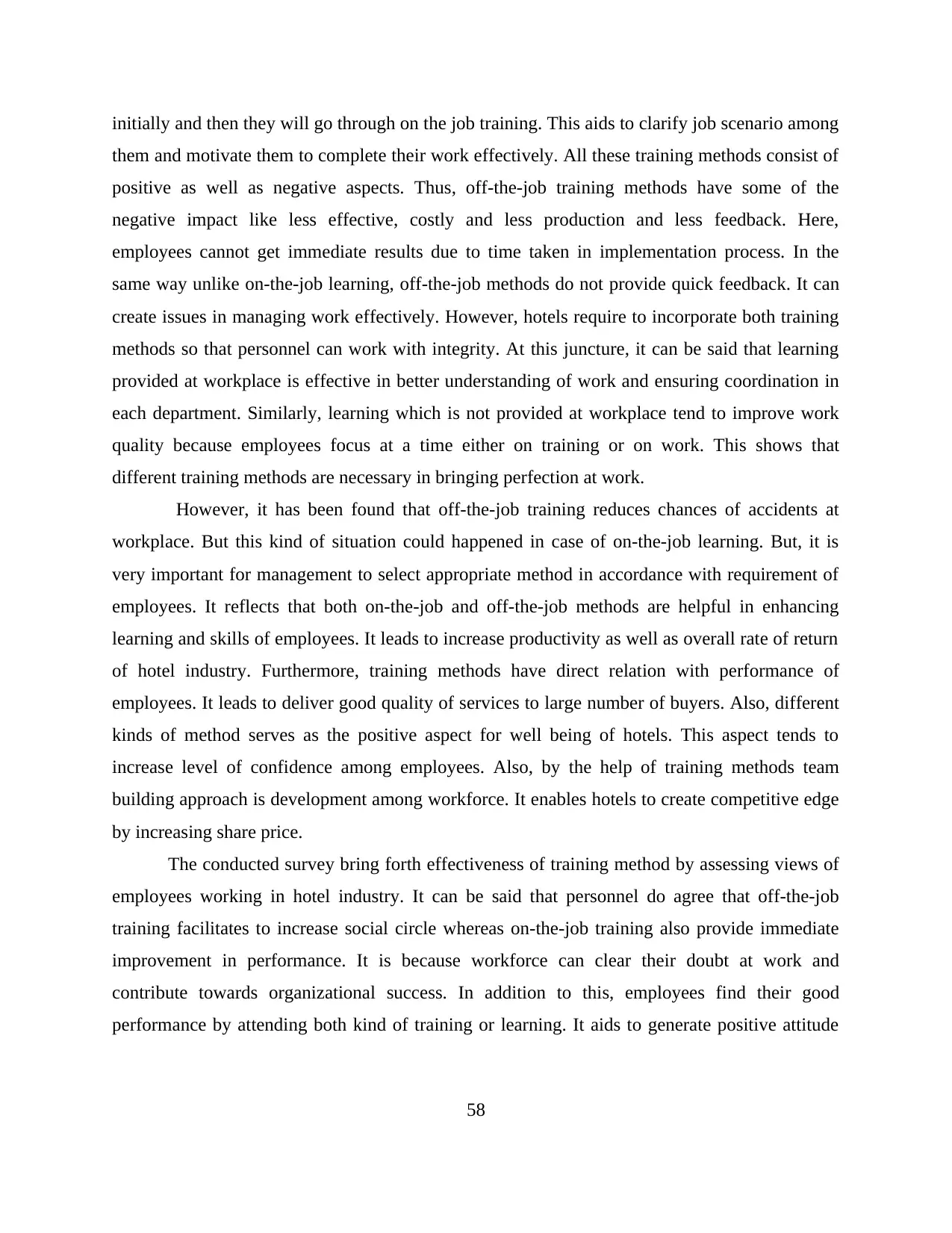
initially and then they will go through on the job training. This aids to clarify job scenario among
them and motivate them to complete their work effectively. All these training methods consist of
positive as well as negative aspects. Thus, off-the-job training methods have some of the
negative impact like less effective, costly and less production and less feedback. Here,
employees cannot get immediate results due to time taken in implementation process. In the
same way unlike on-the-job learning, off-the-job methods do not provide quick feedback. It can
create issues in managing work effectively. However, hotels require to incorporate both training
methods so that personnel can work with integrity. At this juncture, it can be said that learning
provided at workplace is effective in better understanding of work and ensuring coordination in
each department. Similarly, learning which is not provided at workplace tend to improve work
quality because employees focus at a time either on training or on work. This shows that
different training methods are necessary in bringing perfection at work.
However, it has been found that off-the-job training reduces chances of accidents at
workplace. But this kind of situation could happened in case of on-the-job learning. But, it is
very important for management to select appropriate method in accordance with requirement of
employees. It reflects that both on-the-job and off-the-job methods are helpful in enhancing
learning and skills of employees. It leads to increase productivity as well as overall rate of return
of hotel industry. Furthermore, training methods have direct relation with performance of
employees. It leads to deliver good quality of services to large number of buyers. Also, different
kinds of method serves as the positive aspect for well being of hotels. This aspect tends to
increase level of confidence among employees. Also, by the help of training methods team
building approach is development among workforce. It enables hotels to create competitive edge
by increasing share price.
The conducted survey bring forth effectiveness of training method by assessing views of
employees working in hotel industry. It can be said that personnel do agree that off-the-job
training facilitates to increase social circle whereas on-the-job training also provide immediate
improvement in performance. It is because workforce can clear their doubt at work and
contribute towards organizational success. In addition to this, employees find their good
performance by attending both kind of training or learning. It aids to generate positive attitude
58
them and motivate them to complete their work effectively. All these training methods consist of
positive as well as negative aspects. Thus, off-the-job training methods have some of the
negative impact like less effective, costly and less production and less feedback. Here,
employees cannot get immediate results due to time taken in implementation process. In the
same way unlike on-the-job learning, off-the-job methods do not provide quick feedback. It can
create issues in managing work effectively. However, hotels require to incorporate both training
methods so that personnel can work with integrity. At this juncture, it can be said that learning
provided at workplace is effective in better understanding of work and ensuring coordination in
each department. Similarly, learning which is not provided at workplace tend to improve work
quality because employees focus at a time either on training or on work. This shows that
different training methods are necessary in bringing perfection at work.
However, it has been found that off-the-job training reduces chances of accidents at
workplace. But this kind of situation could happened in case of on-the-job learning. But, it is
very important for management to select appropriate method in accordance with requirement of
employees. It reflects that both on-the-job and off-the-job methods are helpful in enhancing
learning and skills of employees. It leads to increase productivity as well as overall rate of return
of hotel industry. Furthermore, training methods have direct relation with performance of
employees. It leads to deliver good quality of services to large number of buyers. Also, different
kinds of method serves as the positive aspect for well being of hotels. This aspect tends to
increase level of confidence among employees. Also, by the help of training methods team
building approach is development among workforce. It enables hotels to create competitive edge
by increasing share price.
The conducted survey bring forth effectiveness of training method by assessing views of
employees working in hotel industry. It can be said that personnel do agree that off-the-job
training facilitates to increase social circle whereas on-the-job training also provide immediate
improvement in performance. It is because workforce can clear their doubt at work and
contribute towards organizational success. In addition to this, employees find their good
performance by attending both kind of training or learning. It aids to generate positive attitude
58
Paraphrase This Document
Need a fresh take? Get an instant paraphrase of this document with our AI Paraphraser
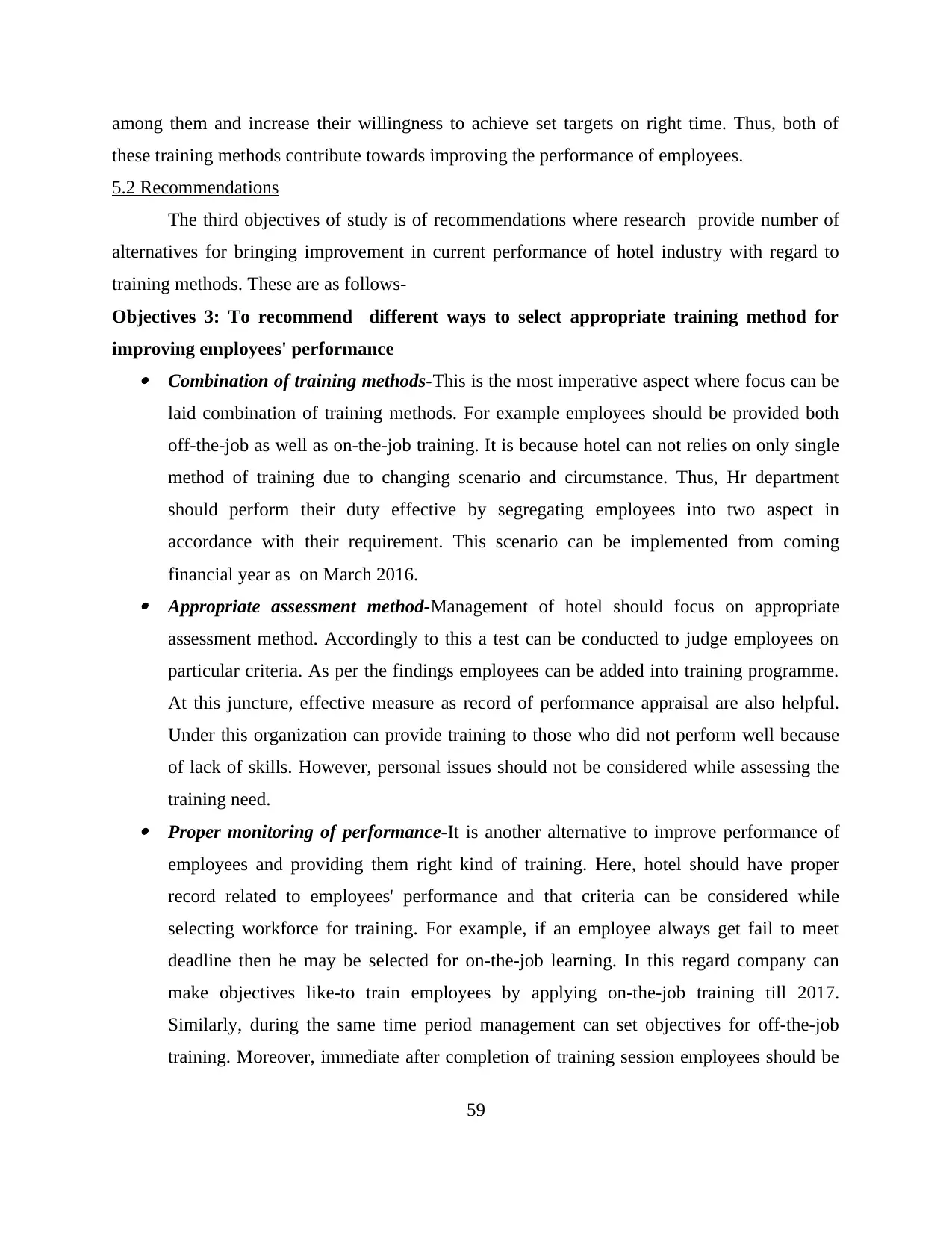
among them and increase their willingness to achieve set targets on right time. Thus, both of
these training methods contribute towards improving the performance of employees.
5.2 Recommendations
The third objectives of study is of recommendations where research provide number of
alternatives for bringing improvement in current performance of hotel industry with regard to
training methods. These are as follows-
Objectives 3: To recommend different ways to select appropriate training method for
improving employees' performance Combination of training methods-This is the most imperative aspect where focus can be
laid combination of training methods. For example employees should be provided both
off-the-job as well as on-the-job training. It is because hotel can not relies on only single
method of training due to changing scenario and circumstance. Thus, Hr department
should perform their duty effective by segregating employees into two aspect in
accordance with their requirement. This scenario can be implemented from coming
financial year as on March 2016. Appropriate assessment method-Management of hotel should focus on appropriate
assessment method. Accordingly to this a test can be conducted to judge employees on
particular criteria. As per the findings employees can be added into training programme.
At this juncture, effective measure as record of performance appraisal are also helpful.
Under this organization can provide training to those who did not perform well because
of lack of skills. However, personal issues should not be considered while assessing the
training need. Proper monitoring of performance-It is another alternative to improve performance of
employees and providing them right kind of training. Here, hotel should have proper
record related to employees' performance and that criteria can be considered while
selecting workforce for training. For example, if an employee always get fail to meet
deadline then he may be selected for on-the-job learning. In this regard company can
make objectives like-to train employees by applying on-the-job training till 2017.
Similarly, during the same time period management can set objectives for off-the-job
training. Moreover, immediate after completion of training session employees should be
59
these training methods contribute towards improving the performance of employees.
5.2 Recommendations
The third objectives of study is of recommendations where research provide number of
alternatives for bringing improvement in current performance of hotel industry with regard to
training methods. These are as follows-
Objectives 3: To recommend different ways to select appropriate training method for
improving employees' performance Combination of training methods-This is the most imperative aspect where focus can be
laid combination of training methods. For example employees should be provided both
off-the-job as well as on-the-job training. It is because hotel can not relies on only single
method of training due to changing scenario and circumstance. Thus, Hr department
should perform their duty effective by segregating employees into two aspect in
accordance with their requirement. This scenario can be implemented from coming
financial year as on March 2016. Appropriate assessment method-Management of hotel should focus on appropriate
assessment method. Accordingly to this a test can be conducted to judge employees on
particular criteria. As per the findings employees can be added into training programme.
At this juncture, effective measure as record of performance appraisal are also helpful.
Under this organization can provide training to those who did not perform well because
of lack of skills. However, personal issues should not be considered while assessing the
training need. Proper monitoring of performance-It is another alternative to improve performance of
employees and providing them right kind of training. Here, hotel should have proper
record related to employees' performance and that criteria can be considered while
selecting workforce for training. For example, if an employee always get fail to meet
deadline then he may be selected for on-the-job learning. In this regard company can
make objectives like-to train employees by applying on-the-job training till 2017.
Similarly, during the same time period management can set objectives for off-the-job
training. Moreover, immediate after completion of training session employees should be
59
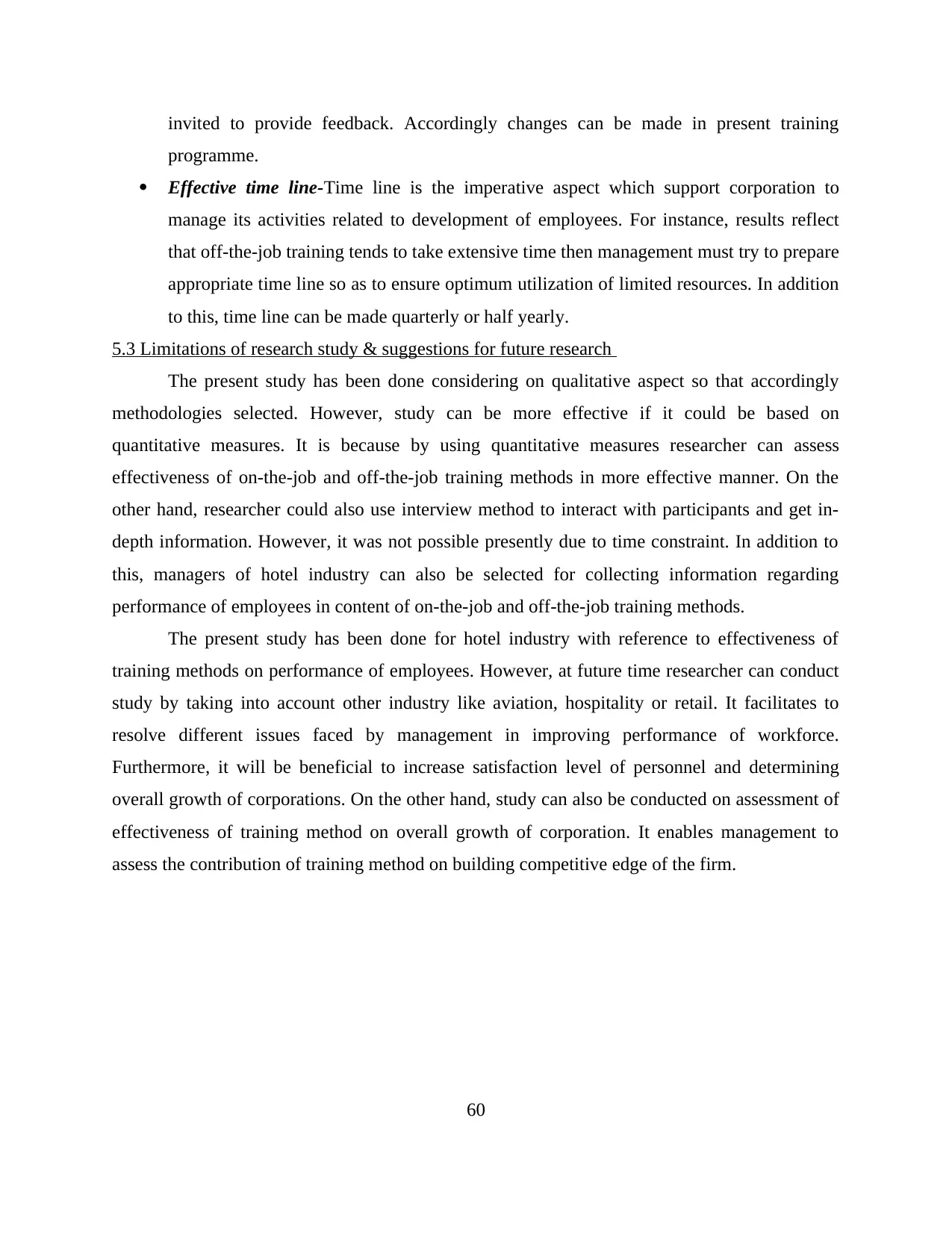
invited to provide feedback. Accordingly changes can be made in present training
programme.
Effective time line-Time line is the imperative aspect which support corporation to
manage its activities related to development of employees. For instance, results reflect
that off-the-job training tends to take extensive time then management must try to prepare
appropriate time line so as to ensure optimum utilization of limited resources. In addition
to this, time line can be made quarterly or half yearly.
5.3 Limitations of research study & suggestions for future research
The present study has been done considering on qualitative aspect so that accordingly
methodologies selected. However, study can be more effective if it could be based on
quantitative measures. It is because by using quantitative measures researcher can assess
effectiveness of on-the-job and off-the-job training methods in more effective manner. On the
other hand, researcher could also use interview method to interact with participants and get in-
depth information. However, it was not possible presently due to time constraint. In addition to
this, managers of hotel industry can also be selected for collecting information regarding
performance of employees in content of on-the-job and off-the-job training methods.
The present study has been done for hotel industry with reference to effectiveness of
training methods on performance of employees. However, at future time researcher can conduct
study by taking into account other industry like aviation, hospitality or retail. It facilitates to
resolve different issues faced by management in improving performance of workforce.
Furthermore, it will be beneficial to increase satisfaction level of personnel and determining
overall growth of corporations. On the other hand, study can also be conducted on assessment of
effectiveness of training method on overall growth of corporation. It enables management to
assess the contribution of training method on building competitive edge of the firm.
60
programme.
Effective time line-Time line is the imperative aspect which support corporation to
manage its activities related to development of employees. For instance, results reflect
that off-the-job training tends to take extensive time then management must try to prepare
appropriate time line so as to ensure optimum utilization of limited resources. In addition
to this, time line can be made quarterly or half yearly.
5.3 Limitations of research study & suggestions for future research
The present study has been done considering on qualitative aspect so that accordingly
methodologies selected. However, study can be more effective if it could be based on
quantitative measures. It is because by using quantitative measures researcher can assess
effectiveness of on-the-job and off-the-job training methods in more effective manner. On the
other hand, researcher could also use interview method to interact with participants and get in-
depth information. However, it was not possible presently due to time constraint. In addition to
this, managers of hotel industry can also be selected for collecting information regarding
performance of employees in content of on-the-job and off-the-job training methods.
The present study has been done for hotel industry with reference to effectiveness of
training methods on performance of employees. However, at future time researcher can conduct
study by taking into account other industry like aviation, hospitality or retail. It facilitates to
resolve different issues faced by management in improving performance of workforce.
Furthermore, it will be beneficial to increase satisfaction level of personnel and determining
overall growth of corporations. On the other hand, study can also be conducted on assessment of
effectiveness of training method on overall growth of corporation. It enables management to
assess the contribution of training method on building competitive edge of the firm.
60
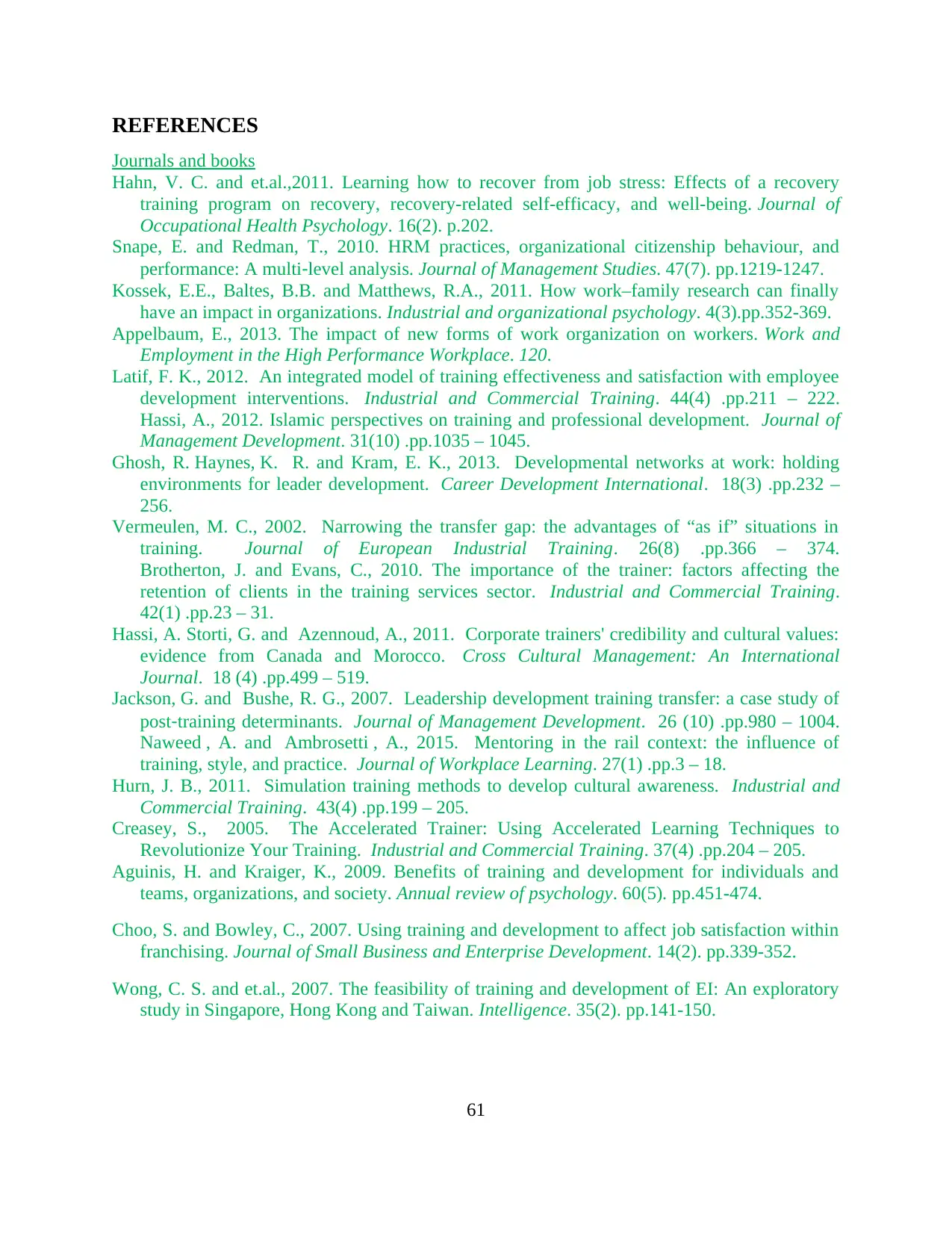
REFERENCES
Journals and books
Hahn, V. C. and et.al.,2011. Learning how to recover from job stress: Effects of a recovery
training program on recovery, recovery-related self-efficacy, and well-being. Journal of
Occupational Health Psychology. 16(2). p.202.
Snape, E. and Redman, T., 2010. HRM practices, organizational citizenship behaviour, and
performance: A multi‐level analysis. Journal of Management Studies. 47(7). pp.1219-1247.
Kossek, E.E., Baltes, B.B. and Matthews, R.A., 2011. How work–family research can finally
have an impact in organizations. Industrial and organizational psychology. 4(3).pp.352-369.
Appelbaum, E., 2013. The impact of new forms of work organization on workers. Work and
Employment in the High Performance Workplace. 120.
Latif, F. K., 2012. An integrated model of training effectiveness and satisfaction with employee
development interventions. Industrial and Commercial Training. 44(4) .pp.211 – 222.
Hassi, A., 2012. Islamic perspectives on training and professional development. Journal of
Management Development. 31(10) .pp.1035 – 1045.
Ghosh, R. Haynes, K. R. and Kram, E. K., 2013. Developmental networks at work: holding
environments for leader development. Career Development International. 18(3) .pp.232 –
256.
Vermeulen, M. C., 2002. Narrowing the transfer gap: the advantages of “as if” situations in
training. Journal of European Industrial Training. 26(8) .pp.366 – 374.
Brotherton, J. and Evans, C., 2010. The importance of the trainer: factors affecting the
retention of clients in the training services sector. Industrial and Commercial Training.
42(1) .pp.23 – 31.
Hassi, A. Storti, G. and Azennoud, A., 2011. Corporate trainers' credibility and cultural values:
evidence from Canada and Morocco. Cross Cultural Management: An International
Journal. 18 (4) .pp.499 – 519.
Jackson, G. and Bushe, R. G., 2007. Leadership development training transfer: a case study of
post‐training determinants. Journal of Management Development. 26 (10) .pp.980 – 1004.
Naweed , A. and Ambrosetti , A., 2015. Mentoring in the rail context: the influence of
training, style, and practice. Journal of Workplace Learning. 27(1) .pp.3 – 18.
Hurn, J. B., 2011. Simulation training methods to develop cultural awareness. Industrial and
Commercial Training. 43(4) .pp.199 – 205.
Creasey, S., 2005. The Accelerated Trainer: Using Accelerated Learning Techniques to
Revolutionize Your Training. Industrial and Commercial Training. 37(4) .pp.204 – 205.
Aguinis, H. and Kraiger, K., 2009. Benefits of training and development for individuals and
teams, organizations, and society. Annual review of psychology. 60(5). pp.451-474.
Choo, S. and Bowley, C., 2007. Using training and development to affect job satisfaction within
franchising. Journal of Small Business and Enterprise Development. 14(2). pp.339-352.
Wong, C. S. and et.al., 2007. The feasibility of training and development of EI: An exploratory
study in Singapore, Hong Kong and Taiwan. Intelligence. 35(2). pp.141-150.
61
Journals and books
Hahn, V. C. and et.al.,2011. Learning how to recover from job stress: Effects of a recovery
training program on recovery, recovery-related self-efficacy, and well-being. Journal of
Occupational Health Psychology. 16(2). p.202.
Snape, E. and Redman, T., 2010. HRM practices, organizational citizenship behaviour, and
performance: A multi‐level analysis. Journal of Management Studies. 47(7). pp.1219-1247.
Kossek, E.E., Baltes, B.B. and Matthews, R.A., 2011. How work–family research can finally
have an impact in organizations. Industrial and organizational psychology. 4(3).pp.352-369.
Appelbaum, E., 2013. The impact of new forms of work organization on workers. Work and
Employment in the High Performance Workplace. 120.
Latif, F. K., 2012. An integrated model of training effectiveness and satisfaction with employee
development interventions. Industrial and Commercial Training. 44(4) .pp.211 – 222.
Hassi, A., 2012. Islamic perspectives on training and professional development. Journal of
Management Development. 31(10) .pp.1035 – 1045.
Ghosh, R. Haynes, K. R. and Kram, E. K., 2013. Developmental networks at work: holding
environments for leader development. Career Development International. 18(3) .pp.232 –
256.
Vermeulen, M. C., 2002. Narrowing the transfer gap: the advantages of “as if” situations in
training. Journal of European Industrial Training. 26(8) .pp.366 – 374.
Brotherton, J. and Evans, C., 2010. The importance of the trainer: factors affecting the
retention of clients in the training services sector. Industrial and Commercial Training.
42(1) .pp.23 – 31.
Hassi, A. Storti, G. and Azennoud, A., 2011. Corporate trainers' credibility and cultural values:
evidence from Canada and Morocco. Cross Cultural Management: An International
Journal. 18 (4) .pp.499 – 519.
Jackson, G. and Bushe, R. G., 2007. Leadership development training transfer: a case study of
post‐training determinants. Journal of Management Development. 26 (10) .pp.980 – 1004.
Naweed , A. and Ambrosetti , A., 2015. Mentoring in the rail context: the influence of
training, style, and practice. Journal of Workplace Learning. 27(1) .pp.3 – 18.
Hurn, J. B., 2011. Simulation training methods to develop cultural awareness. Industrial and
Commercial Training. 43(4) .pp.199 – 205.
Creasey, S., 2005. The Accelerated Trainer: Using Accelerated Learning Techniques to
Revolutionize Your Training. Industrial and Commercial Training. 37(4) .pp.204 – 205.
Aguinis, H. and Kraiger, K., 2009. Benefits of training and development for individuals and
teams, organizations, and society. Annual review of psychology. 60(5). pp.451-474.
Choo, S. and Bowley, C., 2007. Using training and development to affect job satisfaction within
franchising. Journal of Small Business and Enterprise Development. 14(2). pp.339-352.
Wong, C. S. and et.al., 2007. The feasibility of training and development of EI: An exploratory
study in Singapore, Hong Kong and Taiwan. Intelligence. 35(2). pp.141-150.
61
Secure Best Marks with AI Grader
Need help grading? Try our AI Grader for instant feedback on your assignments.

Grohmann, A. and Kauffeld, S., 2013. Evaluating training programs: development and correlates
of the questionnaire for professional training evaluation. International Journal of Training
and Development. 17(2). pp.135-155.
Rooney, M.P., 2010. The current state of middle management preparation, training, and
development in academic libraries. The Journal of Academic Librarianship. 36(5). pp.383-
393.
Thang, N. N. and Quang, T., 2007. International briefing 18: Training and development in
Vietnam. International journal of training and development. 11(2). pp.139-149.
Anis, A., Nasir, A. and Safwan, N., 2011. Employee retention relationship to training and
development: A compensation perspective. African journal of business management. 5(7).
p.2679.
McGrath, S., 2012. Building new approaches to thinking about vocational education and training
and development: Policy, theory and evidence. International Journal of Educational
Development. 32(5). pp.619-622.
Frazis, H. and Loewenstein, M. A., 2007. On-the-job training. Now Publishers Inc.
Cuesta, M.B. and Salverda, W., 2009. Low‐wage Employment and the Role of Education and
On‐the‐job Training. Labour. 23(1). pp.5-35.
Green, F. and Langdon, K., 2004. Managing Training and Development Finance: Training and
Development 11.10. John Wiley & Sons.
Pulparampil, J., 2014. Training and Development: An Experience Based Approach. Partridge
Publishing.
Noe, R. A., 2010. Employee training and development. McGraw-Hill/Irwin.
Olaniyan, D. A. and Ojo, L. B., 2008. Staff training and development: A vital tool for
organisational effectiveness. European Journal of Scientific Research. 24(3). pp.326-331.
Robinson, P., 2007. Ethics training and development in the military. Parameters. 37(1). p.23.
Davis, J. L. and Davis, H., 2007. Perceptions of career and technology and training and
development students regarding basic personal computer knowledge and skills. College
Student Journal. 41(1), p.69.
Burgess, H. and Mayes, A. S., 2009. An exploration of higher level teaching assistants'
perceptions of their training and development in the context of school workforce reform.
Support for Learning. 24(1). pp.19-25.
Niazi, B. R. A. S., 2011. Training and development strategy and its role in organizational
performance. Journal of public Administration and Governance. 1(2). pp.42-57.
62
of the questionnaire for professional training evaluation. International Journal of Training
and Development. 17(2). pp.135-155.
Rooney, M.P., 2010. The current state of middle management preparation, training, and
development in academic libraries. The Journal of Academic Librarianship. 36(5). pp.383-
393.
Thang, N. N. and Quang, T., 2007. International briefing 18: Training and development in
Vietnam. International journal of training and development. 11(2). pp.139-149.
Anis, A., Nasir, A. and Safwan, N., 2011. Employee retention relationship to training and
development: A compensation perspective. African journal of business management. 5(7).
p.2679.
McGrath, S., 2012. Building new approaches to thinking about vocational education and training
and development: Policy, theory and evidence. International Journal of Educational
Development. 32(5). pp.619-622.
Frazis, H. and Loewenstein, M. A., 2007. On-the-job training. Now Publishers Inc.
Cuesta, M.B. and Salverda, W., 2009. Low‐wage Employment and the Role of Education and
On‐the‐job Training. Labour. 23(1). pp.5-35.
Green, F. and Langdon, K., 2004. Managing Training and Development Finance: Training and
Development 11.10. John Wiley & Sons.
Pulparampil, J., 2014. Training and Development: An Experience Based Approach. Partridge
Publishing.
Noe, R. A., 2010. Employee training and development. McGraw-Hill/Irwin.
Olaniyan, D. A. and Ojo, L. B., 2008. Staff training and development: A vital tool for
organisational effectiveness. European Journal of Scientific Research. 24(3). pp.326-331.
Robinson, P., 2007. Ethics training and development in the military. Parameters. 37(1). p.23.
Davis, J. L. and Davis, H., 2007. Perceptions of career and technology and training and
development students regarding basic personal computer knowledge and skills. College
Student Journal. 41(1), p.69.
Burgess, H. and Mayes, A. S., 2009. An exploration of higher level teaching assistants'
perceptions of their training and development in the context of school workforce reform.
Support for Learning. 24(1). pp.19-25.
Niazi, B. R. A. S., 2011. Training and development strategy and its role in organizational
performance. Journal of public Administration and Governance. 1(2). pp.42-57.
62
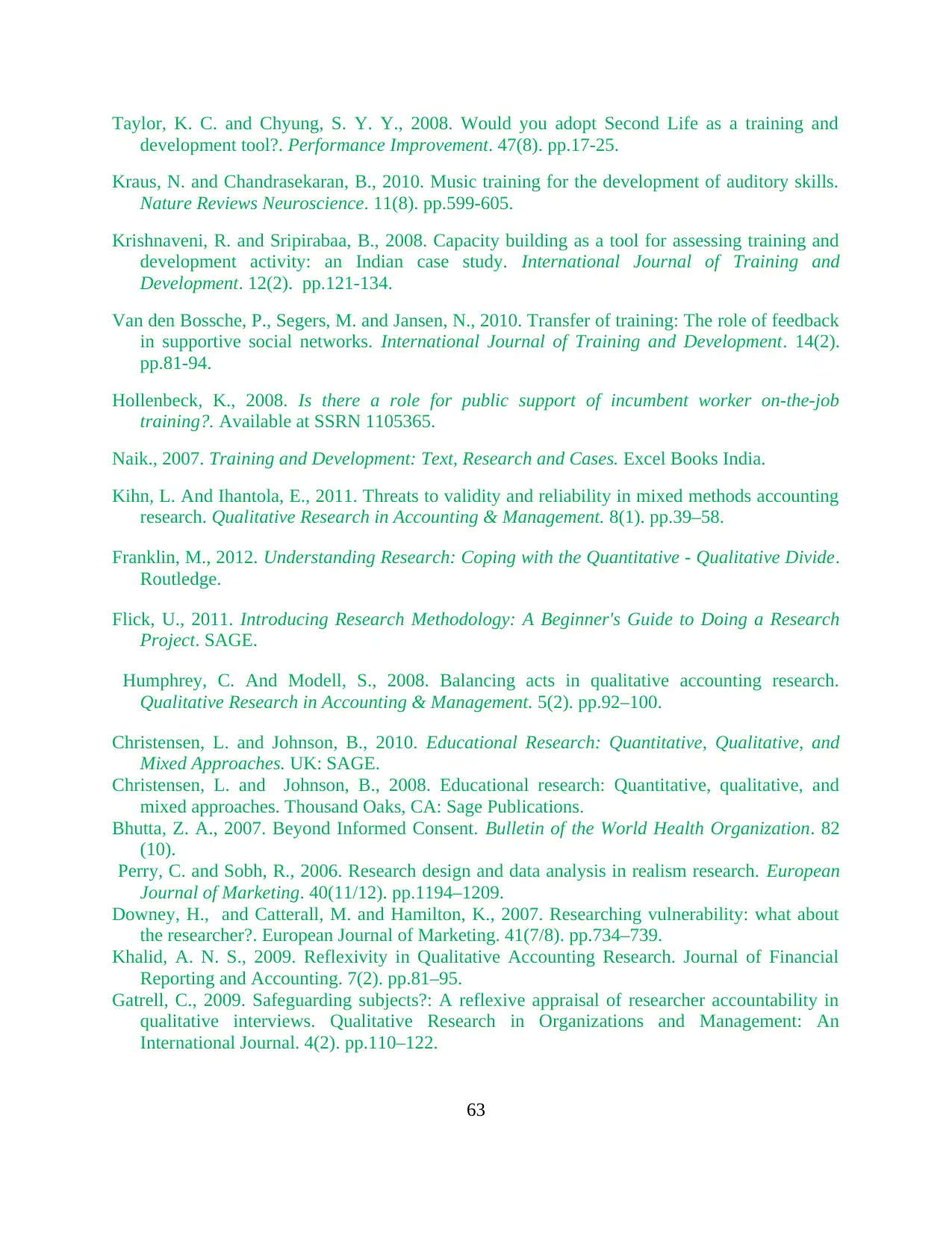
Taylor, K. C. and Chyung, S. Y. Y., 2008. Would you adopt Second Life as a training and
development tool?. Performance Improvement. 47(8). pp.17-25.
Kraus, N. and Chandrasekaran, B., 2010. Music training for the development of auditory skills.
Nature Reviews Neuroscience. 11(8). pp.599-605.
Krishnaveni, R. and Sripirabaa, B., 2008. Capacity building as a tool for assessing training and
development activity: an Indian case study. International Journal of Training and
Development. 12(2). pp.121-134.
Van den Bossche, P., Segers, M. and Jansen, N., 2010. Transfer of training: The role of feedback
in supportive social networks. International Journal of Training and Development. 14(2).
pp.81-94.
Hollenbeck, K., 2008. Is there a role for public support of incumbent worker on-the-job
training?. Available at SSRN 1105365.
Naik., 2007. Training and Development: Text, Research and Cases. Excel Books India.
Kihn, L. And Ihantola, E., 2011. Threats to validity and reliability in mixed methods accounting
research. Qualitative Research in Accounting & Management. 8(1). pp.39–58.
Franklin, M., 2012. Understanding Research: Coping with the Quantitative - Qualitative Divide.
Routledge.
Flick, U., 2011. Introducing Research Methodology: A Beginner's Guide to Doing a Research
Project. SAGE.
Humphrey, C. And Modell, S., 2008. Balancing acts in qualitative accounting research.
Qualitative Research in Accounting & Management. 5(2). pp.92–100.
Christensen, L. and Johnson, B., 2010. Educational Research: Quantitative, Qualitative, and
Mixed Approaches. UK: SAGE.
Christensen, L. and Johnson, B., 2008. Educational research: Quantitative, qualitative, and
mixed approaches. Thousand Oaks, CA: Sage Publications.
Bhutta, Z. A., 2007. Beyond Informed Consent. Bulletin of the World Health Organization. 82
(10).
Perry, C. and Sobh, R., 2006. Research design and data analysis in realism research. European
Journal of Marketing. 40(11/12). pp.1194–1209.
Downey, H., and Catterall, M. and Hamilton, K., 2007. Researching vulnerability: what about
the researcher?. European Journal of Marketing. 41(7/8). pp.734–739.
Khalid, A. N. S., 2009. Reflexivity in Qualitative Accounting Research. Journal of Financial
Reporting and Accounting. 7(2). pp.81–95.
Gatrell, C., 2009. Safeguarding subjects?: A reflexive appraisal of researcher accountability in
qualitative interviews. Qualitative Research in Organizations and Management: An
International Journal. 4(2). pp.110–122.
63
development tool?. Performance Improvement. 47(8). pp.17-25.
Kraus, N. and Chandrasekaran, B., 2010. Music training for the development of auditory skills.
Nature Reviews Neuroscience. 11(8). pp.599-605.
Krishnaveni, R. and Sripirabaa, B., 2008. Capacity building as a tool for assessing training and
development activity: an Indian case study. International Journal of Training and
Development. 12(2). pp.121-134.
Van den Bossche, P., Segers, M. and Jansen, N., 2010. Transfer of training: The role of feedback
in supportive social networks. International Journal of Training and Development. 14(2).
pp.81-94.
Hollenbeck, K., 2008. Is there a role for public support of incumbent worker on-the-job
training?. Available at SSRN 1105365.
Naik., 2007. Training and Development: Text, Research and Cases. Excel Books India.
Kihn, L. And Ihantola, E., 2011. Threats to validity and reliability in mixed methods accounting
research. Qualitative Research in Accounting & Management. 8(1). pp.39–58.
Franklin, M., 2012. Understanding Research: Coping with the Quantitative - Qualitative Divide.
Routledge.
Flick, U., 2011. Introducing Research Methodology: A Beginner's Guide to Doing a Research
Project. SAGE.
Humphrey, C. And Modell, S., 2008. Balancing acts in qualitative accounting research.
Qualitative Research in Accounting & Management. 5(2). pp.92–100.
Christensen, L. and Johnson, B., 2010. Educational Research: Quantitative, Qualitative, and
Mixed Approaches. UK: SAGE.
Christensen, L. and Johnson, B., 2008. Educational research: Quantitative, qualitative, and
mixed approaches. Thousand Oaks, CA: Sage Publications.
Bhutta, Z. A., 2007. Beyond Informed Consent. Bulletin of the World Health Organization. 82
(10).
Perry, C. and Sobh, R., 2006. Research design and data analysis in realism research. European
Journal of Marketing. 40(11/12). pp.1194–1209.
Downey, H., and Catterall, M. and Hamilton, K., 2007. Researching vulnerability: what about
the researcher?. European Journal of Marketing. 41(7/8). pp.734–739.
Khalid, A. N. S., 2009. Reflexivity in Qualitative Accounting Research. Journal of Financial
Reporting and Accounting. 7(2). pp.81–95.
Gatrell, C., 2009. Safeguarding subjects?: A reflexive appraisal of researcher accountability in
qualitative interviews. Qualitative Research in Organizations and Management: An
International Journal. 4(2). pp.110–122.
63

Amaratunga, D. and et.al., 2002. Quantitative and qualitative research in the built environment:
application of “mixed” research approach. Work Study. 51(1). pp.17–31.
Melville, S. and Goddard, W., 2004. Research Methodology: An Introduction. Juta and Company
Ltd.
Bhattacharyya, K. D., 2009. Research Methodology. Excel Books India.
Online
UK hotel growth set to continue into 2016. 2016 [Online]. Available through:
<http://www.bighospitality.co.uk/Business/UK-hotel-growth-set-to-continue-into-2016>.
[Accessed on 20th February 2016].
UK hotels forecast 2016 - Growth is in the air. 2016. [Online]. Available through:
<http://www.pwc.co.uk/industries/hospitality-leisure/uk-hotels-forecast.html>. [Accessed on
20th February 2016].
Inductive or Deductive? Two Different Approaches. 2016. [Online]. Available through:
<http://catalog.flatworldknowledge.com/bookhub/reader/3585?e=blackstone_1.0-ch02_s03>.
[Accessed on 22nd February 2016].
64
application of “mixed” research approach. Work Study. 51(1). pp.17–31.
Melville, S. and Goddard, W., 2004. Research Methodology: An Introduction. Juta and Company
Ltd.
Bhattacharyya, K. D., 2009. Research Methodology. Excel Books India.
Online
UK hotel growth set to continue into 2016. 2016 [Online]. Available through:
<http://www.bighospitality.co.uk/Business/UK-hotel-growth-set-to-continue-into-2016>.
[Accessed on 20th February 2016].
UK hotels forecast 2016 - Growth is in the air. 2016. [Online]. Available through:
<http://www.pwc.co.uk/industries/hospitality-leisure/uk-hotels-forecast.html>. [Accessed on
20th February 2016].
Inductive or Deductive? Two Different Approaches. 2016. [Online]. Available through:
<http://catalog.flatworldknowledge.com/bookhub/reader/3585?e=blackstone_1.0-ch02_s03>.
[Accessed on 22nd February 2016].
64
Paraphrase This Document
Need a fresh take? Get an instant paraphrase of this document with our AI Paraphraser
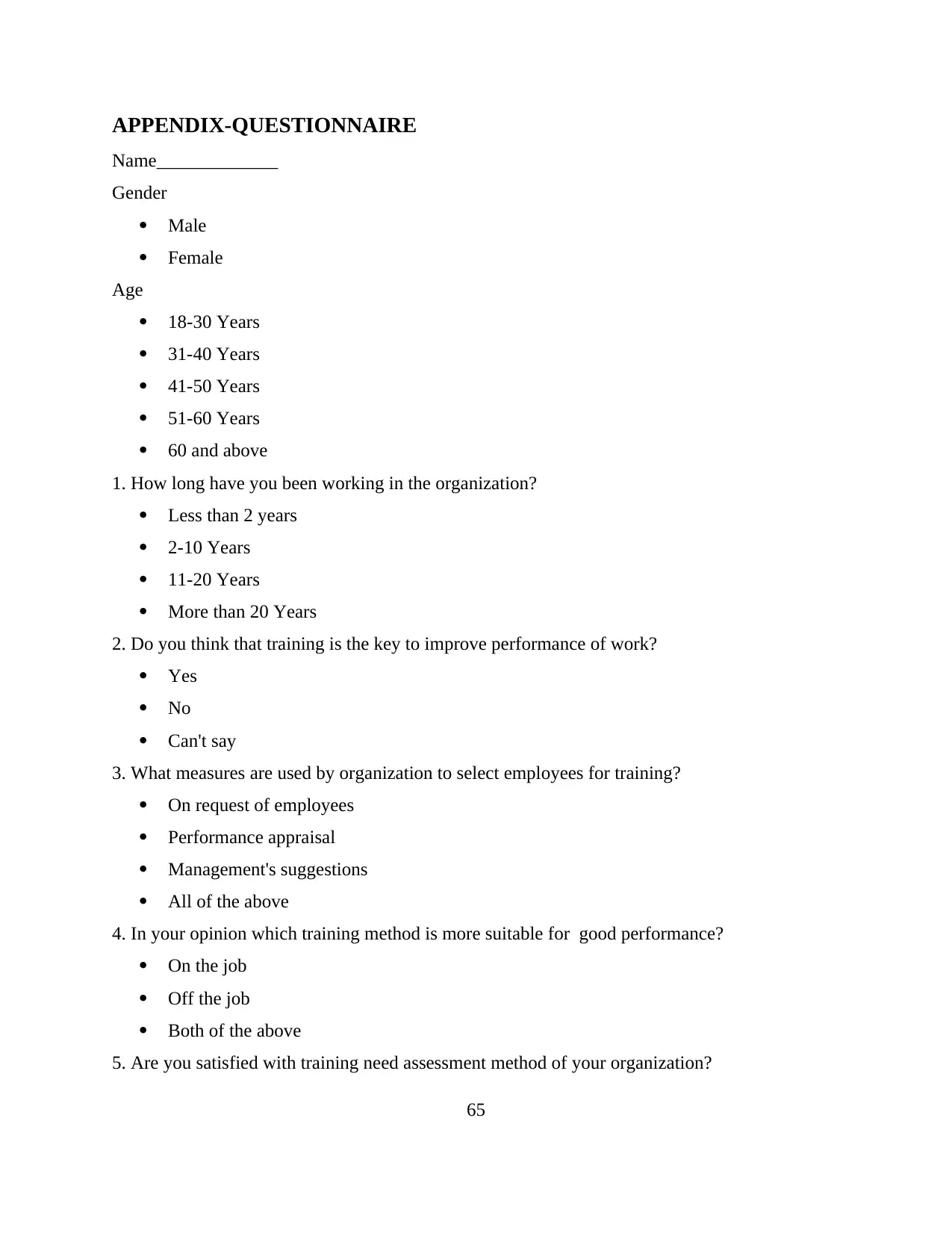
APPENDIX-QUESTIONNAIRE
Name_____________
Gender
Male
Female
Age
18-30 Years
31-40 Years
41-50 Years
51-60 Years
60 and above
1. How long have you been working in the organization?
Less than 2 years
2-10 Years
11-20 Years
More than 20 Years
2. Do you think that training is the key to improve performance of work?
Yes
No
Can't say
3. What measures are used by organization to select employees for training?
On request of employees
Performance appraisal
Management's suggestions
All of the above
4. In your opinion which training method is more suitable for good performance?
On the job
Off the job
Both of the above
5. Are you satisfied with training need assessment method of your organization?
65
Name_____________
Gender
Male
Female
Age
18-30 Years
31-40 Years
41-50 Years
51-60 Years
60 and above
1. How long have you been working in the organization?
Less than 2 years
2-10 Years
11-20 Years
More than 20 Years
2. Do you think that training is the key to improve performance of work?
Yes
No
Can't say
3. What measures are used by organization to select employees for training?
On request of employees
Performance appraisal
Management's suggestions
All of the above
4. In your opinion which training method is more suitable for good performance?
On the job
Off the job
Both of the above
5. Are you satisfied with training need assessment method of your organization?
65

Highly satisfied
Satisfied
Neutral
Dissatisfied
Highly dissatisfied
6. How often do you attend training program?
Frequently
Quarterly
Half yearly
Once in year
Rarely
7. Do you agree that different training you received were helpful in enhancing work related
skills?
Strongly agree
Agree
Neutral
Disagree
Strongly disagree
8. Do you agree that training have assisted you to improve effciency of work?
Strongly agree
Agree
Neutral
Disagree
Strongly disagree
9. How effective is on-the-job training? rate according to experience.
Outstanding
Excellent
Good
Average
66
Satisfied
Neutral
Dissatisfied
Highly dissatisfied
6. How often do you attend training program?
Frequently
Quarterly
Half yearly
Once in year
Rarely
7. Do you agree that different training you received were helpful in enhancing work related
skills?
Strongly agree
Agree
Neutral
Disagree
Strongly disagree
8. Do you agree that training have assisted you to improve effciency of work?
Strongly agree
Agree
Neutral
Disagree
Strongly disagree
9. How effective is on-the-job training? rate according to experience.
Outstanding
Excellent
Good
Average
66
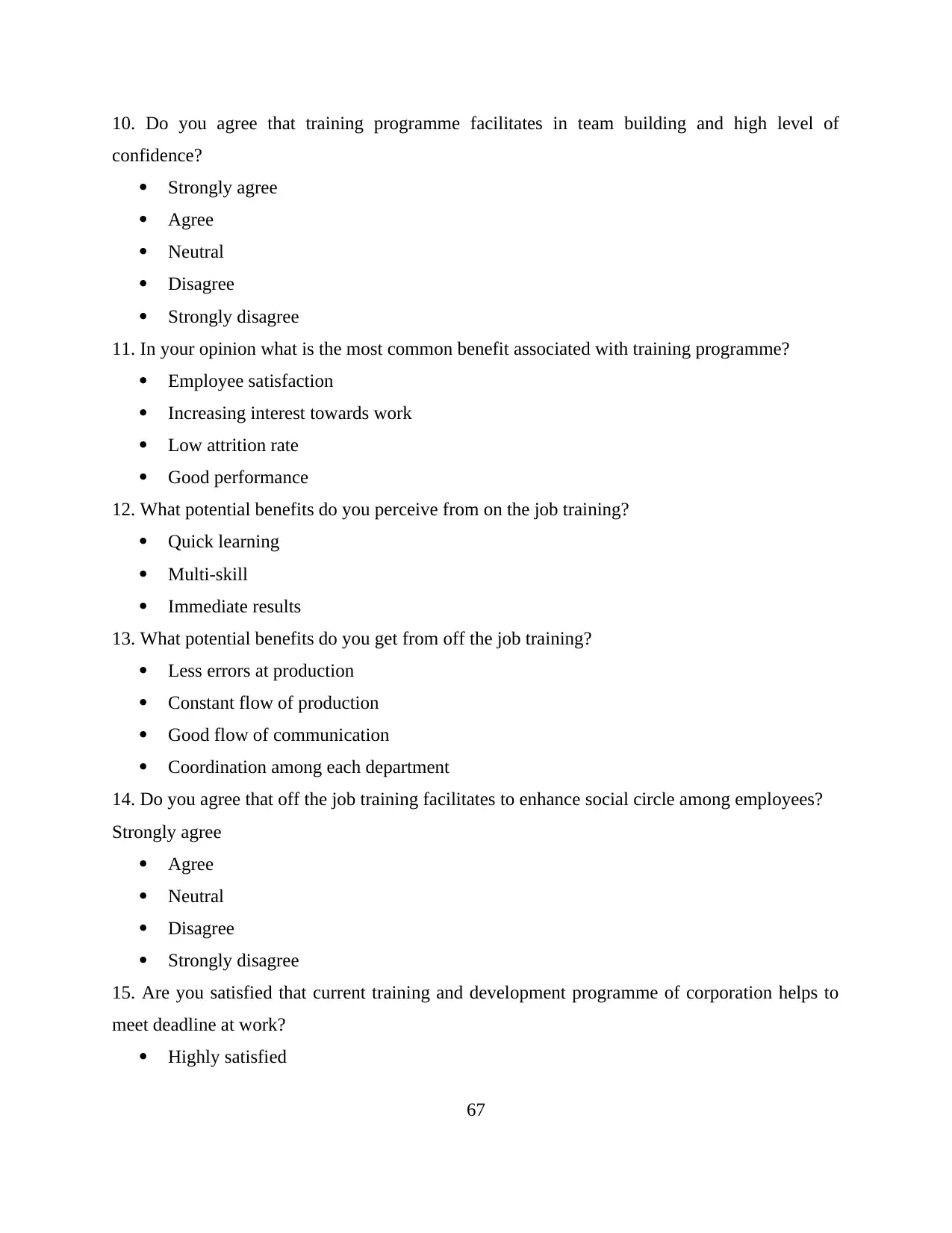
10. Do you agree that training programme facilitates in team building and high level of
confidence?
Strongly agree
Agree
Neutral
Disagree
Strongly disagree
11. In your opinion what is the most common benefit associated with training programme?
Employee satisfaction
Increasing interest towards work
Low attrition rate
Good performance
12. What potential benefits do you perceive from on the job training?
Quick learning
Multi-skill
Immediate results
13. What potential benefits do you get from off the job training?
Less errors at production
Constant flow of production
Good flow of communication
Coordination among each department
14. Do you agree that off the job training facilitates to enhance social circle among employees?
Strongly agree
Agree
Neutral
Disagree
Strongly disagree
15. Are you satisfied that current training and development programme of corporation helps to
meet deadline at work?
Highly satisfied
67
confidence?
Strongly agree
Agree
Neutral
Disagree
Strongly disagree
11. In your opinion what is the most common benefit associated with training programme?
Employee satisfaction
Increasing interest towards work
Low attrition rate
Good performance
12. What potential benefits do you perceive from on the job training?
Quick learning
Multi-skill
Immediate results
13. What potential benefits do you get from off the job training?
Less errors at production
Constant flow of production
Good flow of communication
Coordination among each department
14. Do you agree that off the job training facilitates to enhance social circle among employees?
Strongly agree
Agree
Neutral
Disagree
Strongly disagree
15. Are you satisfied that current training and development programme of corporation helps to
meet deadline at work?
Highly satisfied
67
Secure Best Marks with AI Grader
Need help grading? Try our AI Grader for instant feedback on your assignments.
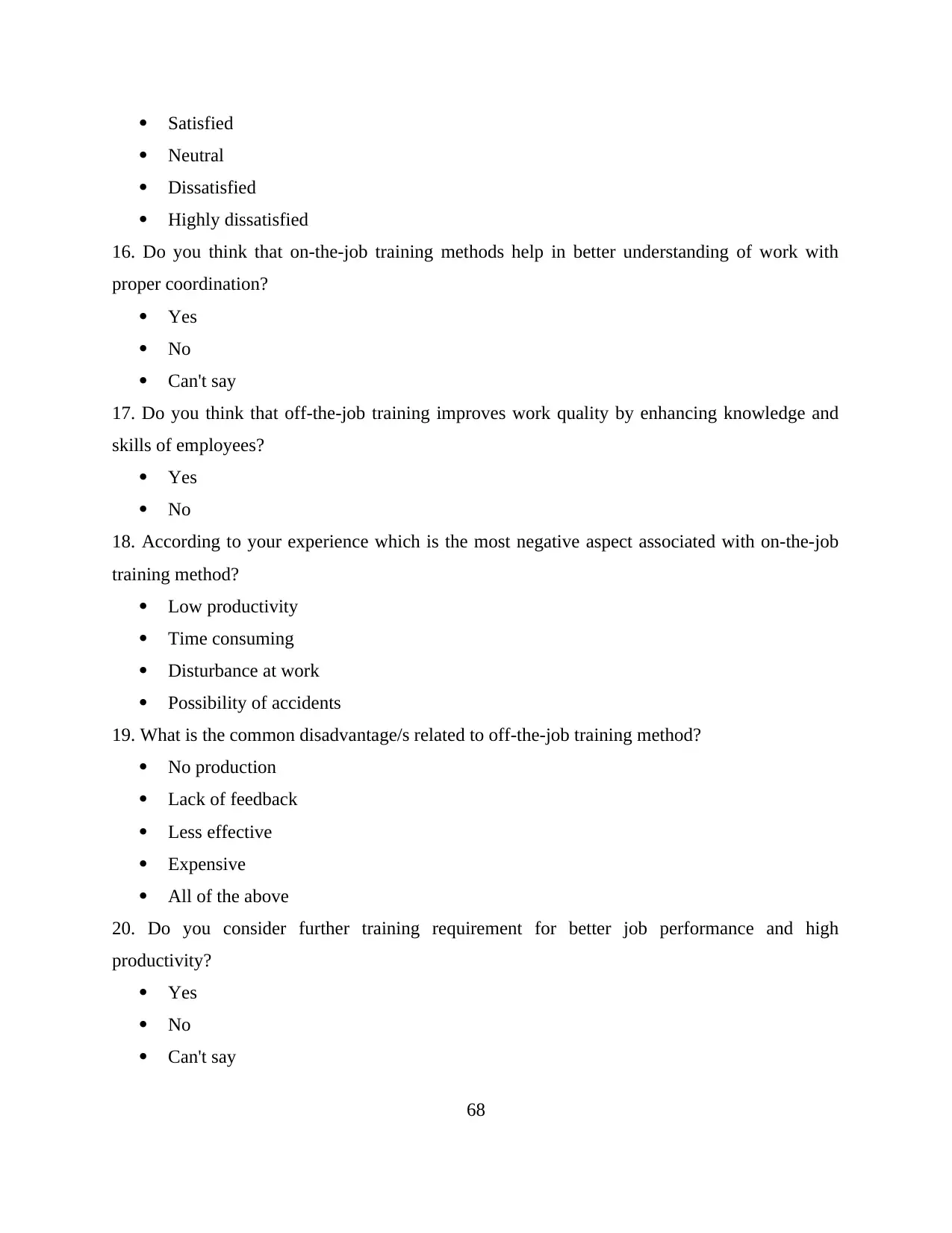
Satisfied
Neutral
Dissatisfied
Highly dissatisfied
16. Do you think that on-the-job training methods help in better understanding of work with
proper coordination?
Yes
No
Can't say
17. Do you think that off-the-job training improves work quality by enhancing knowledge and
skills of employees?
Yes
No
18. According to your experience which is the most negative aspect associated with on-the-job
training method?
Low productivity
Time consuming
Disturbance at work
Possibility of accidents
19. What is the common disadvantage/s related to off-the-job training method?
No production
Lack of feedback
Less effective
Expensive
All of the above
20. Do you consider further training requirement for better job performance and high
productivity?
Yes
No
Can't say
68
Neutral
Dissatisfied
Highly dissatisfied
16. Do you think that on-the-job training methods help in better understanding of work with
proper coordination?
Yes
No
Can't say
17. Do you think that off-the-job training improves work quality by enhancing knowledge and
skills of employees?
Yes
No
18. According to your experience which is the most negative aspect associated with on-the-job
training method?
Low productivity
Time consuming
Disturbance at work
Possibility of accidents
19. What is the common disadvantage/s related to off-the-job training method?
No production
Lack of feedback
Less effective
Expensive
All of the above
20. Do you consider further training requirement for better job performance and high
productivity?
Yes
No
Can't say
68

21. If “Yes” in above question, kindly state the
reasons________________________________________________________________________
_________________________________
22. Please specify regarding issues you faced regarding training and development at you
organization, if
any___________________________________________________________________________
_________
23. Specify the alternatives ways through which improvement can be taken in training and
development programme of your
organization____________________________________________________________________
____________________________________-
69
reasons________________________________________________________________________
_________________________________
22. Please specify regarding issues you faced regarding training and development at you
organization, if
any___________________________________________________________________________
_________
23. Specify the alternatives ways through which improvement can be taken in training and
development programme of your
organization____________________________________________________________________
____________________________________-
69
1 out of 69
Related Documents
Your All-in-One AI-Powered Toolkit for Academic Success.
+13062052269
info@desklib.com
Available 24*7 on WhatsApp / Email
![[object Object]](/_next/static/media/star-bottom.7253800d.svg)
Unlock your academic potential
© 2024 | Zucol Services PVT LTD | All rights reserved.





